Visiting the Siegfried Line – 5 Locations You MUST See

The Siegfried Line near Wallendorf is probably the best spot to dive into the Battle of the Bulge in Luxembourg. The defensive structures around the village are part of a 630km defensive line full of pillboxes, tank traps and other stuff. I travelled to Wallendorf to see some of these defenses. Around the village you can find signs with information. These are part of a historical circuit made by the Luxembourg government.
A. The first location that I visited was the B-werk type bunker on top of the hill at Wallendorf. The category B stands for the thickness of the bunker. This bunker was fitted with concrete walls of at least 1.5m thick. Making it practicaly impossible for anything to go through. The people of Wallendorf even say that Hitler visited this spot in 1938. Strategicaly the bunker had a clear view of the the Sauer River valley. From there you could look straight into Luxembourg and have eyes on the lines where on Dec 16th 1944 the 28th Infantry Division was Dug in.

B. The next stop was downhill at the little German War Cemetery. Here you’ll find the graves of young german men that gave their lives while defending their fatherland between September 1944 and February 1945. The cemetery is on the way to the center of the village and is well worth taking a look at. I believe that seeing things from different perspectives help you understand the war just a ‘little’ more. There’s a total of 312 graves here from soldiers of various units such as the 212th, 276th and 352nd Volks Grenadier Division.

C. From the cemetery I continued towards the center of the village and from there in the direction of Gentingen. At a little crossroad, still in Wallendorf, there’s another bunker that’s disguised from the public. All you can see is the little gun port and the big sign in front of it. This C-Werk bunker was one of the first built here in the line of defenses. It was used as a listening post between the months of September 1944 and December 1945.

D. The next bunker is further down the road between Ammeldingen and Gentingen. On your way to Gentingen you’ll spot a bunker on the right watching over river banks of the Our river. This B-Werk bunker has a bigger gun port and officialy was equiped with a 37mm Anti-Tank gun. However, after the 1940s campaign most bunkers of the Siegfried line were stripped of their armament and used elsewhere. Fastforward four years the Germans had a hard time arming the bunkers. War material was scarce and lots of weapons had been upgraded and didn’t fit the pillboxes anymore. The Siegfried Line never proved to be a succesful defensive line. It was more of a psychological defense.

E. There’s one more spot back on the road to Ammeldingen. From the bunker you want to head back in that direction, but stop your car at the first road that leads into the forest. Upon entering the forest you’ll immediately find a German trench that was likely used here at the start of the Battle of the Bulge. Friedrich Schmäschke, a 17 year old private in the 916th Grenadier Regiment was in this area at the night before the Offensive. I can only imagine what it must’ve been like for him to be here at that time.
If you want more in-depth information on these battle sites, watch the video I created below!
I also made a map with the route lined out so that it’s easier for you to navigate to these locations. They are pointen out from A to E. I hope you’ll have an interesting time visiting the area. History may never be forgotten!

Share this:
- Click to share on Twitter (Opens in new window)
- Click to share on Facebook (Opens in new window)
- Click to share on Pinterest (Opens in new window)
- Click to print (Opens in new window)
- Click to share on Reddit (Opens in new window)
- 80th division wallendorf
- german pillbox
- siegfried line
- siegfried line battle of the bulge
- siegfried line ww2
- wallendorf 1944
- wallendorf 1944 bunkers
- wallendorf 1945
- wallendorf battle of the bulge
- wallendorf bunkers
- wallendorf german bunkers
- wallendorf german pillbox
- wallendorf pillbox
- wallendorf siegfried line
- wallendorf westwall
- wallendorf ww2
Joey van Meesen
3 thoughts to “ visiting the siegfried line – 5 locations you must see ”.
Thank you for sharing this story and photographs of the Siegfried Line . This gives us a real visual view of the battlefield and the terrain . My dad used to mention the German “Pillboxes” often when he was describing the battles that he took part in , while serving in the 5th. Infantry Division in Europe.
Very informative and also enjoyed the video. I am planning a trip to Europe next July and will definitely try to check out some of the locations. Will be driving from Munich to see the Ludendorff Bridge and some of the Dragon’s teeth near Aachen on our way through Malmedy and Bastogne. Any suggestions as to conditions during mid July?
Hallo Joey Helaas in het Nederlands. Zie onder de link naar de “wandeling”Gentingen Wallendorf waarin opgenomen de aan deze route gelegen westwall bunkers. De genoemde bunker bij bord 14 ) het staat wel in de tekst maar dat klopt niet) is geen B werk maar een Regelbau 23
Groeten Bunkervos http://www.bunkervos.nl
Leave a comment Cancel reply
Your email address will not be published. Required fields are marked *
Save my name, email, and website in this browser for the next time I comment.
Notify me of follow-up comments by email.
Notify me of new posts by email.
Recent Comments
- Michael on American Ambulance Strafed By American P-47
- Joey van Meesen on Who Is The Running Paratrooper?
- David Moreau on Who Is The Running Paratrooper?
- KY on Who Is The Running Paratrooper?
- Bronson on Who Is The Running Paratrooper?
- Öffnungszeiten und Preise
- Unterstützen Sie uns
- Virtual Tour
- 103rd Division
- Abstract from the 125th Amored Engineer Battalion
- 14th AD March 1945 Attack on Oberotterbach and Steinfeld
- Datenschutz / Impressum
- 1945 Aus Chroniken und Büchern
- Tipps für Schulklassen
- Westwall Links

Welcome to the Municipal WWII Siegfried Line Museum at Bad Bergzabern
A forgotten Hero When planning your trip from our museum to the Maginot Line in France. You might consider to to drive a few extra miles to find the location where Charles L. Thomas fought in December of 1944. He fought for the liberation of France.
On December 14, 1944, Thomas led a task force storming Climbach , consisting of a platoon from the 756th Tank Battalion and a reinforced company of the 411th Infantry Regiment, 103rd Infantry Division , led by a platoon of his tank destroyers. Approaching Climbach, Thomas' armored scout car was knocked out by enemy fire and he was wounded. The lieutenant helped his crew out of the vehicle, but as he left the car's protection, he was again wounded in the chest, legs and arms. Despite his wounds, Thomas directed the dispersal and emplacement of the anti-tank guns, which then returned fire and covered the attempt by the rest of the task force to outflank the defenders. He briefed one of his platoon leaders, a junior lieutenant, on the general situation, and only when he was sure the situation was under control did he allow himself to be evacuated. The platoon continued to fight for four hours, losing two of its four guns and half its men as casualties (3 dead, 17 wounded). The strong performance of the platoon ensured the capture of the town and forced the defenders to withdraw to the Siegfried Line ; the unit was awarded a Distinguished Unit Citation (the first black combat unit, and the first unit attached to the 103rd Division, to be so honored) and its men received four Silver Stars and nine Bronze Stars . Thomas himself was awarded the Distinguished Service Cross for his part in the engagement, and returned home a hero, though he played down his role – "I know I was sent out to locate and draw the enemy fire, but I didn't mean to draw that much." Thomas remained in the Army, and retired with the rank of Major. In the 1990s, following a study which indicated severe racial discrimination in the process of awarding medals during the war, it was recommended that seven Distinguished Service Crosses be upgraded to Medals of Honor, and Thomas was awarded the Medal of Honor posthumously on January 13, 1997.
Externe Inhalte
Die an dieser Stelle vorgesehenen Inhalte können aufgrund Ihrer aktuellen Cookie-Einstellungen nicht angezeigt werden.
Diese Webseite bietet möglicherweise Inhalte oder Funktionalitäten an, die von Drittanbietern eigenverantwortlich zur Verfügung gestellt werden. Diese Drittanbieter können eigene Cookies setzen, z.B. um die Nutzeraktivität zu verfolgen oder ihre Angebote zu personalisieren und zu optimieren.
Cookie-Einstellungen
Diese Webseite verwendet Cookies, um Besuchern ein optimales Nutzererlebnis zu bieten. Bestimmte Inhalte von Drittanbietern werden nur angezeigt, wenn die entsprechende Option aktiviert ist. Die Datenverarbeitung kann dann auch in einem Drittland erfolgen. Weitere Informationen hierzu in der Datenschutzerklärung.
Touring a WWII German Nazi Bunker – Siegfried Line Westwall Museum
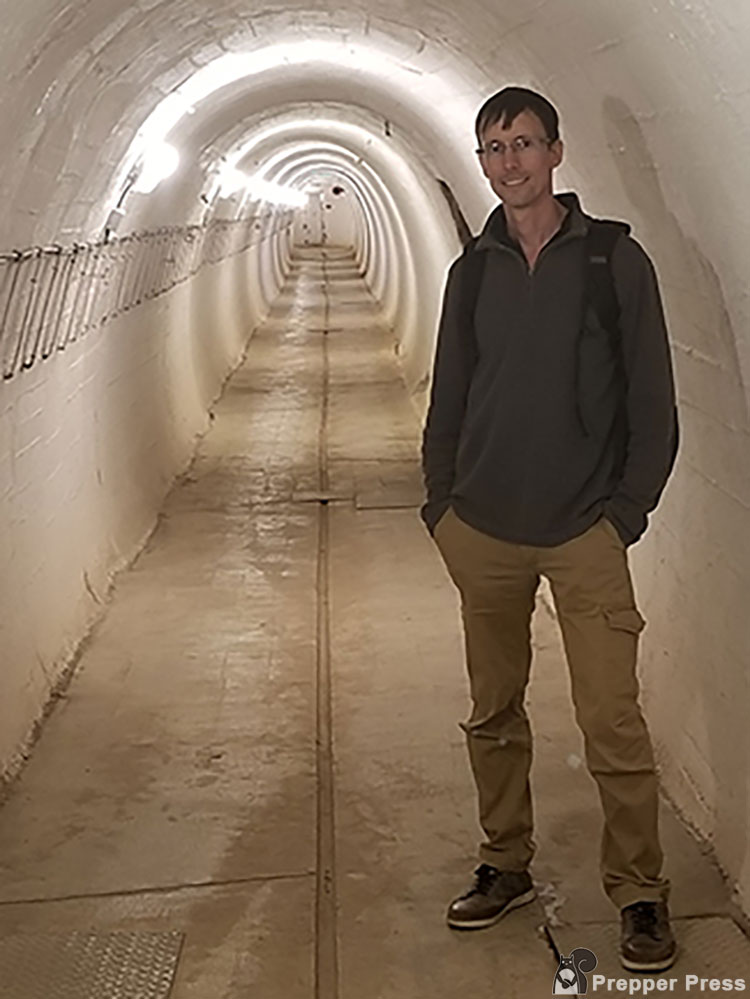
I just returned from a trip to Germany where I had the opportunity to get get a private tour of a WWII German Nazi bunker.
I went to visit family who live right along the Luxembourg border, so naturally I requested a quick drive over to Irrel, Germany, to the Westwall Museum. I was fortunate in that my mother knew a caretaker of the museum who allowed us inside for a private tour.
History of this German Nazi Bunker
This is a World War II German Nazi bunker that was part of Germany’s Siegfried Line . Otherwise known as the Westwall, the Siegfried Line was a defensive line built during the 1930s opposite the French Maginot Line. From September 1944 to March 1945, the Westwall was subject to a large-scale Allied offensive.
According to the official Westwall Museum Irrel website:
From 1936 (officially from 1938) a “protection line” was built to protect the German West Border, consisting of bunkers, tank ranks, trenches and barbed wire barriers. This line stretched from north of the Lower Rhine to the south below Basel over a length of 630 km and was named “Westwall” during the course of the construction period.
The museum is maintained by Irrel’s volunteer fire department, and they’ve done a great job restoring it. The museum is only open to casual visitors on Sundays and during public holidays in the summer. We were fortunate in that we had a family friend who opened it up to give us a private tour.
Inside the Bunker
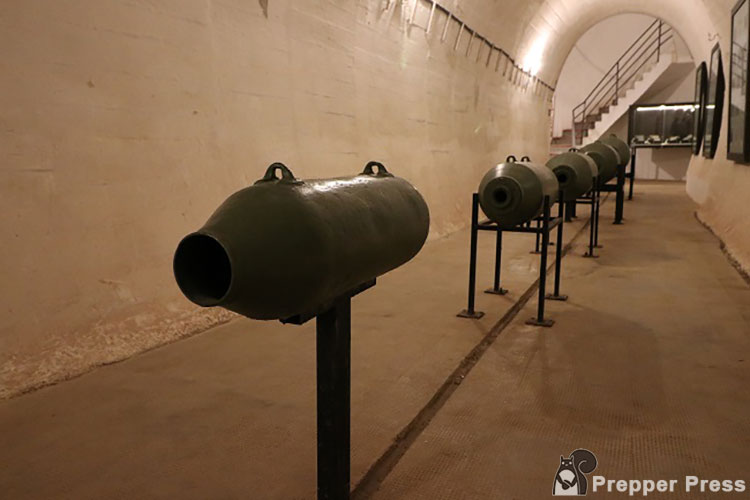
The bunker was constructed with 2 meter (6.5′) thick concrete walls. Both of the upper floors were divided into 45 rooms of different sizes, including troop quarters, guard rooms, gunnery rooms, first-aid stations, supply rooms, a cold storage room, kitchen, and a radio station.
Two diesel generators supplied the power to run the ventilation system, water pump, heating, and lighting. The lowest floor contained the water pump room with a 180 meter-deep well. The Irrel bunker was heavily damaged in 1947 during the French occupation. The local volunteers began digging it out in 1976.
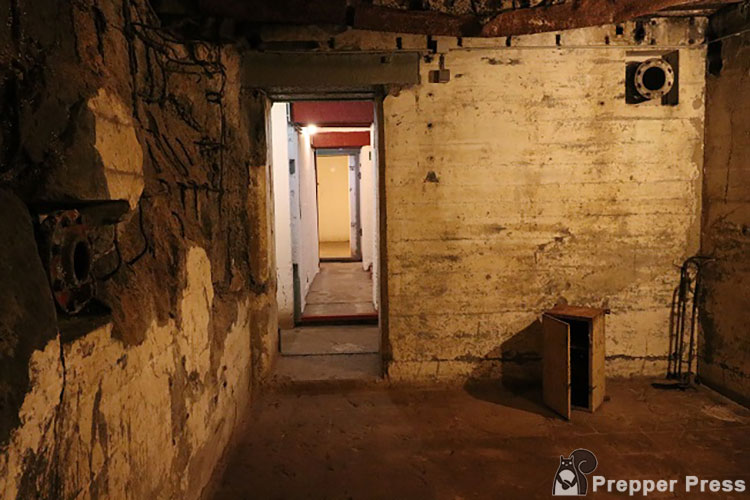
The following picture is a display of WWII era gas masks. This was a bunk room, as you can see against the back wall. Officers had more comfortable metal mesh that their beds were made from. Everyone else had bunks that were woven with rope.
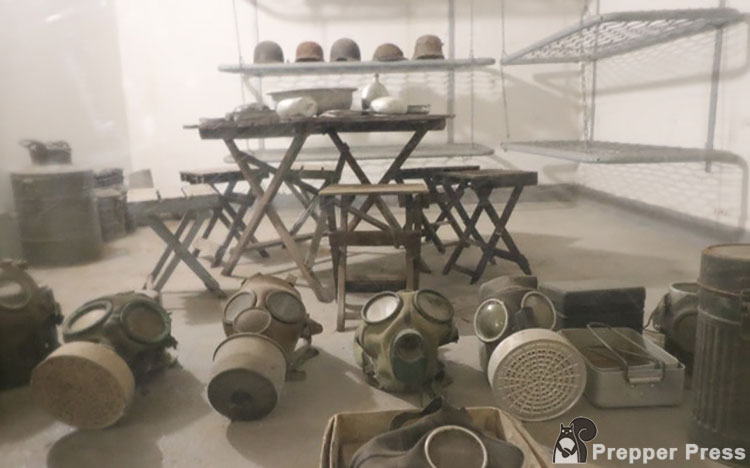
The volunteers set out various shell casings, ammo cans, and random equipment that they uncovered as they excavated the site.
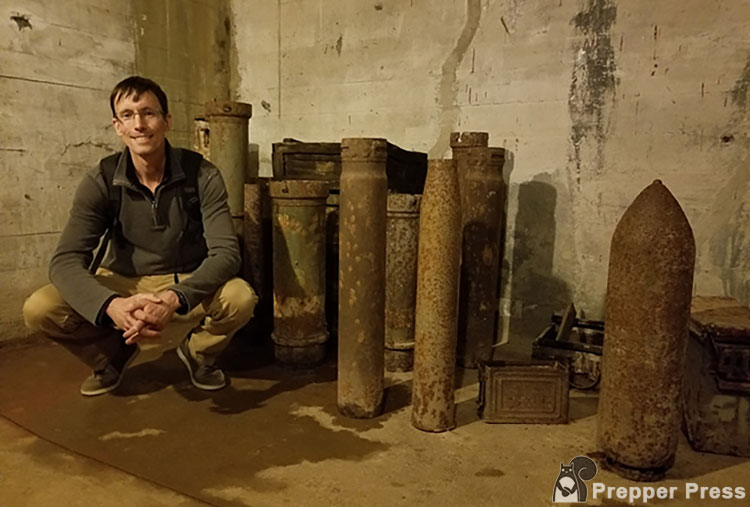
Today, the only electricity running in the bunker is for the lights. There is no active ventilation system. When I asked how the air was getting down there, our guide didn’t know. They haven’t figured it out, so there must be some passive system that is still working.
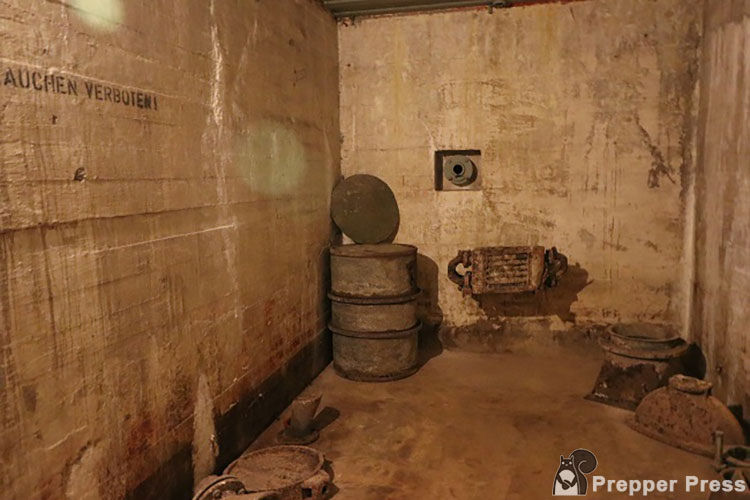
The air down there was very cool. During its operation, the bunker was heated. There was a sink still intact, but there was no washroom in the bunker, just an old space near the top where any soldiers that were exposed to gas attacks could be hosed down.
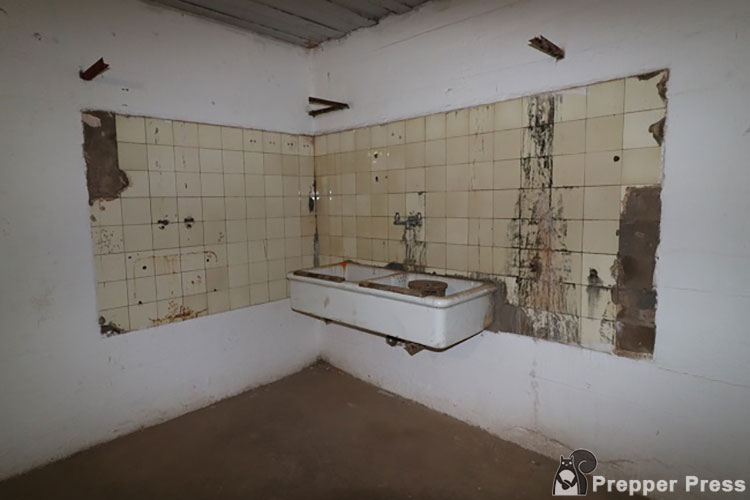
The bunker could be defended from different firing positions, including two gun turrets with six firing holes for machine guns, a 500mm grenade thrower, and a flame thrower. A watch turret was used for observation and artillery shooting commands.
Outside the Bunker
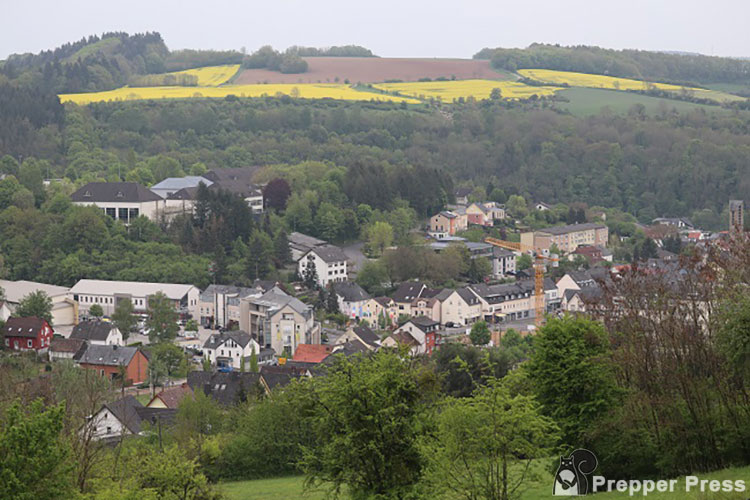
Irrel, Germany is not near most tourist destinations in Germany, but if you find yourself nearby for some reason, or you’re in Luxembourg next door, consider a Sunday drive over to the museum and see it for yourself. It’s a rare piece of German World War II history that you can walk through.
Lessons Learned From Firefighting in Rural America
What to do in a boil water advisory order, leave a comment cancel reply.
Save my name, email, and website in this browser for the next time I comment.
Notify me when juicy new comments are added.
As an Amazon associate, we earn from qualifying purchases. This site also participates in various other affiliate programs, and we may get a commission through purchases made through our links. Please read our complete Disclosures and Privacy Policy for more information.
This site uses cookies to improve your experience. You can opt-out if you wish. Accept Read More

Siegfried Line Museum

From Good Friday to 31 October every 2nd and 4th Sunday and all holidays.
New opening hours: 11:00 to 17:00
Winter break from November 1st to Good Friday of the following year!
A C H T U N G
During this time the toilets are not available!
Eintrittspreise
Erwachsene 4,00
Kinder 8-13 Jahre 3,00
Kurkarte, Rheinpfalzcard 3,00
Pfalzcard kostenlos
Museumsführung incl. Eintritt
Erwachsene 6,00
Kinder 5,00
Schulklassen p.P. 3,00
Geführte Rundgänge für Gruppen und Schulklassen sind ganzjährig ab einer Anzahl von 15 Personen
oder einem Festbetrag von € 96,00 buchbar.
Coordinates
Recommendations nearby.
Easy mountain bike tour around the spa town of Bad Bergzabern. Easy, long trails and a spectacular rock passage are the highlights of this tour!
Good views! This is what makes the Petronella Rhine Cycle Route so impressive. The varied tour leads from the wine-growing region on the edge of ...
The final stage of the Weinsteig trail takes us through thick forests from Bad Bergzabern past the picturesque village of Dörrenbach, also known as ...
Die letzte Etappe des Pfälzer Mandelpfads führt von Bad Bergzabern über Oberotterbach nach Schweigen-Rechtenbach an das Deutsche Weintor.
Der Pfälzer Mandelpfad führt zwischen schönen Wegen voller Mandelbäumen von Bad Bergzabern nach Siebeldingen.
Entlang der Weinstraße mit herrlichen Ausblicken über die Rheinebene. Teilweise kurze stärkere Anstiege, sonst eben und durchgehend befestigt.
Nearby Points of Interest
- Ort mit vielen Mandelbäumen
- Klinikum Landau SÜW - Standort Bad Bergzabern
- Metzgerei Kieffer
- Bad Bergzabern Castle
- Bad Bergzabern
Questions and answers
Would you like to ask the author a question?
Ratings and reviews
Help others by being the first to add a review

Photos from others
- Show images Hide images
- 6 Routes nearby
- Facebook en-gb
- Twitter en-gb
- Youtube en-gb
- Instagram en-gb
- Linkedin en-gb
- Nature in Wallonia
- Wallonia: Land of Water
- Surprising Wallonia
- Trekking, hiking & walking
- Food and drink
- Cycling holidays
- Sports activities
- Heritage and culture
- Sustainable holidays
- With a loved one
- Travelling with reduced mobility
- Holidaying with my dog
- Staying in Wallonia
- Motorhomes & vanlife
- Bed & Breakfast
- Youth hostels and gîtes in Wallonia
- Holiday Parks
- Eco-labelled accommodation
- Reduction vouchers
- Museums and attractions
- Events calendar
- Flea markets
- Visit'Entreprise
- Walloon towns and cities
- City guides
- Villages of Wallonia
- The Belgian Ardennes
- Touristic information
- VISITWallonia info.shop
- Before you leave
- VISITWallonia be pass
- Siegfried Line
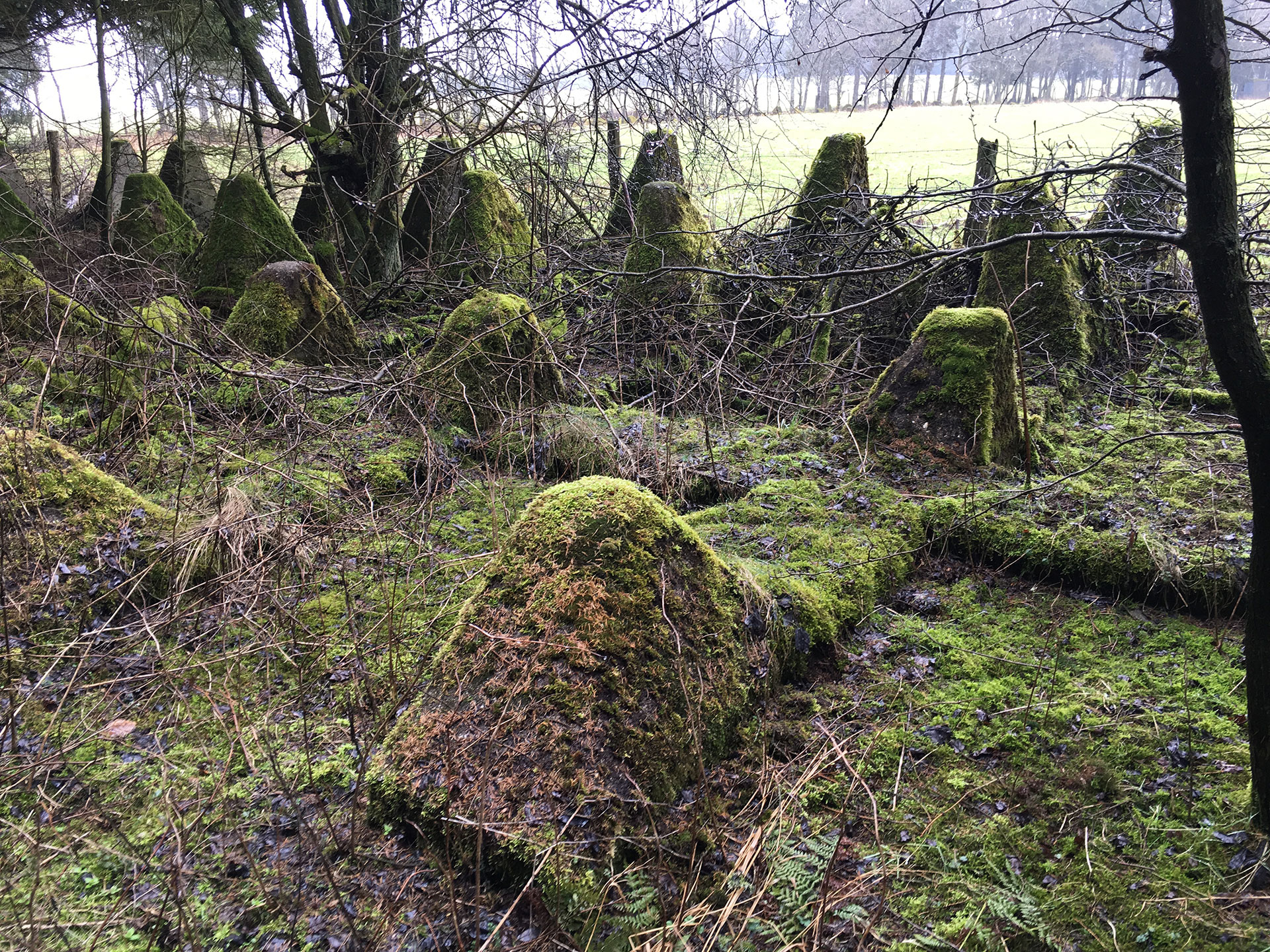
La Gleize – Royal Tiger Tank & Museum

Wallonia in the Wars
#VISITWallonia
World war two.
Please accept marketing-cookies to watch this video.
Share your best memories of Wallonia by tagging us on social media
- - K-town Now
- Asia-Pacific
- - Storm Tracker
- Middle East
- Map of Memorials
- Entertainment
- - Video Games
- Europe Travel
- - Quick Trips
- - After Hours
- Pacific Travel
- The Meat and Potatoes of Life
- U.S. Travel
- Storm Tracker
- Rewards for readers
- Get Stripes
- Stripes Lite
- Archives/Library
- Special Publications
- Mobile Apps
- Email Newsletters
- Digital Access
- Home Delivery
- Marine Corps
- Coast Guard
- Space Force
- Archive photo of the day
- - Schedules Europe
- - Scoreboards Europe
- - Schedules Pacific
- - Scoreboards Pacific
- - Pacific Sports Blog
- - Military Matters
- - Force for Hire
- Out of Uniform
- Communities
- Stripes Europe
- Stripes Guam
- Stripes Japan
- Stripes Korea
- Stripes Okinawa
- Our Other Websites
- In Memoriam
- Month of the Military Child
- Best of Germany
- Best of the Pacific
- Letters to Santa
Exploring the traces of Germany's Siegfried Line
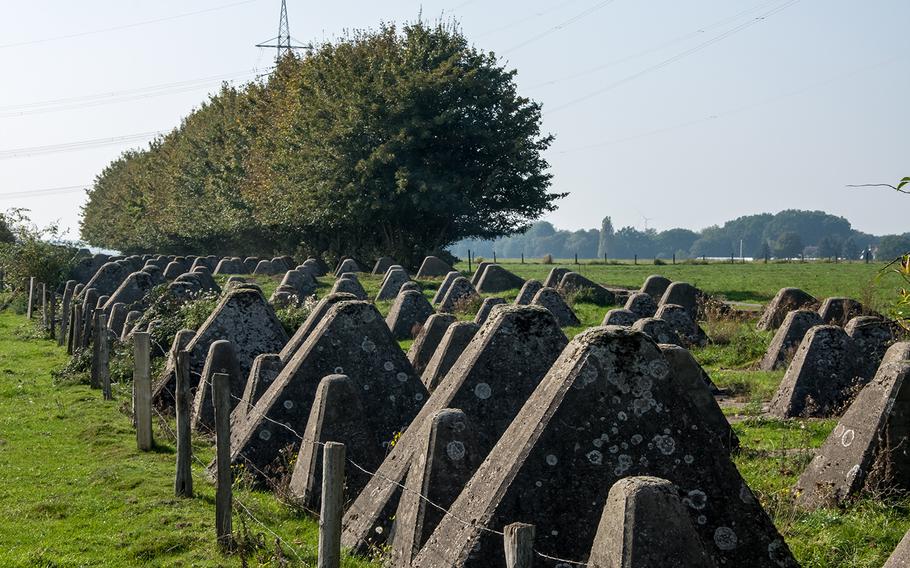
The Siegfried Line’s distinctive “dragon’s teeth” anti-tank obstacles delineate this portion of the World War II defense system in Germany. (Getty Images/iStockphoto)
The Siegfried Line was a World War II German defensive system stretching some 390 miles along the western border of the old German Empire. Referred to as the Westwall by the Germans, it ran from Kleve, on the border with the Netherlands, to the town of Weil am Rhein, near the Swiss border in the south.
Built between 1938 and 1940 upon Adolf Hitler’s plans and roughly opposite to the French Maginot Line, the defensive line built in part by vast numbers of forced laborers was made up of some 18,000 bunkers, tunnels, trenches, tank traps and other fortifications. Although it had a role to play in Nazi propaganda, the first real action along its length came about as a consequence of Allied advancement following the D-Day landings. On Aug. 24, 1944, Hitler gave a directive for renewed construction on the Siegfried Line, and from September 1944 to March 1945, the Siegfried Line was subject to a large-scale Allied offensive.
Although much of the wall has been purposefully obliterated, pieces of it still stand, from concrete pillbox bunkers to the anti-tank obstacles known as dragon’s teeth. Since 1997, under the banner of “Der Denkmalswert des Unerfreulichen” (The Value of the Unpleasant as a Memorial), efforts have been made to preserve the remains of the Siegfried Line as a historical monument. Here are some places where the stories of those who built, fought and died along its way can still be heard. (Note that museums remain closed for the time being; times given reflect non-pandemic operating hours.)
North Rhine-Westphalia The first clashes along the Siegfried Line began in August of 1944, with fighting concentrated in the Eifel region’s Hürtgenwald (Hürtgen Forest) some 12 miles southeast of Aachen. With the Aachen Gap a logical route into Germany's Rhineland and a major industrial area, it stood to reason for the Germans to mass their defenses here. By some estimates, around 24,000 of the approximately 120,000 American troops and reinforcements to fight in the Battle of Hürtgen Forest lost their lives in battle, with thousands more succumbing to injuries later on. The German death toll is thought to number around 12,000.
The “Hürtgenwald 1944 and in Peace” is a volunteer-run museum that documents the death and destruction associated with the fierce battle through exhibits of items from both German and American troops recovered from the forest, backed up by photos, films and newspaper clippings and further bolstered by first-hand witness accounts. The museum located in Hürtgenwald-Vossenack is open from 10 a.m.-5 p.m. on Sundays between March and November; entry costs 5 euros. museum-huertgenwald.de
Other things to see nearby include the Vossenack church, the site of fierce fighting, and a cemetery for the German soldiers fallen in war. Visits to the Field Hospital Bunker Simonskall can be arranged by the above-mentioned museum. The Kall Bridge Trail in Schmidt has a poignant history. Burgberg, Castle Hill in English, in Bergstein, also known as Hill 400, is topped by an observation tower offering sweeping views of the forest; a pair of bunkers are also nearby. Online: tinyurl.com/w5aappzj
Saarland Just to the northwest of the famous bend in the Saar River known as the Saarschliefe, a circular walking trail winds through a well-preserved section of the wall made up of numerous dragon’s teeth. The freely accessible site is located along the L177 highway between Orscholz and Oberleuken. Online: tinyurl.com/45t9ezj2
Rhineland-Palatinate The Westwall Museum Irrel, near the Luxembourg border, is housed in a Siegfriend Line bunker built to secure the main connecting road between Cologne and Luxembourg. It stood out for its thick walls of reinforced concrete, up to two meters thick on the exterior, which were classed as “B” walls. The museum illustrates how a crew of 84 would have manned this fortress and includes a first aid station, ammunition storage room, canteen, kitchen, radio station, ventilation system and much more across three levels underground. Admission to this volunteer-run museum, open on Sundays only, costs 3 euros for adults and one euro for children. Online: westwallmuseum-irrel.de/en
The Siegfried Line Museum at Pirmasens, located on the outskirts of the village of Niedersimten, lies underground in what used to be the fortifications of the enormous bunker-like Gerstfeldhöhe. Vaulted galleries blasted out of solid rock stretch over half a mile. The system was used by the U.S. Army as a vehicle warehouse until the early 1990s. A 1.5 hour guided tour passes by weaponry, military equipment, reconstructed soldiers’ quarters and scrawled messages left by American soldiers. The museum is open 1 p.m.-5 p.m. Saturdays and Sundays from April to October. Entry costs 8 euros adults, 6 euros for children and is free for ages five and under. Online: westwall-museum.de
The Westwallmuseum Bad Bergzabern, housed in two old artillery bunkers, holds relics and documents from photographs to maps and military equipment. Much of what is displayed here represents the bunkers’ original contents. The museum is open 10 a.m.-4 p.m. on Sundays only; entry costs 4 euros adults, 3 euros for ages 8-13 and is free for ages seven and under. Online: otterbachabschnitt.de
The area surrounding Bad Bergzabern bears other traces of the section of the Siegfried Line referred to as the Otterbachabschnitt. Along the so-called Westerwallweg, an eight-mile trail leading through the small communities of Oberotterbach, Niederotterbach and Steinfeld, one can find other remains of the line, including the remains of bunkers, dragon’s teeth and wet and dry tank traps. The 36 information boards along the route provide context to the sights. Download the pdf flyer at Online: tinyurl.com/4p7fjzvs
Baden-Württemberg A working group of the historical society in Bietigheim-Bissingen maintains a restored Ro 1-type bunker at the Neckar-Enz position featuring a reconstruction of four of its original rooms, including a gas-lock chamber. The museum is open 11 a.m.-5 p.m. on the first Sunday of the month in April, July and September. Online: tinyurl.com/5bcyyymw
Sign Up for Daily Headlines
Sign up to receive a daily email of today's top military news stories from Stars and Stripes and top news outlets from around the world.
Sign Up Now
Please enter at least 3 characters
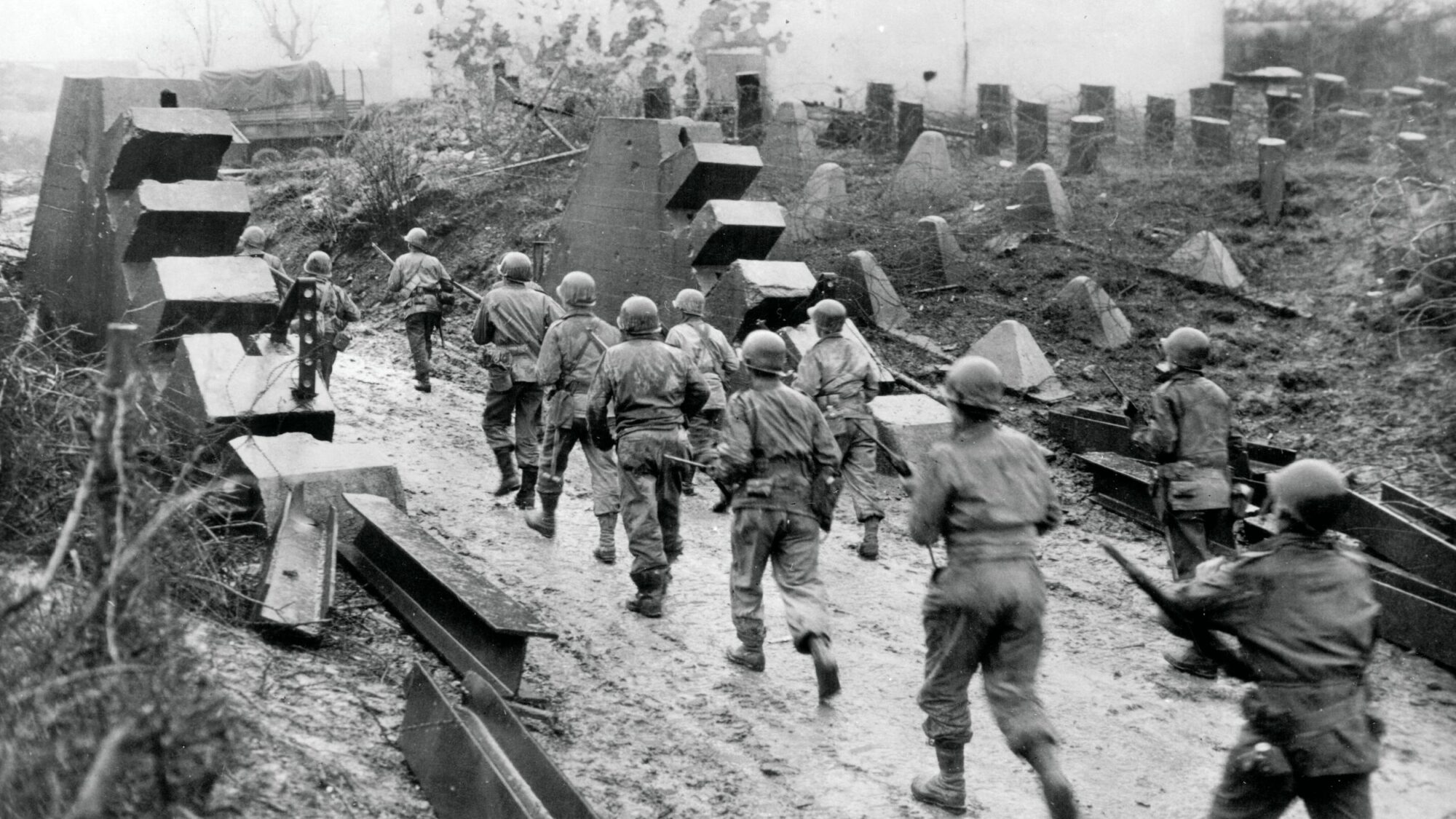
Siegfried Line: Breaking the Dragon’s Teeth
The 70th Infantry Division was assigned a tough mission—crack the vaunted Siegfried Line guarding Germany’s border.
This article appears in: Summer 2023
By Allyn Vannoy
As the battalion officers surveyed the terrain before them, they must have been worried about the men who would have to cross it—the 300 yards of open ground to the banks of the Saar River lined with barbed-wire, concrete pillboxes, anti-vehicle “dragon’s teeth,” and reinforced with minefields in depth known as the Westwall or, more commonly, the “Siegfried Line.”
In March 1945, the Third Reich was under tremendous pressure as the Western Allies, having survived the Battle of the Bulge, were bulldozing toward Berlin.
Moving across the northeast corner of France toward the Rhine River, Lt. Gen. Alexander Patch’s Seventh U.S. Army was operating on the right (southern) flank of George Patton’s Third Army. The 70th Infantry Division, part of the Seventh Army’s XXI Corps, faced the Siegfried Line from Saarbrücken down to the Rhine River at Lauterbourg.
The Seventh Army’s Operation Undertone called for all three of its corps to move against the line. The main effort was to be made by XV Corps, in the center, at Zweibrücken, some 20 miles east of Saarbrücken. The XXI Corps, on the left, and VI Corps, on the right flank of Seventh Army, were to provide support. The 70th’s job was to exert pressure on Saarbrücken’s defenders, keeping them in place.
Formed in 1943 at Camp Adair, Oregon, the 70th Infantry Division adopted the nickname “Trailblazers,” with a shoulder patch showing an ax head over a mountain and an evergreen tree. The division had only arrived in the ETO in mid-December 1944, by way of Marseille, France; in January, it helped blunt the Germans’ Operation Nordwind in the Alsace-Lorraine region.
The villages south of the Saar River, to be assaulted by the 70th Division, represented the outer defenses of Germany’s fortified Westwall. The line, which had been started in 1936 by Nazi Germany’s Organisation Todt, the same engineering-construction group that had built the autobahns, stretched 390 miles—from Germany’s border with Holland to Switzerland. Hundreds of thousands of forced laborers worked on the line that Hitler was sure would be impregnable.
Saarbrücken, Germany, on the border with France, was the hub of the line along the 70th Division’s sector to the front. The 70th’s 274th Infantry Regiment, in the center of the division front, and the 276th Infantry, on the left flank, were to push the enemy back beyond the Saar, using direct fire to deal with pillboxes and bunkers, and then make an assault crossing.
High command pressed Major General Allison Barnett, the 70th’s commander, to attack without delay. Barnett passed the order to Colonel Samuel Conley, 274th Infantry commander, who in turn selected Lt. Col. Fred Cantrell’s 1st Battalion to lead the 274th in its attack. An advance beyond the Saar depended on cracking the Westwall and securing the highway to Metz as part of a strategic route into the Reich.
On March 9, Sergeant Patrick Barry, A Company, 274th Infantry Regiment, informed Sergeant Clyde W. Hill that their platoon had orders to move forward from the French town of Stiring-Wendel, about five miles southwest of Saarbrücken, until they made contact with the enemy; if they ran into a delaying force, they were to continue on until they had encountered enough to stop them.
Their platoon left Stiring-Wendel at 2 a.m. equipped with an SCR-300 radio—a backpack-mounted unit called a “walkie talkie”—with orders to contact company headquarters every 30 minutes. They moved past the Simon Mine, a large ore-processing complex, and advanced to the edge of the woods. When they radioed this information back to A Company headquarters, they were told that the regiment had issued orders for them to keep moving as fast as possible.
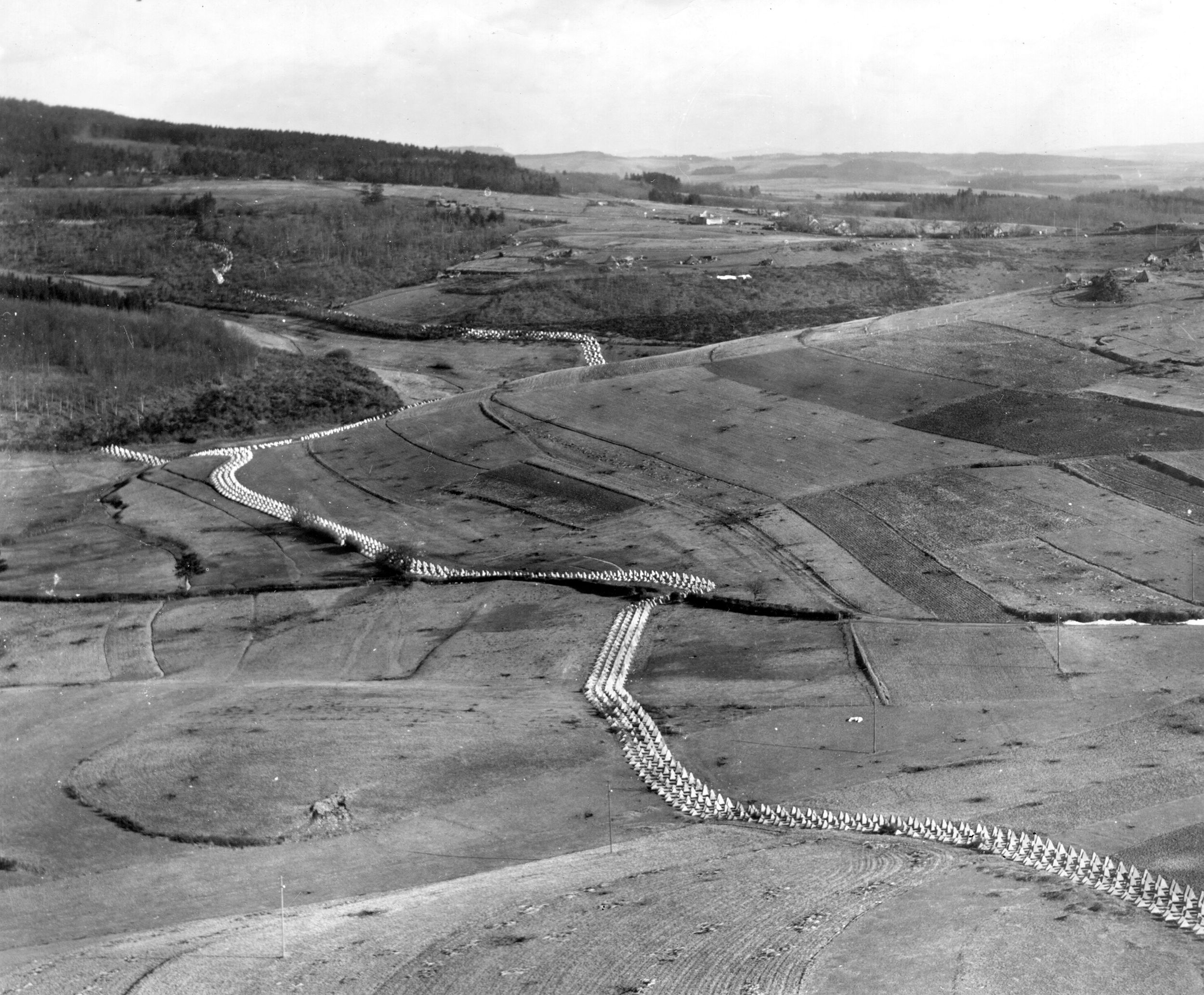
By this time Sergeant Hill and his platoon were well in front of the rest of the company. They advanced through woods, barbed-wire entanglements, and around abandoned German positions. They finally stopped at daybreak.
Once the rest of A Company had caught up, the platoons formed skirmish lines—3rd Platoon to the right, 1st on the left, with 2nd in support. The 3rd Platoon had advanced about 400 yards when its scouts spotted German troops on the distant banks of the Saar. The Americans dug in and kept their eyes on the enemy.
Meanwhile, the 3rd Platoon, B Company, had had orders to move to positions on the forward slope of the ridge just to the right of Stiring-Wendel overlooking the Metz Highway. They moved out at dusk in a squad column on the road leading into Stiring-Wendel, turned off on a curve, and proceeded out onto the ridge through the woods where they dug in.
While placing his men, Sergeant Edward Dunn told Privates James Moore and Vince DiFano to take a position in a former German trench. Moore jumped in the trench and landed on something soft. Moore told DiFano he thought it was a pile of trash. He felt around and caught hold of a foot, and then, seeing what it was, dropped it. He came bolting out, telling DiFano that they should move away as there was a dead soldier there.
Houses on the outskirts of Saarbrücken could be seen far off in front of B Company. Nearer to their right front, to the right of the town of Habsterdick, halfway between Saarbrücken and Stiring-Wendel, was a thick pine forest. Immediately in front of their positions ran the Metz Highway and about 800 yards across a flat open field lay Habsterdick, on the French-German border. Less than a mile to the southwest was Stiring-Wendel. Some distance away was a high railroad embankment. In the center of their position, a few yards to their front, was a small cemetery.
Habsterdick was situated atop a low hill. Just west of the town, running due north, was a deep valley bounded by high hills through which a small stream ran. To the north was the Saar River, Saarbrücken, and the pillboxes of the Siegfried Line. North of Habsterdick, was a large cement plant and quarry. Railroad tracks from Forbach and Stiring-Wendel, to the southwest, passed alongside the plant and then followed the stream bed up the narrow valley to the Saar. The valley appeared to be a natural approach route, causing the Germans to shell the area almost constantly.

Captain Edwin Mitchell, B Company commander, sent S/Sgt. James Broone, Jr., 2nd Platoon, to see the battalion commander, Colonel Cantrell, and be briefed about a planned raid into the German lines.
When Broone returned to the platoon, he informed the squad leaders that they were going to reconnoiter the terrain between the edge of the woods by the graveyard and the first few houses in Habsterdick. The plan was to occupy the first two houses and then launch an assault under cover of machine-gun and artillery fire. The orders were to complete the assault quickly, taking no prisoners.
Sergeants Broone and “Rhino” Luuko, along with Pfc. John Crozier, examined the terrain, but were not pleased about the company’s prospects. Broone notified Captain Mitchell and was told to await further instructions.
At 5 p.m., as the platoon waited and rested, replacements arrived. The veterans were shocked to see so much clean and complete equipment. The blankets were given special admiration.
B Company received word from battalion that there might be German tanks in Habsterdick, so it was decided to send a daylight patrol from the 1st Platoon to search the houses and barns. S/Sgt. Lloyd Horner, platoon sergeant, was to be in charge. Along with him were Sergeants Joseph Marshall and Robert Huttenhower, and eight privates equipped with an SCR-536 radio—a “handie talkie”—and a bazooka. They were to use their own judgment if they met any opposition—whether to fight or withdraw.
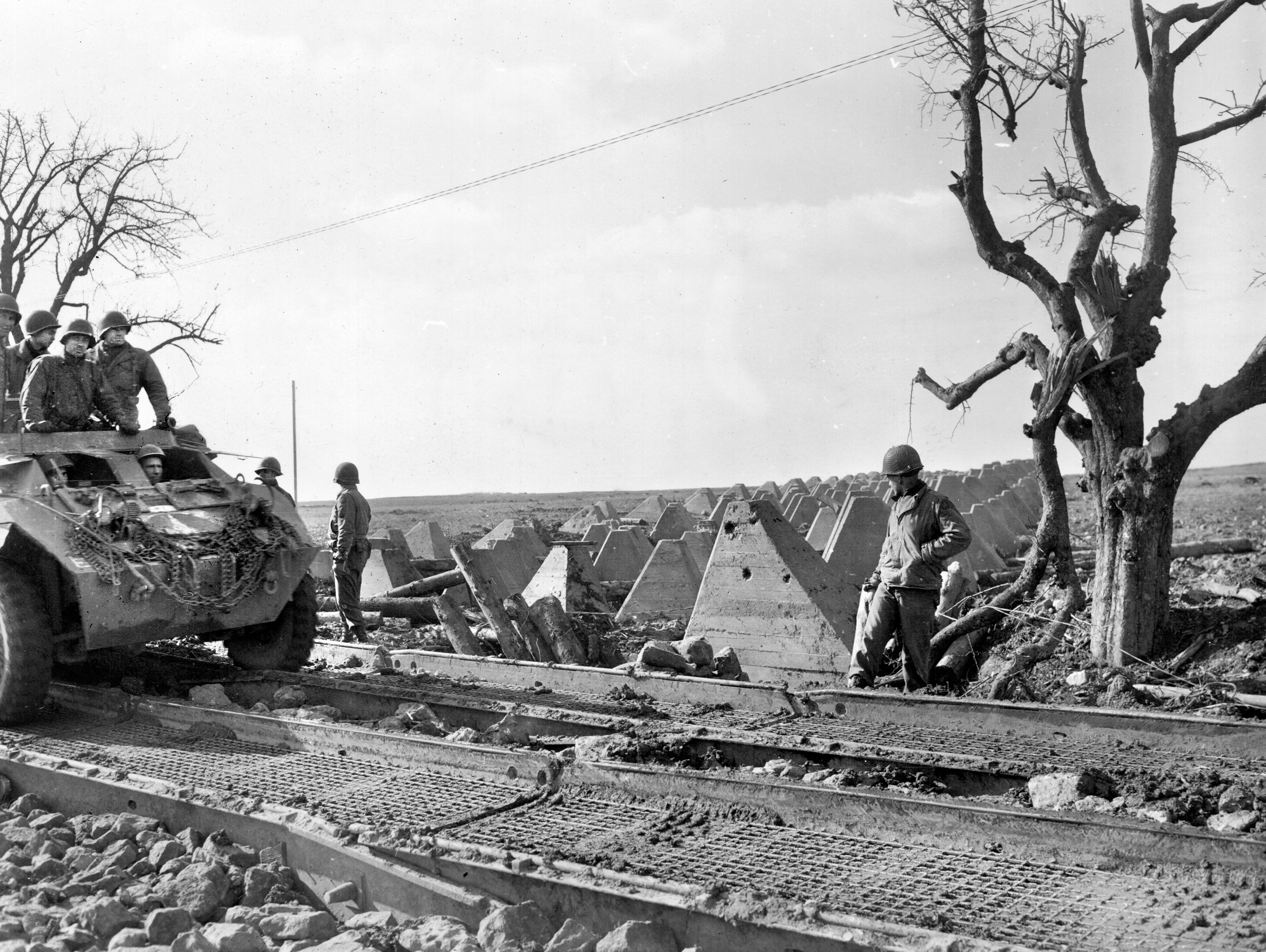
The patrol left at about noon and reached Habsterdick without any opposition. The patrol split into two groups and searched each block, followed by curious women and children. The civilians unlocked doors, let them into cellars, and allowed them to search their homes. They found no German troops.
Most of the civilians encountered said the Germans had left, and that they had been waiting for the Americans to arrive for almost four months. Many houses had been damaged by aerial and artillery bombardment. There was also a large Polish settlement there, with many of the men working in nearby mines.
B Company’s 2nd Platoon then arrived and together the two units moved out to clear the woods to the east of Habsterdick. After they had gone about 400 to 600 yards, they were ordered to dig in in the woods, right on the German border. No opposition had been encountered.
Each squad leader was told to send out a three-man patrol that night to maintain contact with the heavy machine guns that were located approximately 75 yards out on the right flank, and also to keep tabs on the woods that they had come through during the day. The 3rd Platoon arrived in Habsterdick about dusk.
At about 8 a.m. on March 14, Lieutenant Elmo Chappell’s 1st Platoon of B Company left Habsterdick and moved northeast toward Saarbrücken, crossed the German border, then over railroad tracks and a ridge, descended into a draw, and climbed a hill overlooking Saarbrücken.
Suddenly, intense machine-gun fire burst from a series of emplacements at the edge of Saarbrücken—the Siegfried Line. Visible were long rows of anti-vehicle, reinforced-concrete pyramids known as “dragon’s teeth” in front, backed up by a network of pillboxes with interlocking fields of fire.
Captain Edwin Mitchell’s B Company was chosen to spearhead the attack into the German defenses. He recalled. “It was sure suicide to cross the flat fields swept by perfect enemy fire, but orders were orders and we were going to try it.”
At about 9 a.m., B Company’s 1st Platoon passed through the 2nd Platoon. After 300 yards or so they halted, the 2nd Platoon coming up on their left. To their front was a wooded hill. On the left were some houses and behind the houses was a road and then a railroad track.
The 1st Squad was sent to clear the houses while the rest of the platoon waited. The squad was led by Pfc. Jack Hartwright, acting squad leader, along with 10 privates. They searched the houses, but found them empty. The men were ordered to move forward. The squad was sent along the banks of a brook, with a road to their left.
As they moved along the brook, Hartwright saw a German on a nearby hill. Hartwright fired at him, as did the others. Another German appeared from a bunker. As soon as they opened fire on this second man, German machine guns forced the GIs to take cover behind what trees were available.
Private Joseph Greco was hit and hollered for a medic, but the medics were held back by the murderous machine-gun fire. Private Harry Bargy managed to reach Greco and half-carried, half-dragged him back to where the medics were pinned down, but Greco died on the way.
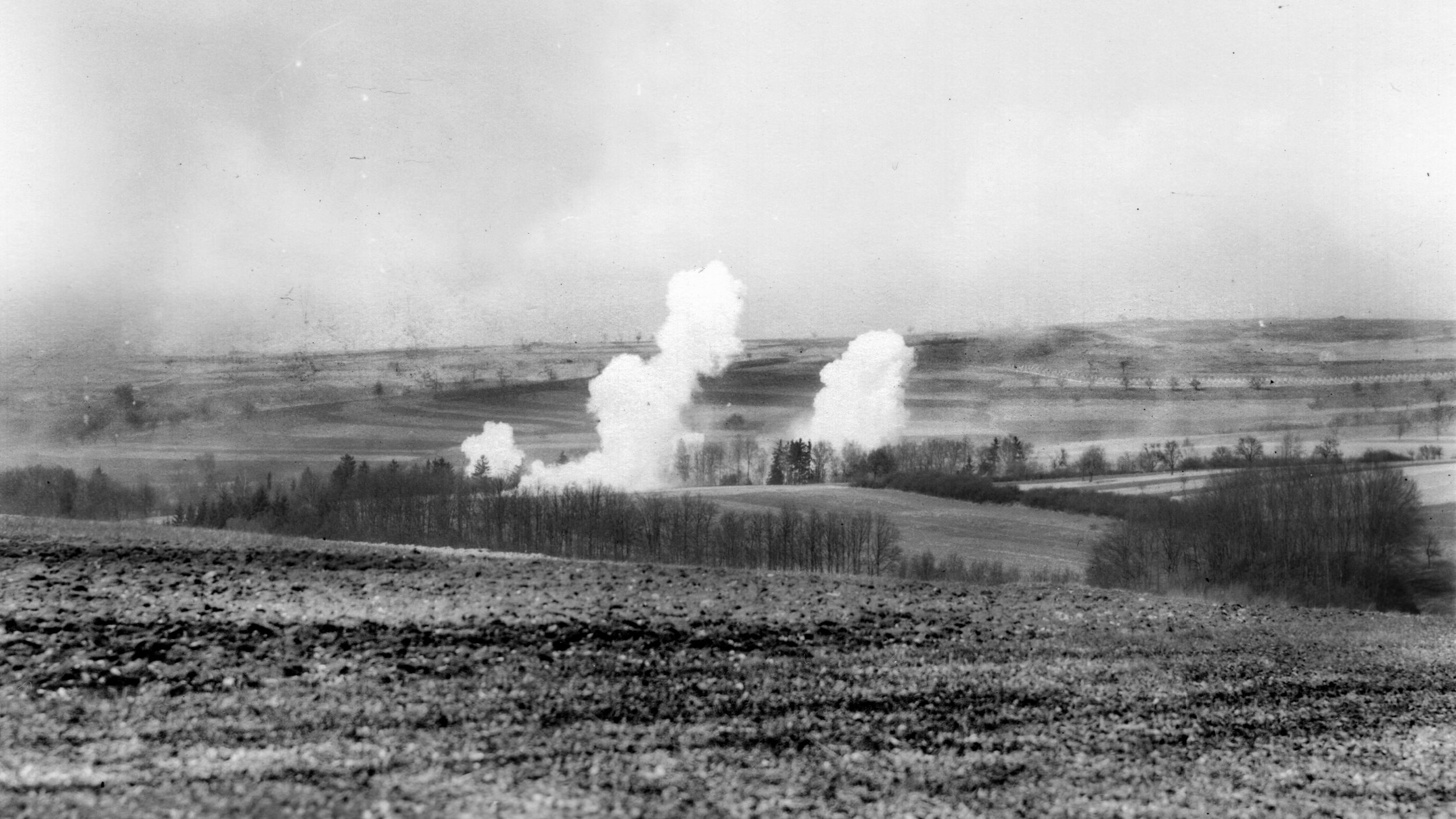
Hartwright was also wounded and started calling for a medic. Bargy told him to crawl up to the road to where he could be helped across. Hartwright made it to the road, but was hit while crossing. Bargy ran to him, picked him up, and carried him down the road on his back, in spite of intense machine-gun fire. (Incredibly, Hartwright was later accused of having self-inflicted his wounds.)
Once he had delivered Hartwright to the medics, Bargy headed back to his squad. Atop the hill, Bargy saw Captain Mitchell and told him what had happened to the 1st Squad. Later, Bargy was hit by a sniper’s bullet that pierced the left side of his helmet, broke his left cheekbone, and lodged in his left shoulder.
In the meantime, Private Daniel Devitt, having taken cover behind a tree, was trying to convince Private James Gurley, who had been hit in the shoulder, that he needed to get back to the medics. When this proved unsuccessful, he told Gurley that he was going for help. Devitt found a medic, but he was involved in dressing Hartwright’s wounds.
In the quiet after a mortar barrage, Hartwright was taken to litter bearers who carried him back to the battalion aid station. Devitt then discovered he had a bullet hole through the sleeve of his own jacket and another through his helmet.
While the 1st Squad had been engaged, the 2nd Squad reached its objective on the left of the 3rd Platoon and saw Germans on the hill to their front. When they and the 1st Squad began firing, they also received intense machine-gun fire in return.
Four Germans were caught in the open and raised their hands to surrender. They started walking towards the Americans when Private Virgil Sherburn, a BAR man, either frightened or over-exuberant, shot at them. He missed as the would-be targets ran under the crest of the hill and disappeared. Rifle grenades were then fired at the far hillside. The 2nd Platoon then dug in at the top of the hill.
B Company’s 3rd Platoon had moved out at 8 a.m. with two squads forward and one following, accompanied by Captain Mitchell. When they reached the railroad track that ran towards Saarbrücken, they stopped for about an hour while Mitchell attempted to make contact with the forward platoons.
Mitchell ordered Sergeant Dunn to make contact with either the 1st or 2nd Platoon and find out if they had met any opposition, but he wasn’t certain of the position of either. Dunn took three privates with him as he headed out. They went about three quarters of a mile before they found the 2nd Platoon digging in. Dunn notified Captain Mitchell.
The 3rd Platoon moved forward again. After a short while, they contacted the rear of the 1st Platoon. When they reached an open field, they skirted it to the right. They went down into a small draw and joined the 1st Platoon on a dirt road leading onto a bare hill overlooking Saarbrücken. The forward elements of the 1st Platoon had been stopped by machine-gun fire from Siegfried Line pillboxes.
Late in the afternoon, the 3rd Platoon, with the 1st Platoon in the woods to their left, moved back into a long winding trench that the Germans had vacated. The 1st and 3rd Platoons’ CPs were in a house about 50 yards behind the trench. Heavy machine guns were set up behind the 3rd Platoon positions covering the right flank. Another section of heavy machine guns, along with the light machine gun and mortar sections, were placed with the 2nd Platoon.
While B Company had been advancing during the day, C Company had also been in motion. On the night of March 13-14, C Company was told that they would be moving to Stiring-Wendel to aid A Company in its attack.
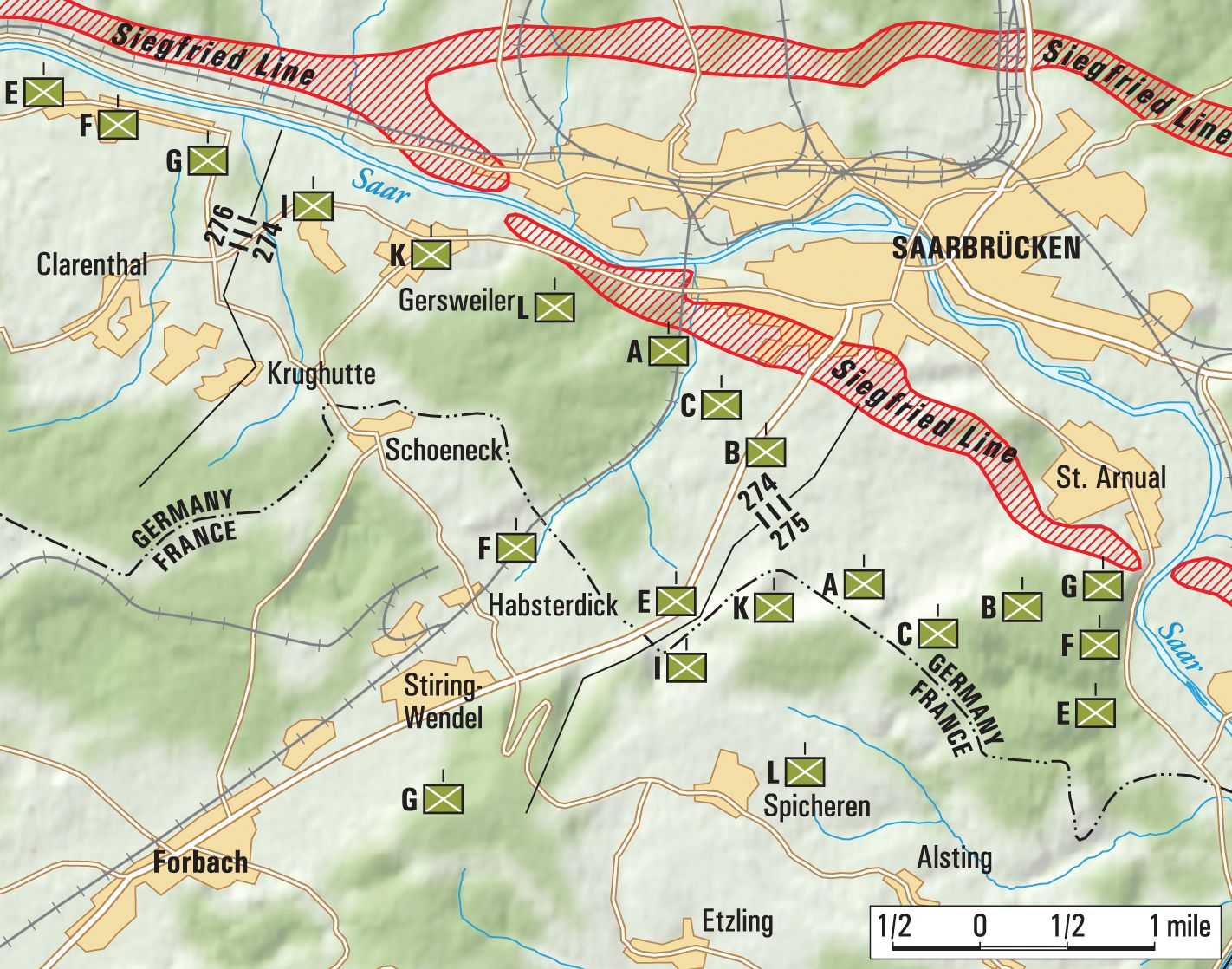
In the morning, the members of the 4th Platoon, C Company, not on duty, finished ridding themselves of German ammunition and other equipment they had collected. Several men had found bicycles they used to carry the bulk of their items—loaded like packhorses. A detail also dug a grave for the bodies of two German soldiers and then was assigned to bury a horse that had been killed by shrapnel and was giving off a strong odor.
At about 7 p.m., K Company, 275th, arrived to relieve C Company, the company pulling out at 9 p.m. As they moved along the road towards Stiring-Wendel, the members of the 1st Platoon could hear the distinctive boom of 4.2-inch mortars rapidly firing from the hill behind them. The troops suspected that something big was coming.
The 3rd Platoon led the move into Stiring-Wendel, taking up positions at the edge of the town at about 10 p.m. The company paused while further movement was being worked out—determining how to deal with anti-tank ditches and possible mine fields. After an hour, they were told to fall in and prepare to move out. Those with bicycles were told to leave them behind. For the next three hours they climbed up and down railway and anti-tank embankments, following A Company. At 3 a.m., exhausted, they came to a halt.
On the morning of March 14, D Company’s mortar platoon arrived at Habsterdick and immediately set up its tubes in accordance with company commander Lieutenant Ernest Rokahr’s orders. Emplacements were dug in the yards and gardens between the houses where the platoon had established billets.
Sergeant Anthony Study and Pfc. Lawrence Grinwald returned to the platoon after spending 10 days assigned to OP duty. Study appeared to have difficulty moving about, having a bad case of the “GIs.” The 1st Squad saw to it that he had clean facilities and then put him to bed—the sergeant refusing to go to the medics. The members of his squad tried to keep him in bed to rest up, but—such was his dedication—every time he heard the mortars in action he would come out to lend a hand.
Most of the city of Saarbrücken was north of the Saar, the river running east through the city, then looping southeast to the town of St. Arnual, with the Siegfried Line running northwest to southeast along the city boundary.
To the men committed to the attack on the Siegfried Line, it looked much more formidable on the ground than it had on paper—it appeared impregnable.
In front of the 274th was open ground, about 300 yards to be crossed, to the steep southern bank of the Saar. The northern bank, also steep, was lined with a double-wire barrier, backed by bunkers with interlocking fields of fire covering every foot of ground. Concrete machine gun nests, flush to the ground, were set along the riverbank. Mine fields reinforced the defenses.
On the morning of March 15, the 3rd Platoon, A Company, reached Schoeneck, just west of Habsterdick, then moved north to the village of Gersweiler, overlooking the Saar and the German defenses. The GIs dug in, reinforcing their positions with sandbags and logs.
One of the light machine guns of the Weapons Platoon, B Company, was placed near the 2nd Platoon CP. On its left was a blind spot created by a high rock wall. The machine-gun squad consisted of a crew of six. In the early morning hours, in the pitch dark, two crewmembers had just come off guard. They woke up two others and then went over to the 2nd Platoon CP for a smoke. In the meantime, a German patrol slipped through B Company’s perimeter, quietly capturing the gun crew along with the two sleeping men.
At dawn, there was such a heavy smokescreen that it was possible to see only a few feet. At first the men of B Company thought it was fog and then thought it was a German smokescreen laid down in preparation for an attack. Captain Mitchell gave orders to hold positions at all costs. Later it was learned that the smoke had been laid down by American artillery or 4.2-inch mortars, and that C Company was to attack across the open field to their left. But the attack did not materialize.
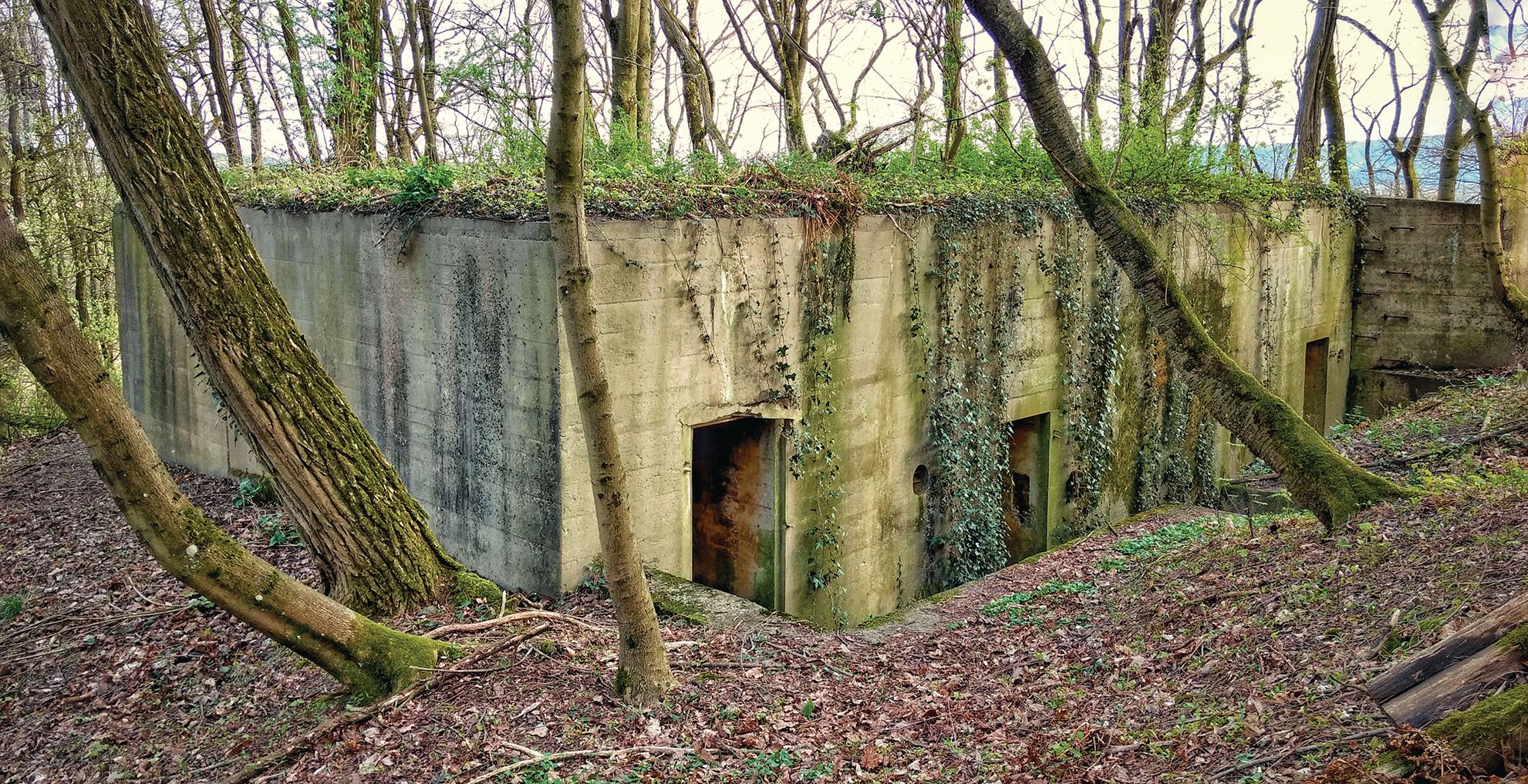
Around 6 a.m., members of the 2nd Platoon, B Company, heard firing along their left flank. Sergeant Luuko, leader of the 3rd Squad, was told by Sergeant Broone that the Germans were counterattacking; however, he couldn’t see any Germans. The firing was spasmodic, though at times very heavy.
Pfc. Henry Zampier, D Company, recalled: “Early in the morning, we heard shouts of ‘Counterattack!’ We took shelter behind a shed as cover against the flat-trajectory fire just as the enemy started dropping smoke shells. We started sending fire orders and digging ourselves a hole at the same time. Soon the 88s began dropping all around us.
“Our radio, which was the only means of communications that we or the rifle platoon had, was knocked down [out] twice . . . We fired the mortars by sound as we were not able to observe because of the smoke and dust and the fire being laid down by the Germans. However, we figured we were doing plenty of damage as the guns were well zeroed in and were firing only about 25 yards ahead of our own positions.”
The light machine gun near Sergeant Luuko’s position fired into the woods to their right front; the Germans responded with heavy fire. Sergeant Broone called for a 60mm and 81mm mortar barrage into the area that the Germans would have to cross to reach the American positions. The barrage gave the area a heavy pounding.
German artillery, mortar, and machine-gun fire continued intermittently all day while sniper fire harassed and caused casualties. Privates John Blair, Broadus Bunce, and Ronald Althausen were together in a foxhole. Bunce was hit during the morning in the right shoulder by sniper fire; he was evacuated. Later, Blair was shot in the head, probably by the same sniper, but it only knocked him out. A medic was not able to reach Blair for a half hour.
As the medic started to lift Blair out of his foxhole, the sniper killed the medic instantly with a bullet through the head, the bullet striking the red cross on his helmet. Since it was now impossible for a litter team to get to Blair, Private Althausen stayed with him until after dark when a litter team arrived and carried him out; however, Blair died later.
When orders were received that B Company was to attack the Siegfried Line, Captain Mitchell called the platoon leaders together to discuss plans and review aerial photos and topographic maps. It was decided to make a frontal approach to the German positions rather than moving to the left; German positions on the left were well fortified and strongly defended. Also, the Germans might not expect an attack to come right over the bare hill before them. The attack was to be preceded by an intense artillery barrage.
According to intelligence from prisoners, each pillbox was manned by at least 17 men, mostly ex-Luftwaffe personnel, each with enough food to last two weeks, and there were trip-flares and mines in front of the pillboxes. It was also reported that the American artillery had not had much effect on the pillboxes.
Plans called for the 3rd Platoon to jump off at 3:15 p.m. following an artillery barrage. But then it was decided to fire an additional barrage, and so it was almost 4 o’clock before the platoon moved out. As they advanced, Lieutenant Chappell brought his 1st Platoon into position behind the 3rd along a reverse slope.
The 3rd Platoon moved out with two squads forward and one back. The 1st Squad was on the left, the 2nd Squad, under Sergeant Penland, was about 75 yards to its right; the 3rd was to the rear under Sergeant David Mann. S/Sgt. Robert Rysso was with the 1st Squad, carrying an SCR-536 radio, maintaining contact with company headquarters.
While the 1st Platoon was waiting on the slope of the hill, the Germans laid down artillery fire; however, most of it landed off target, causing no injuries. As they moved out, Sergeant Rysso sent Private Lawrence Condict, scout of the 1st Squad, over the crest of the hill. He came back and reported that he thought it was going to be rough going.
With the 1st Squad providing a base of fire, both squads started moving up towards the brow of the hill. Sergeant Penland and Dunn were trying to get scouts out, so Pfc. Luther Hanson was told to move out fast so that they would reach the brow well before the rest of the squad.
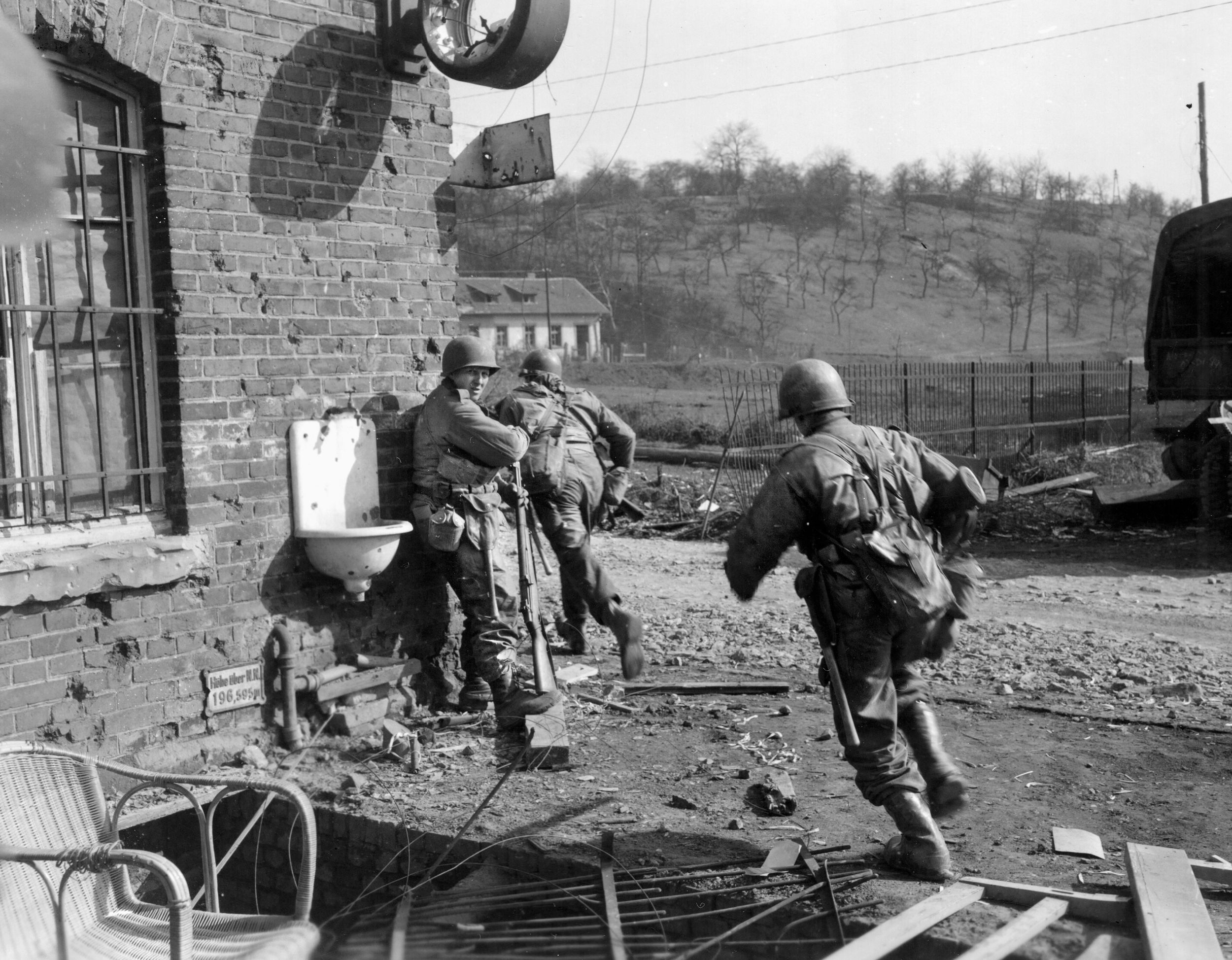
Private Nicokoris reached the top and started down the other side. Pfc. Gordon Pean, from his position, could see the dragon’s teeth, dug-outs, and trenches of the Siegfried Line. He wondered why it was so quiet and why they were being allowed to walk over the top of the hill and into the open.
Most of 1st and 2nd Squads had reached the brow of the hill and passed over to where the ground leveled out when all hell broke loose.
Nicokoris hit the ground, then got up and ran back a short distance but was knocked flat. Not knowing the extent of his injuries, Nicokoris’s buddies told him to lie perfectly still. Dunn, the squad leader, reached the wounded man and saw he had been hit in the right side of the chest.
In an exposed position, Dunn and Nicokoris started to crawl to the rear but another bullet hit Nicokoris, this time in the left upper chest as he tried crossing a fence. Dunn told him to stay down as American tanks were on the way. The rest of the squad had gone to ground, using any depression for cover.
On the left, as the 1st Squad came under fire, the squad leader, Pfc. David Traum, went out to check on Condict, the scout, who was pinned down. Traum came back and also reported to Sergeant Rysso the location of the German machine guns. Rysso called back and had artillery laid in on them. As Traum went back for Condict, he was hit in the foot by a machine-gun bullet, but managed to crawl back about 50 yards to a large shell hole that was half full of water.
Meanwhile, a medic and Private Sigsbee Newton were called forward. Newton was new to the unit—this was his first action, and he had volunteered to assist the medics. Although scared, he remained in the fight, doing all he could for the wounded.
While tanks were coming up, Private L.T. Ingraham, who had taken over the 1st Squad after Trauma was wounded, was himself hit in the shoulder and collarbone by machine-gun fire. Meanwhile, Nicokoris was hit again, this time by shrapnel, in the back and legs.
When the tanks appeared, several men made an effort to get behind and use them for cover. Private Maurice Palmer, Pfc. Howard Frazier, and another man were running towards a tank when a shell burst nearby, hitting all three. Frazier was dazed for a minute, then discovered that he had been hit in the hand and right shoulder, but was able to make his way back to an aid station where he found he also had a machine-gun bullet in his leg.
Pfc. Pean saw Palmer lying in the open and told him to get behind the tank. Palmer said he couldn’t, that he was hit and needed to be assisted.
Additional casualties included Condict, who was hit in the thigh by shrapnel, Pfc. George Rakowski, who was hit in the arm, Private Francis Casto received a broken leg, and Private Norbert Jannink, a bazooka man, was hit in the head and face.
After 15 minutes, the two tanks providing support decided to withdraw. The crews claimed that the ground was so soft that they could not cross the obstacles before them. As the tanks started back, the remaining infantrymen were ordered to withdraw; artillery provided a covering barrage.
Several of the riflemen and a medic went out onto the hilltop to help bring in the wounded. Although in the open, they drew no fire. They found Palmer dead, Jannink unconscious.
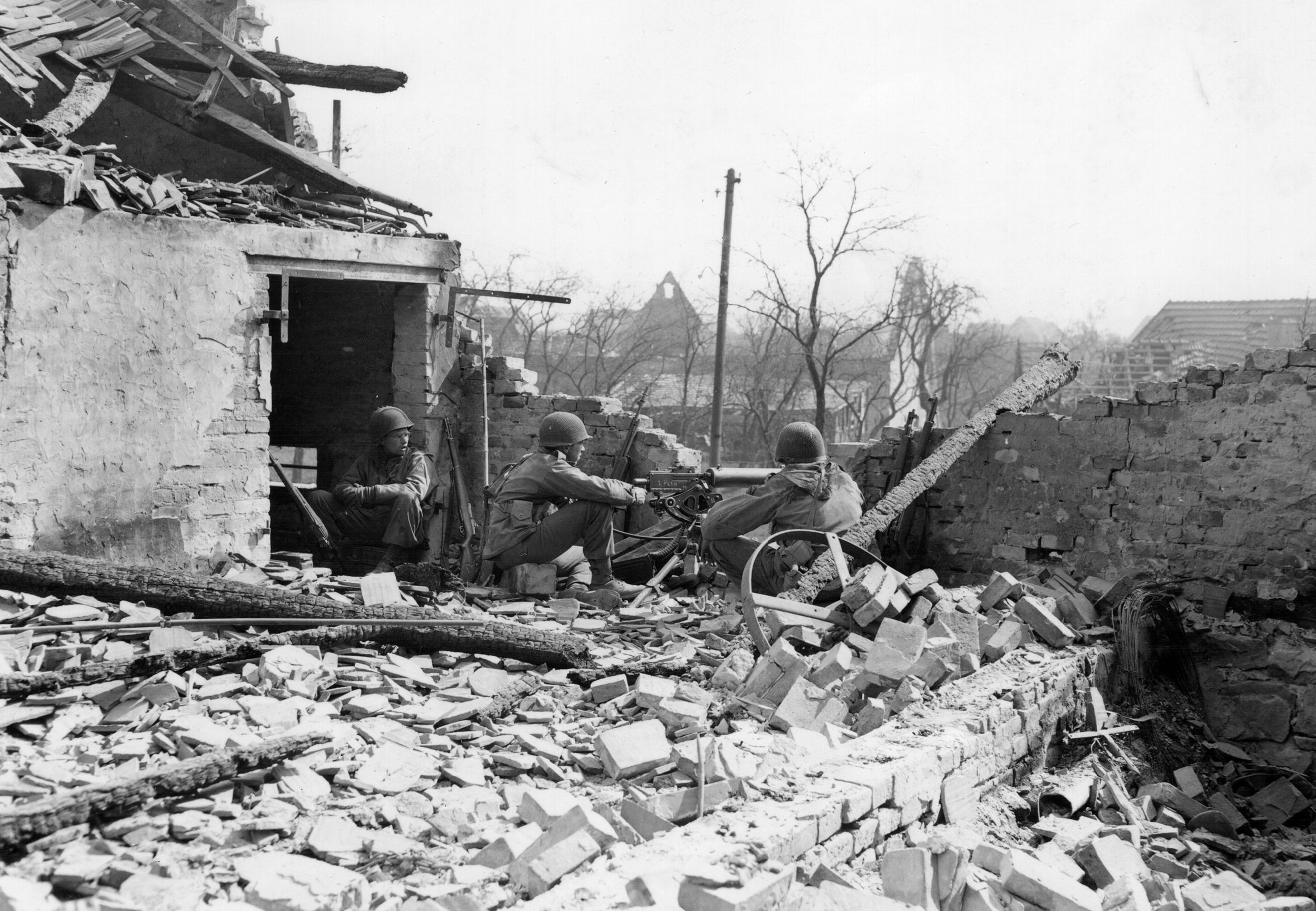
Sergeants Rysso, Penland, Dunn, Mann, and Private Newton took cover in a shell hole. Penland recalled what happened next: “Two artillery shells whistled across the top of the hole, coming from behind our lines and almost knocking me flat. They landed in the general vicinity of our wounded out on the field. I called back to Sergent Rysso to have the fire lifted because it appeared to be landing among our wounded men.
“I was on the forward slope of the crater near the top, trying to see where the shells were landing. Out of the corner of my eye, I could see, coming from my left, two men supporting another, coming towards the shell hole. I glanced around and recognized [Pfc. Charles] Andrews on the right, supporting a wounded man and [Pfc. John] Helaszek to the left. I did not have time to recognize the third man who I was told later was [Private Fred] Ledford.
“I just got out the first word of ‘Get down!’ when a large-caliber shell made a direct hit on the three men who were at that time approximately six yards from the hole. I saw a tremendous flash of fire and black smoke and pieces of the men’s bodies flying through the air.
“The concussion from the shell blew my steel helmet off and threw me into the bottom of the crater, which was filled with water and mud. One man’s body flew over me and hit the water beside me. One of the men’s legs hit on the right of me in the water. The medic, who was on the near side of the crater, was rolling down the side. I threw out my hand and stopped him before he rolled into the water. He was covered with blood from the men who had been hit by the shell. I asked him if he was hit and he said he didn’t know.
“He crawled over to help another man who was pushing himself toward the water with only his legs. This was probably Ledford who was later found dead in the hole. I looked around and saw a man’s chest and hands sticking out of the water. I grabbed him to pull him out, thinking that possibly he was still alive and would drown. I saw that he was mangled and dead and let him slip back into the water.”
When Penland was able to withdraw back to where the rest of the platoon was, he could only find 10 uninjured men—the 3rd Platoon’s casualties were four killed and 17 wounded. Those left took up positions to meet a possible counterattack, which failed to materialize.
After the 3rd Platoon returned from the day’s action, the 1st Platoon moved up and took positions to the left of the 3rd, with the 2nd to its right.
Lieutenant (later Captain) Charles Blanchard, C Company CO, had assembled his company near Stiring-Wendel and set out at 9 a.m., following a route that A Company had taken during the night up toward the high ground overlooking Saarbrücken. The company advanced over a mile, moving through Habsterdick, until it reached the cement plant and quarry. There, Blanchard halted the company and held a council of war.
The advance then resumed with Blanchard’s C Company entering a wooded area and spreading out, then making contact with the 2nd Platoon. While moving through the woods, the 3rd and 2nd Squads drew fire.
Lieutenant Robert Connor ordered assistant squad leader Pfc. John Poveliatis to take three men and check the situation ahead of them. As Poveliatis moved towards the left, where Pfc. Frank Travis, 2nd Squad scout, was located, machine-gun and sniper fire pinned them down. The GIs responded with their own fire, but this was ineffective as the Germans could not be spotted.
It appeared that the fire was coming from a hillside some distance away, directly in the line of advance. The 2nd Squad was able to finally advance in short rushes, but had to halt at the edge of the woods when they reached a wide ravine. Beyond they could see the dragon’s teeth of the Siegfried Line.
With the rifle platoons pinned down, mortar fire was called down to knock out a couple of machine-gun nests. Sergeant Leon Bartram selected positions for his mortars, ran wire to a forward OP, and then directed fire. About this same time American artillery opened up with a heavy concentration that saturated enemy positions.
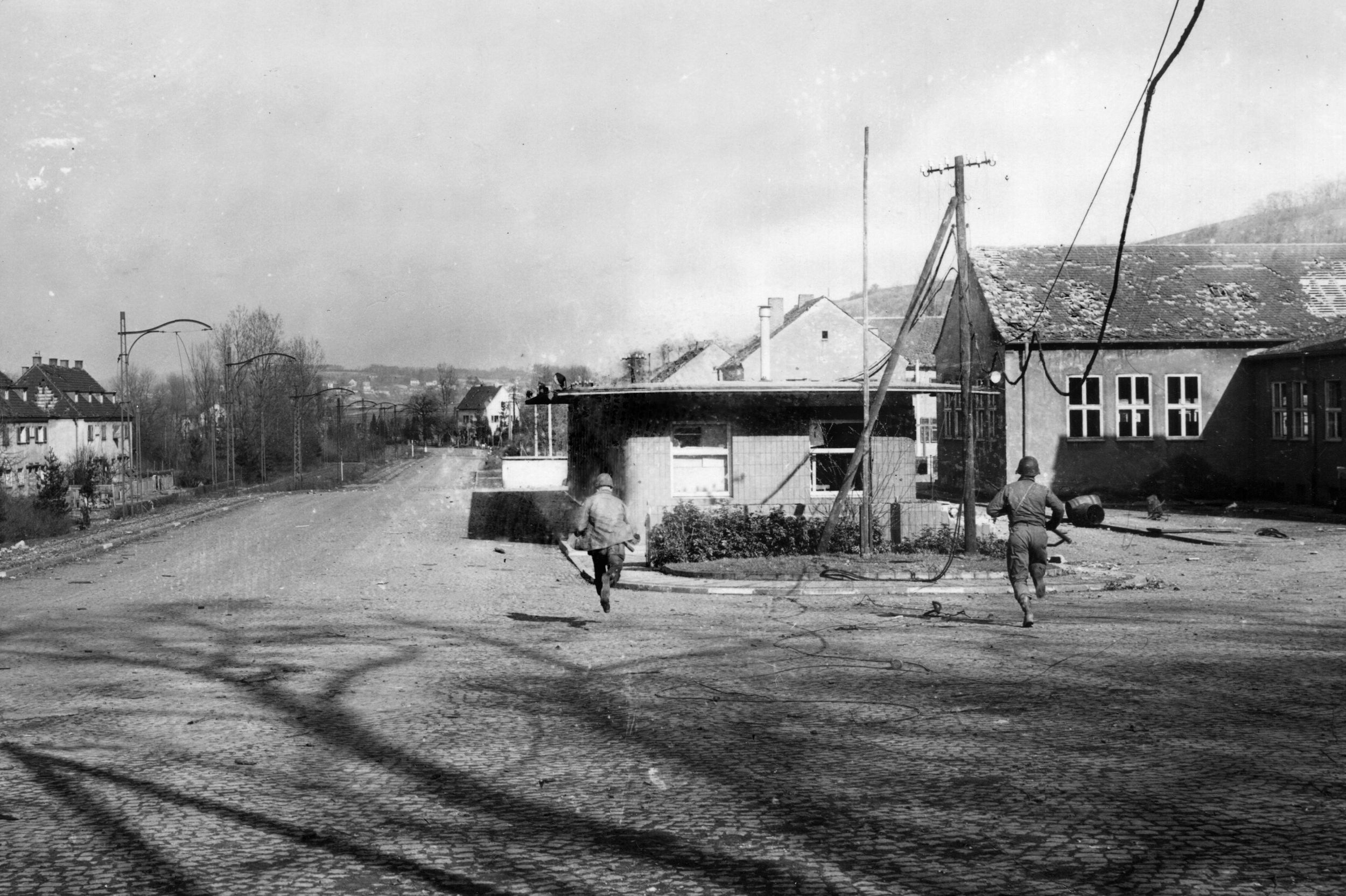
The Germans were seen to be running from their trenches and foxholes to the protection of the Siegfried Line pillboxes, but the platoon’s 60mm mortars were able to pick them off as they ran. Despite being wounded in the right hand, Sergeant Bartram continued to direct fire. He was later evacuated to the battalion aid station.
Later, the word was given for C Company to move to the right of B Company with A Company to move in and replace C.
As the men maneuvered, German machine guns opened up again, causing the GIs to dash for the cover of a wooded ravine. Emerging, they were forced to scamper across railroad tracks while exposed to enemy fire, jump down from a high wall, and then cross a highway, taking cover in what was formerly a zoo and park.
They found the buildings had been badly damaged, so they sheltered along the side of a hill behind the remains of the structures. Although subjected to a severe shelling, they were protected there and afterwards received the first hot chow they’d been given in days—providing a boost to morale.
The night passed uneventfully, although several contact patrols were sent out. Tech/5 Edwin Pressler, 2nd Platoon, B Company, had his BAR ready for action, should it be needed, covering the front. “The presence of that worthy weapon always gave a fellow a good feeling of security,” he said.
Lieutenant General Alexander Patch, Seventh Army commander, arrived at 70th Division headquarters on March 16 to press Barnett to get his attack underway. Barnett argued that an immediate attack would cost needless casualties. Also, Third Army’s advance to the rear of Saarbrücken would cut-off the Germans, thus negating the need for a frontal assault. Patch nodded and agreed to a delay.
That morning, a replacement officer, Lieutenant Marcil, arrived and was attached to the 1st Platoon, B Company, where he spent most of the day asking questions and looking over the company’s positions. He and Lieutenant Chappell went to the 2nd Platoon’s previous positions to check on a report that a private first class named Harold Davis had been found alive and evacuated. Instead, they found Davis’ body.
They also discovered that C Company had not taken over the positions to which they had been assigned, and that there was a gap in the American lines. Chappell notified battalion headquarters, which directed C Company to move and fill the gap.
During the morning, Chappell went out to the shell crater where the 3rd Platoon men had been hit the day before and identified Pfc. Helaszek’s body by his dog tags. While he was in the hole, he heard the crack of a bullet as it hit the ground just outside the hole.
At first he didn’t recognize what had happened, then realized it was a sniper’s bullet. He tried to see where the sniper was as another bullet came in. As he dashed to get his carbine, which he had left outside the hole, a third round struck nearby.
Chappell noted a water tower to his right and calculated from the angle the shots that the sniper must be there. He then made a break back to his lines and warned others. As soon as he got back to his CP, he showed the artillery forward observer where he thought the sniper was. They fired a few rounds and, once they had it zeroed in, they added time-fire. After a few more rounds, the sniper and water tower were eliminated.
During the morning, Blanchard’s C Company moved out, prepared to bypass A Company on its right flank; however, orders were changed at the last minute, so they moved to the left and rear of A Company. The 1st Platoon led the company, followed by the 2nd, 3rd, and 4th.
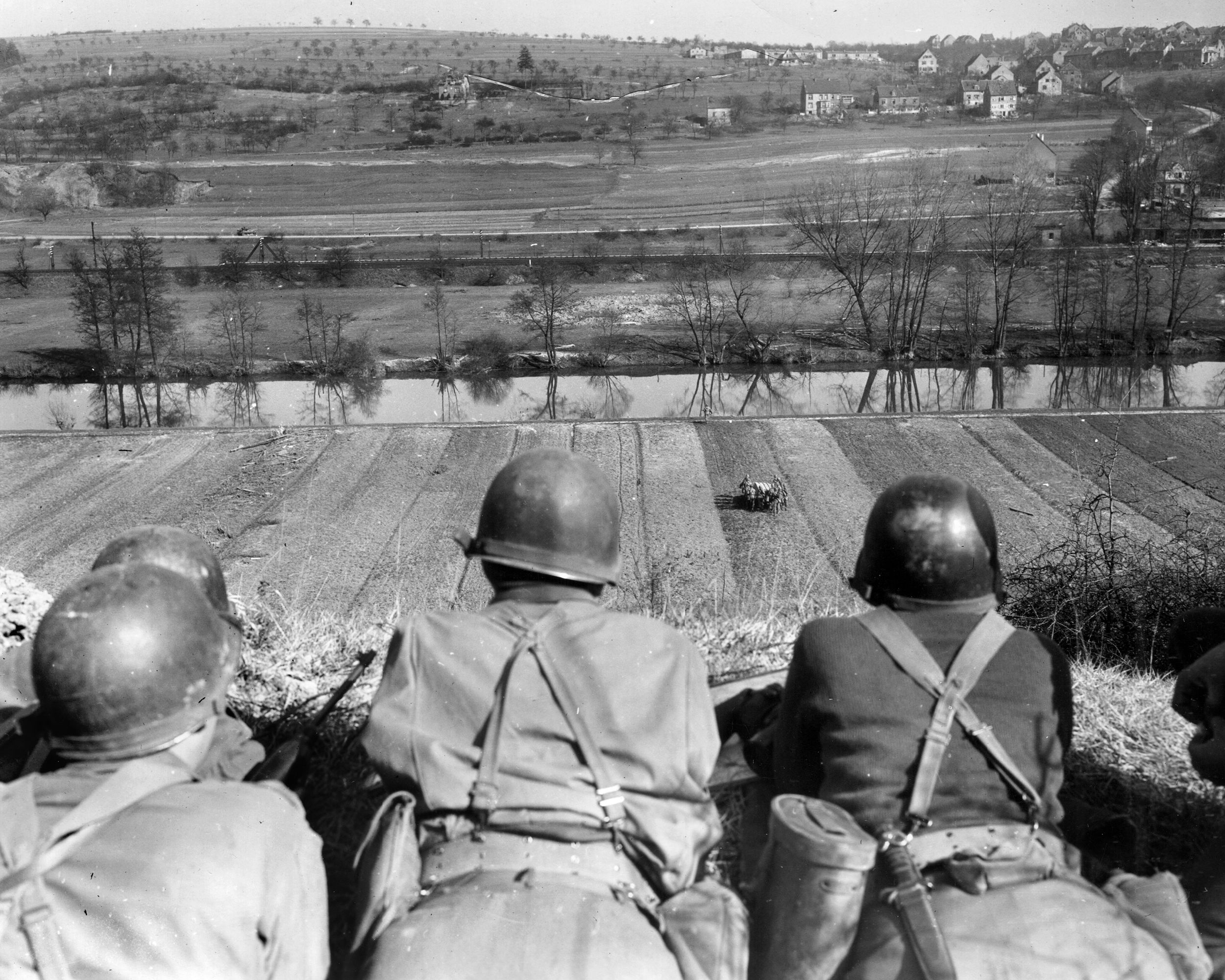
When they had just reached the nose of the hill they were assigned, Siegfried Line machine guns opened up, hitting three 1st Platoon men. Unable to advance, the platoon dug in while the other platoons moved into position on the left, behind A Company.
In the meantime, tanks returned, moving into position to where they could fire on the Siegfried Line pillboxes, and C Company was ordered to pull back and move to relieve B Company. As C Company moved into the vacated foxholes, they found that B Company had departed in such haste that they left behind several wounded and dead comrades.
The men of B Company spent the 17th, a warm and sunny day, cleaning weapons and reinforcing their foxholes—deepening them and adding a covering of boards or logs with dirt over it for protection against air bursts.
Lieutenant Chappell, 1st Platoon, visited the Company CP to see Captain Mitchell. While he was there, a call came in saying that the sound power system between the 1st and Weapons Platoons would be used to adjust artillery fire, but the sound power equipment had to be moved from the cellar of a house to an upper story.
S/Sgt. Horner and a medic were handing it from the top of the cellar steps through the kitchen window to Lieutenant Marcil and an artillery observer when a shell screamed in and hit the side of the house, killing the lieutenant and the observer. Horner and the aid man were badly hurt as well; Horner later lost his leg. It had only been Marcil’s second day on the line.
The day of an infantryman was one of move, dig in, move again, and dig in again—this was how one survived. A foxhole or dugout was never complete, never deep enough, never comfortable enough.
The 2nd Platoon, B Company, was engaged in such activity when orders came to move about 200 yards to a new position and dig in again. A line of defenses was established covering the strip of woods from the left flank to the open field on the right flank while the 3rd Squad established outposts. The line was reinforced with a section of light machine guns. Lieutenant Connor located his CP a few yards behind the 2nd Squad. The platoon was delighted to see members of the CP group digging in as well.
During the morning, the 3rd Platoon, C Company, pulled back about 300 yards while artillery pounded German positions, but with little apparent damage. About 5 p.m., they moved back up to their previous positions.
The action picked up. In C Company’s 4th Platoon sector, heavy sniper fire had wounded nine riflemen and two medics; any movement in the area seemed to draw fire. The snipers were too close to the company’s positions for the use of artillery, so 60mm mortars were employed. The mortars had only fired a few rounds when a German “88” round landed close to the mortars, wounding three men—Pfc. Warren E. Culp, Pfc. Harry D. Brown, and Sergeant Leon F. Below—and knocking one mortar out of action.
At about 2:30 p.m. on March 18, Pfcs Gerald Luther and Winifred Bollinger, Weapons Platoon, were reading comics near their foxholes. A mortar round came in behind them and another to their front. Bollinger stayed where he was, but Luther took off for his hole. He was wounded just as he reached the hole while Bollinger was untouched; Luther returned to his unit in April.
In the 4th Platoon’s area, an occasional German mortar or artillery round fell. There was one incident that members of the company considered a near miracle. Sergeant Glen Main was standing about five feet from his foxhole when a mortar round landed within three yards of him, blowing him several feet into the air, and landing him in his hole, virtually unhurt. However, his rifle was riddled with holes.
During the day, elements of Patton’s Third Army reached a point 60 miles northeast of Saarbrücken; Intelligence reported German forces withdrawing towards the Rhine. But the German defenders in front of the 70th Division continued to resist. American patrols, attempting to cross the Saar by boat, encountered withering fire.
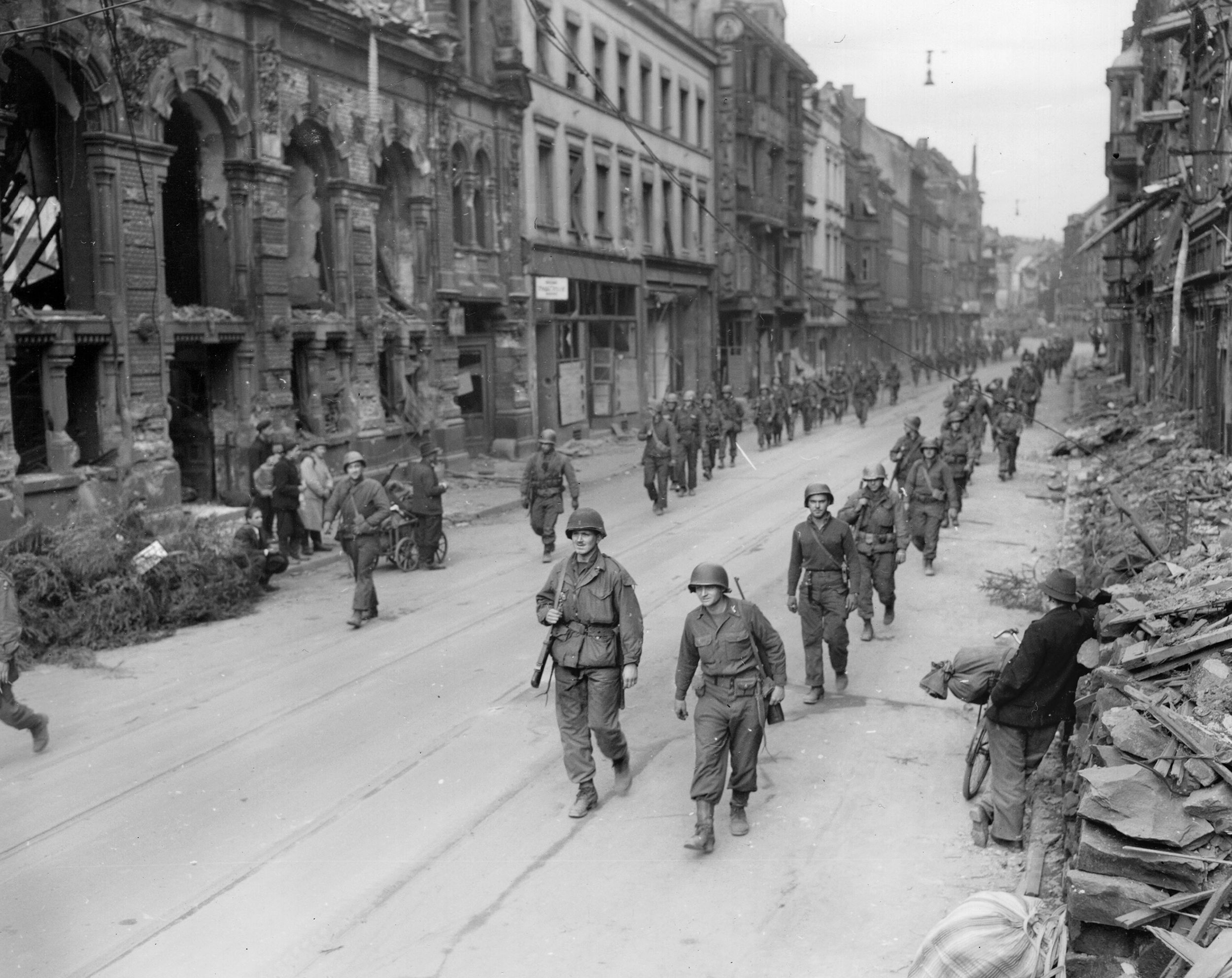
The division was again ordered to attack across the Saar the next day, March 19. The 274th was to take over the 276th’s positions and prepare to attack Saarbrücken’s defenses south of the river, then cross the Saar at the Metz Highway bridgehead. General Barnett cautioned his commanders to minimize casualties. H-hour was to be determined by the situation at hand, and all units were to be prepared to move on an hours’ notice.
Around daylight, all direct-fire weapons—anti-tank guns and tank destroyers—opened up with a furious barrage in an effort to reduce the river-front defenses. The cannonade appeared to be effective against the pillboxes while other guns targeted factories and possible enemy OPs.
C Company relieved B Company and crossed the road on their left, climbed a hill, turned left, and followed railroad tracks until they branched off. Here, they went to the right and then turned into the woods, advancing until they reached another railroad track on a high embankment. They proceeded and finally reached a road in the vicinity of Schoeneck, north of Stiring-Wendel. The terrain was heavily wooded and hilly.
Lieutenant Harold Dunbar, 1st Battalion S-2, had sent word that it was believed that the Germans had abandoned the pillboxes to their front, and that heavy German artillery and mortar fire falling on the battalion’s positions was probably covering a withdrawal. Lieutenant Blanchard, therefore, decided to send out a patrol to see if the German pillboxes were still occupied.
The patrol, led by Tech/5 Willie Prejean of the 2nd Platoon, returned shortly after 6 a.m. They had checked six pillboxes and found all of them abandoned. Once the information was transmitted to battalion, the company was ordered to move forward, pass through the Germans’ fortified positions, and occupy the high ground just over the Saar.
At about 8 a.m., the company moved out. Advancing in columns of platoons and checking pillboxes and bunkers as they went, they passed through the Siegfried Line without incident, then wheeled left onto high ground. Five prisoners were taken by the 3rd Platoon as they came forward, one of them volunteering to lead the way through booby-trapped and mined areas. Positions were occupied without losses.
Lieutenant Blanchard was informed by Colonel Cantrell that C Company was to cross the river and fan out, securing the bridgehead while those units that had crossed earlier pursued the enemy. However, word was then received that they were to pull back and that the 275th would relieve them. Their battalion was to be the last battalion of the division to cross the Saar.
Shortly after noon, Blanchard and his men moved back to the company supply point, drew rations, and were told to wait for trucks that were to carry them forward. When no trucks appeared after a couple of hours, they started walking. While heading down the road, the trucks arrived to collect them, transporting them across the Saar.
As they passed through Saarbrücken, they found that the center of the city had been pulverized during the fighting. Streets were unrecognizable as such. There were not even skeletons of buildings—just acres of wreckage and large heaps of rubble.
The men of the 274th Infantry were nearing the end of their journey across France and into Germany. Mopping-up operations were to follow, the division performing occupation duties in the Saar Basin area and then finding itself in the vicinity of Frankfurt, Germany, when hostilities ended in May 1945. They had compiled 86 days in combat and suffered 3,919 men killed, wounded, missing or captured during that period of time.
In October 1945, the Trailblazers returned to the U.S. and were deactivated at Camp Kilmer, New Jersey, proud of the fact that they had performed with honor in its assignment to breach the Siegfried Line and break the dragon’s teeth.
The author, a frequent contributor to WWII Quarterly, resides in Hillsboro, Oregon. He is the author of Against the Panzers: United States Infantry versus German Tanks, 1944-1945.
Back to the issue this appears in
Join The Conversation
Leave a reply cancel reply.
You must be logged in to post a comment.
Share This Article
- via= " class="share-btn twitter">
Related Articles
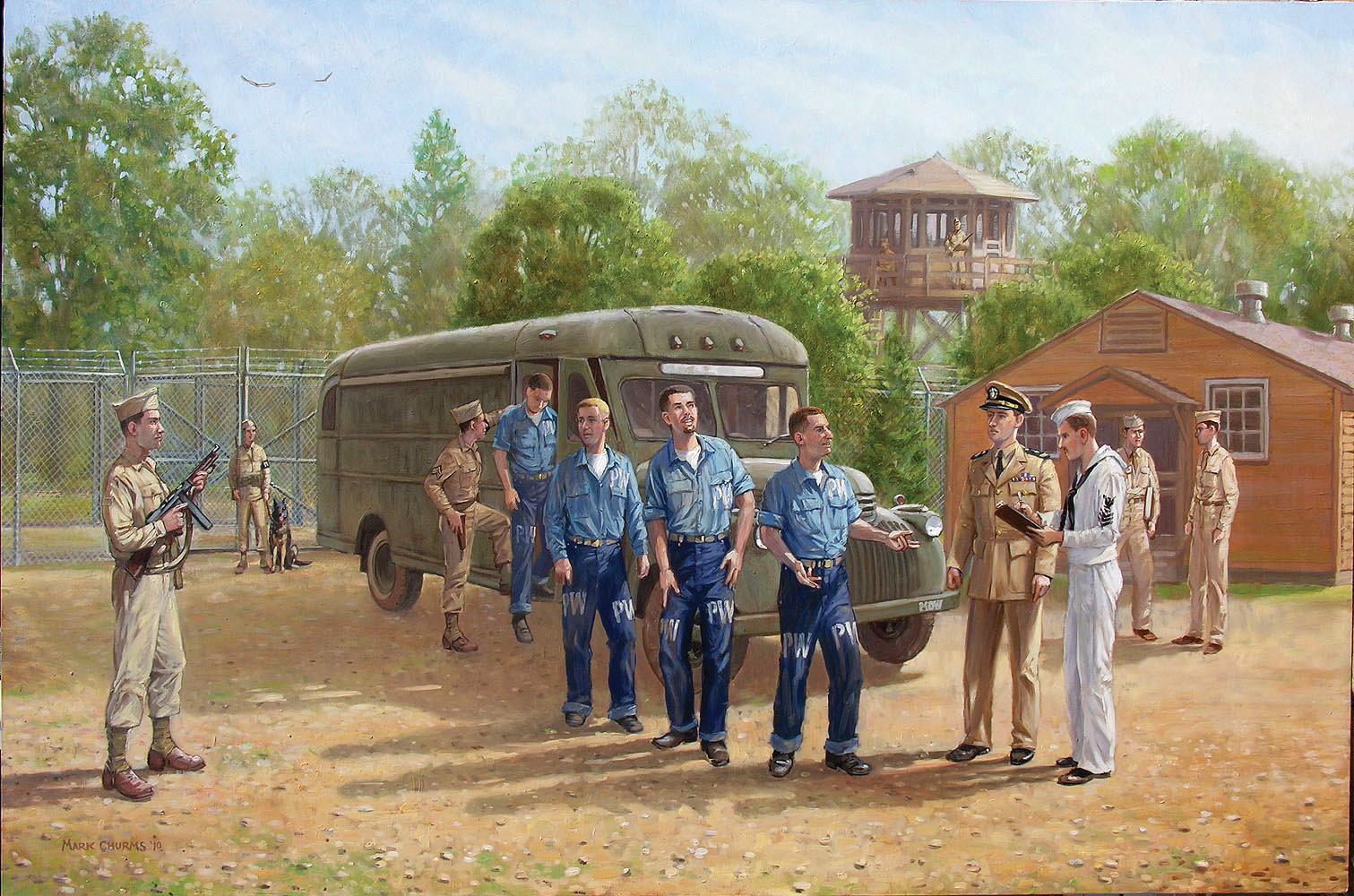
Prisoners on the Potomac
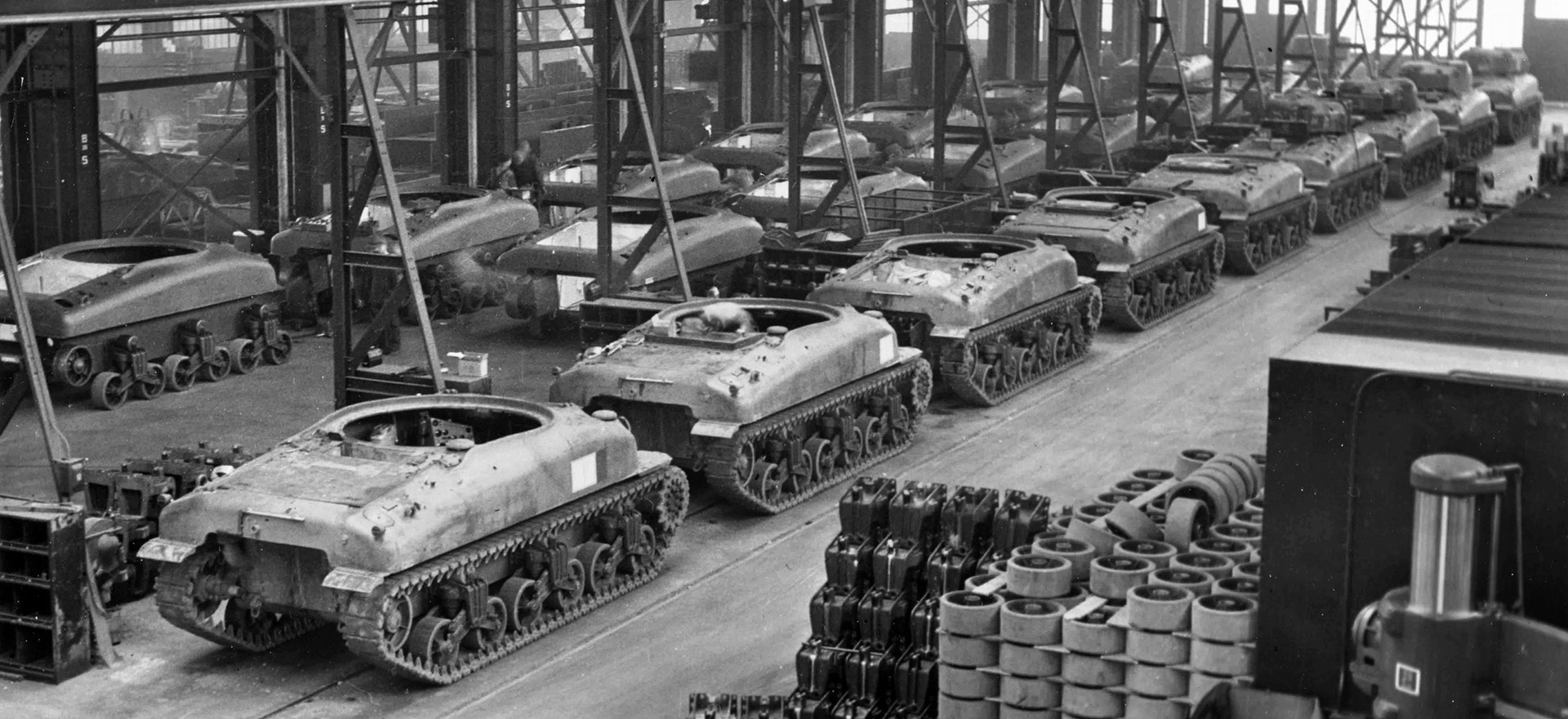
The Allies’ Armored Workhorse
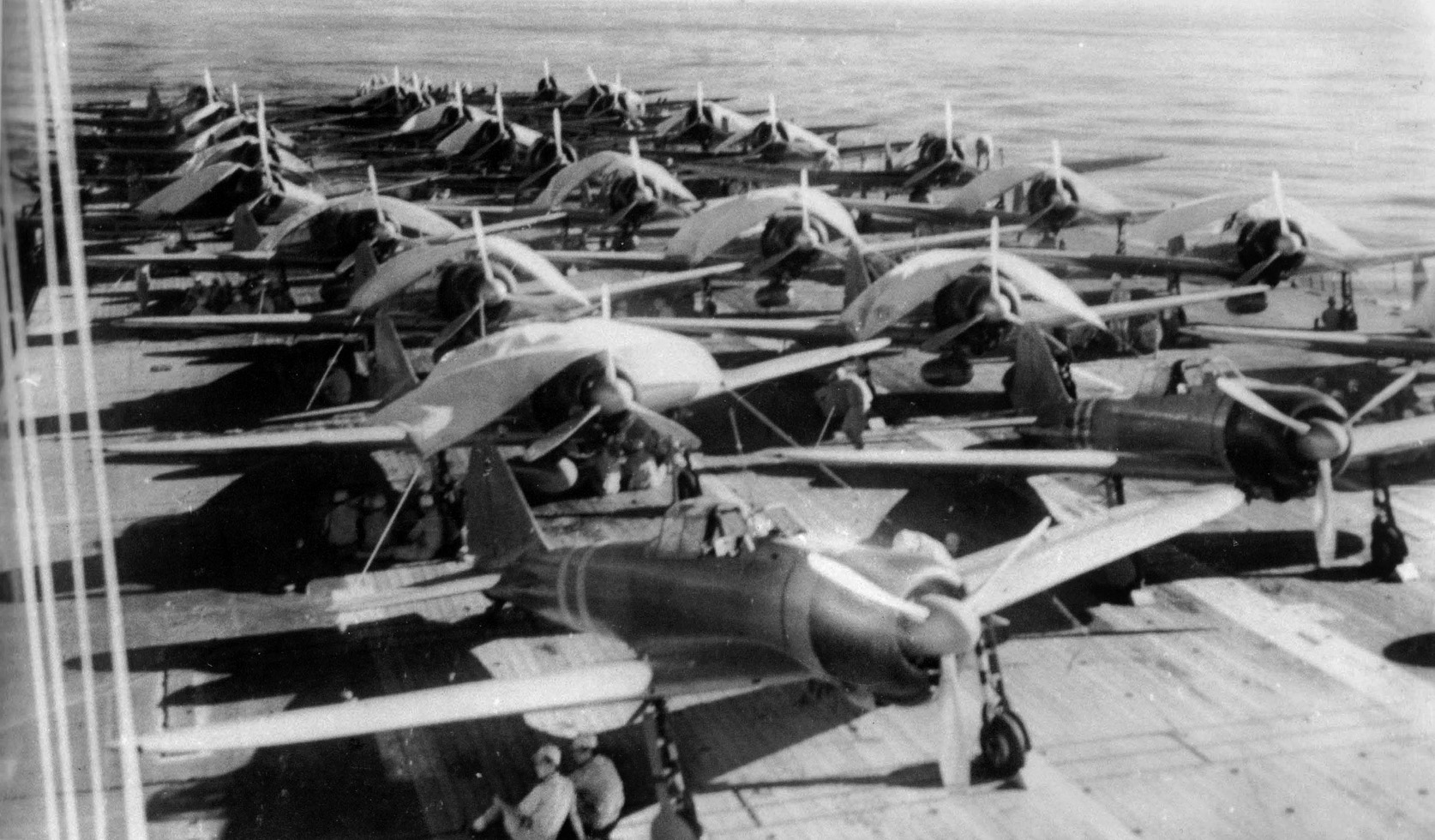
Marianas Turkey Shoot
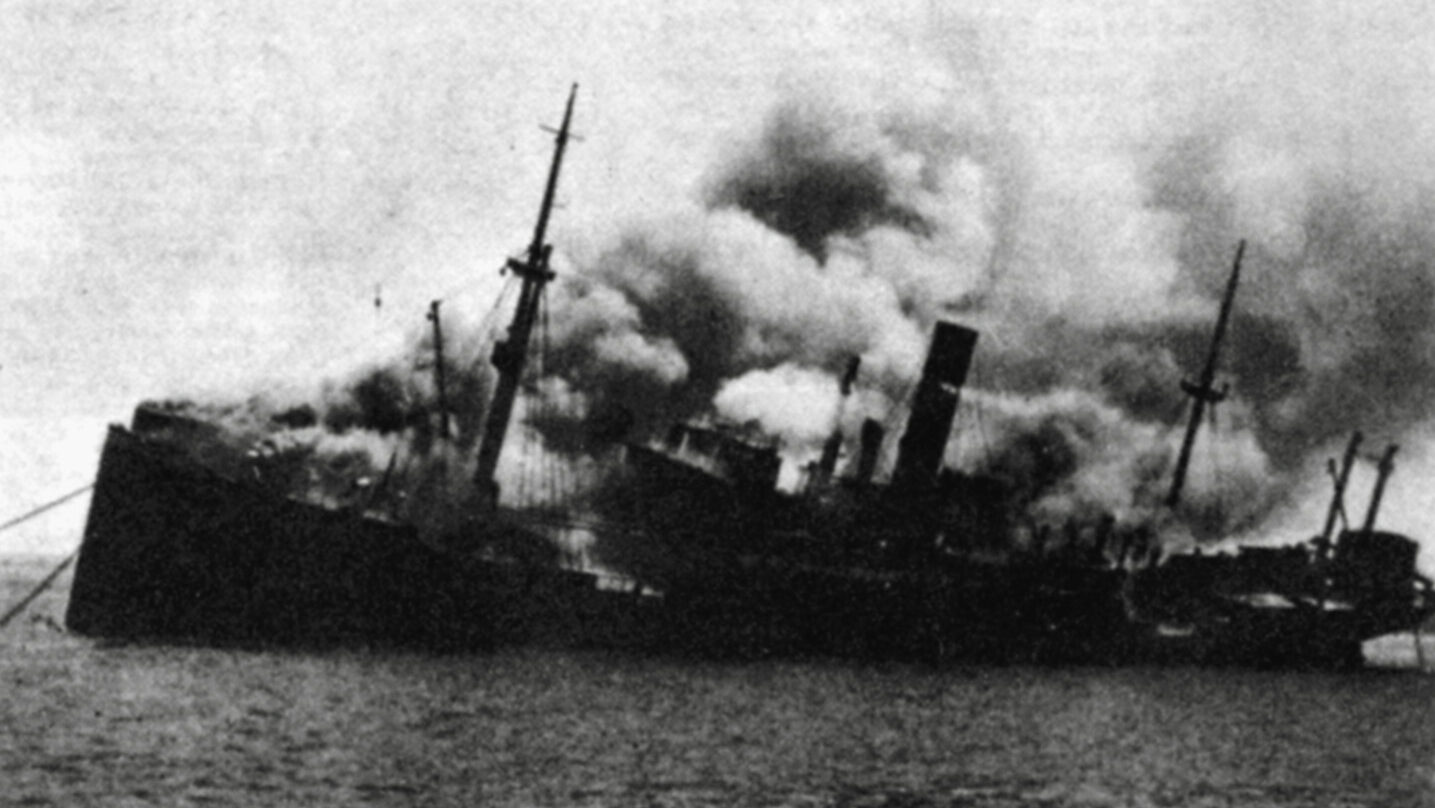
The Daring Calcutta Light Horse Raid
From around the network.
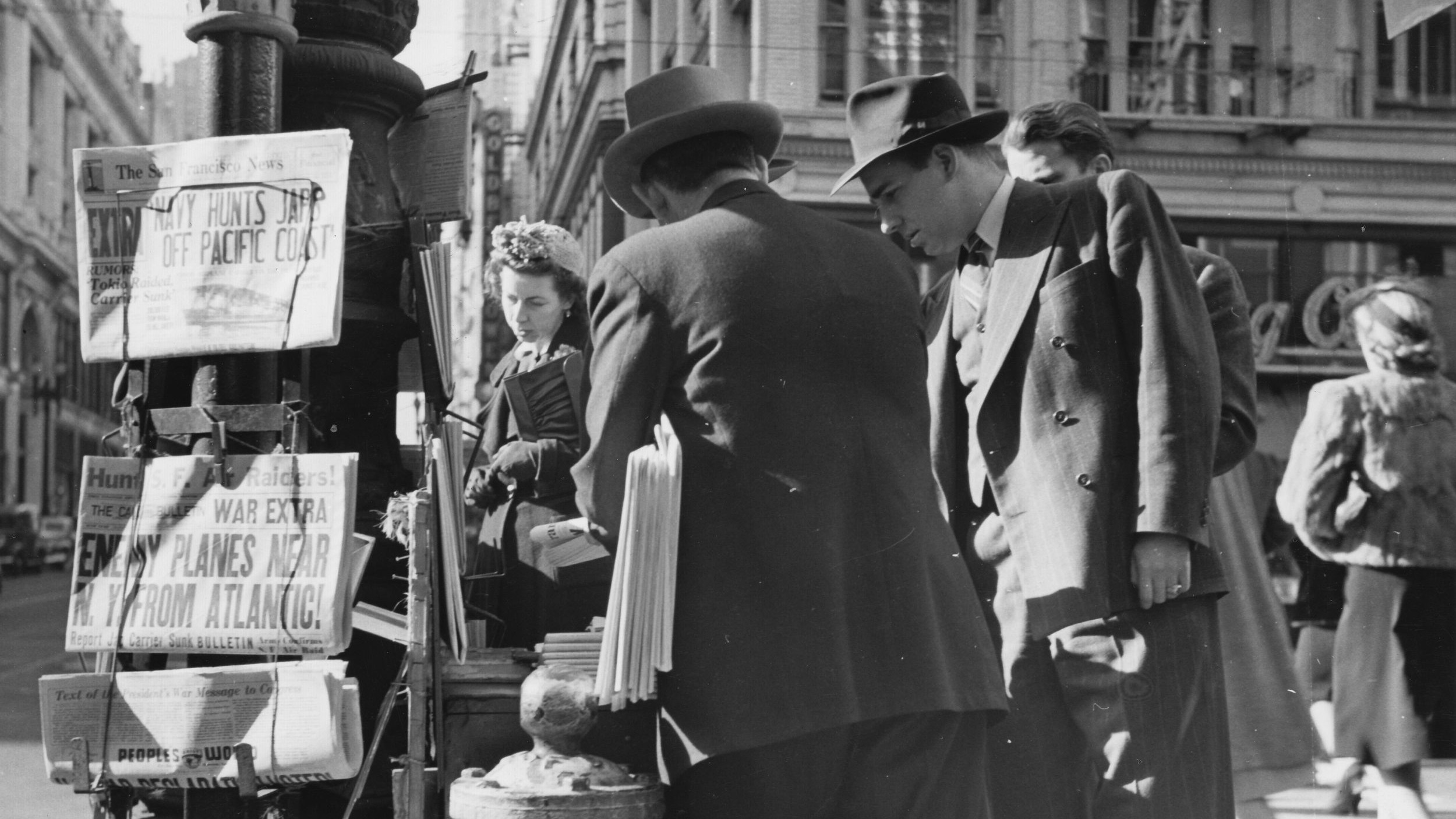
Target: America’s West Coast
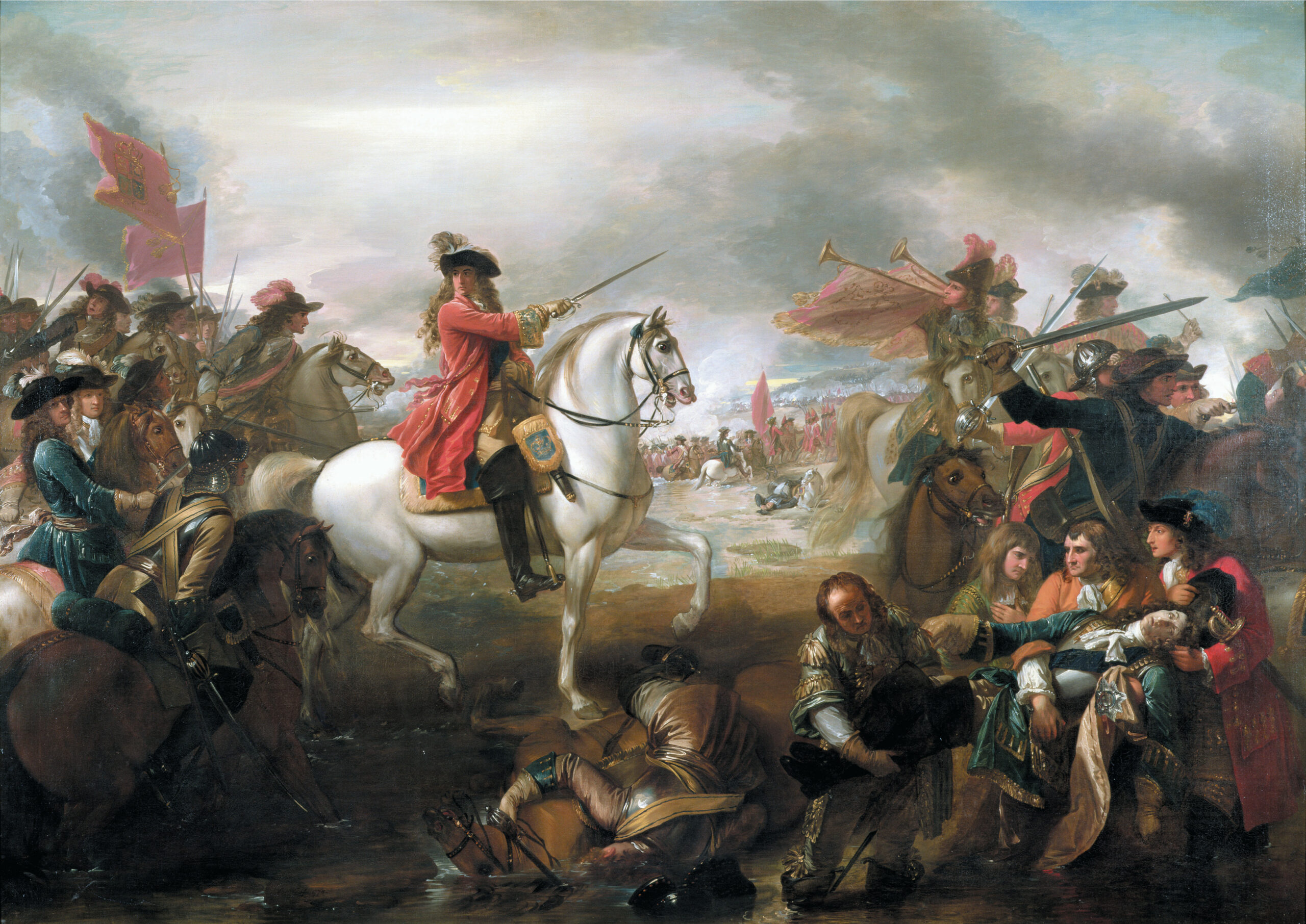
Military History
King Billy at the Boyne River
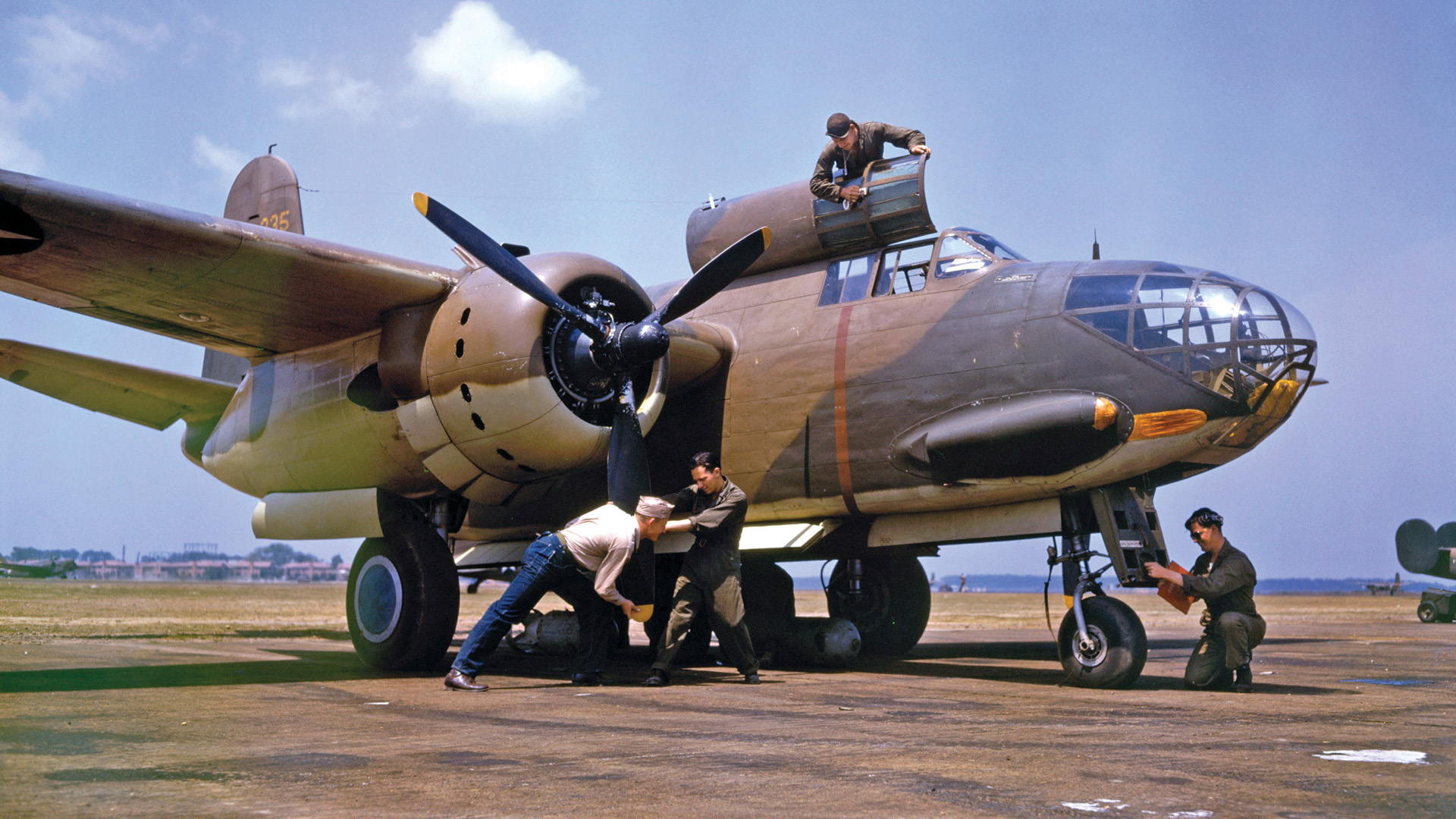
Wreaking Havoc
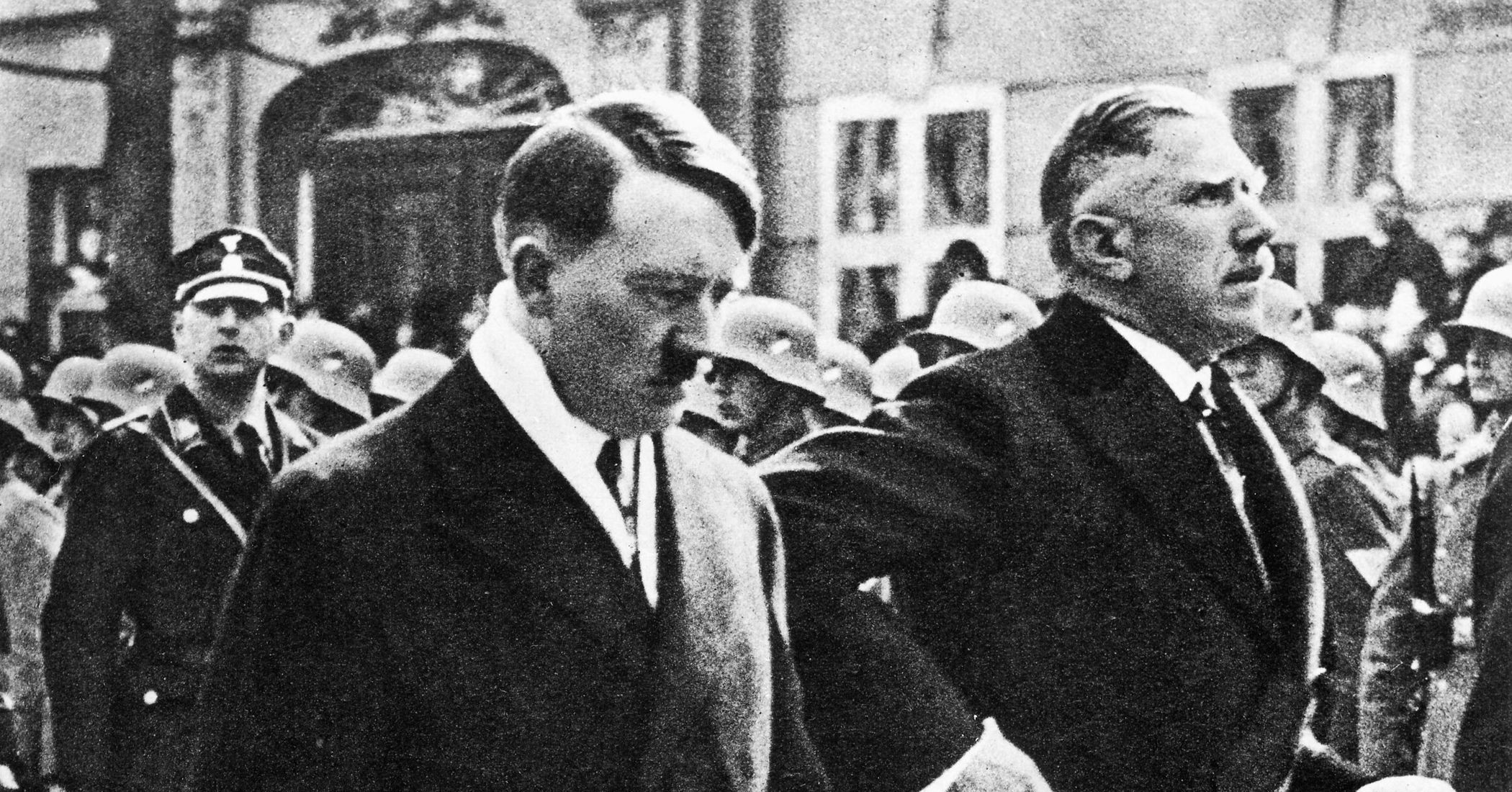
Franz von Papen: Vice Chancellor of Nazi Germany
Siegfried Line - Dragon's Teeth

Top ways to experience nearby attractions

Most Recent: Reviews ordered by most recent publish date in descending order.
Detailed Reviews: Reviews ordered by recency and descriptiveness of user-identified themes such as wait time, length of visit, general tips, and location information.

Siegfried Line - Dragon's Teeth - All You Need to Know BEFORE You Go (2024)
- (7.27 mi) Hotel Butgenbacher-Hof
- (7.23 mi) Hotel Eifelland
- (2.96 mi) Landhaus Eifelsicht
- (1.69 mi) Ferienparadies Heidehof
- (2.67 mi) Hotel Schroeder
- (7.28 mi) Butgenbacher Hof
- (7.40 mi) Restaurant Bruels
- (2.68 mi) Hotel Schroeder
- (5.99 mi) Terracotta Restaurant Weinbar
- (8.51 mi) Balkanland
Homefront Wargame Center
…supporting our hobby.
- HFC – About
- Battlefields and Museums
- HFC on Facebook
- Write for the HFC!
Recent Posts
- Visiting Battlefields: The Battle of Tolbiac
- Up Front or – the never ending story?
- New HFC policy regarding Kickstarter campaigns & reviews
- Tiger Leader – new solitaire & coop WWII board game!
- Review: Cards of Cthulhu (DVG)
Recent Comments
Most popular.
- ROAR - the automated record of played ASL games
- Visiting Battlefields: The Huertgen Forest and the Siegfried Line
- Review: Hornet Leader - Carrier Air Operations (DVG)
- Cat-Proof Wargaming!
- The AREA Rating System
Visitors By Country
Views since 09/2010.
Stay connected on Facebook
Stay in touch!
Enter your email address to subscribe to this blog and receive notifications of new posts by email.
Email Address:
Sign me up!
- • A Wargamer's Notebook
- • AJ's Wargaming Blog
- • Encounters with Reality
- • Grants Grimsby's Wargame Blog
- • I've been diced
- • Map and Counters Blog
- • Mark Herman's Wargaming Blog
- • On Board Wargaming
- • Opinionated Gamers.com
- • Parhoon Naval Yards Blog
- • Scenario Design Center Blog
- • Tabletop Wargames Blog
- • The Gaming Gang
- • The Hopeless Gamer
- • Third Point of Singularity
- • View from the Turret
- • Yehuda: Gaming and more
HFC supports

- Grognard.com
- Entries feed
- Comments feed
- WordPress.com
Visiting Battlefields: The Huertgen Forest and the Siegfried Line
Posted by Denny Koch on November 7, 2011

Above the Kall Trail in the Huertgen Forest
Vossenack, Kommerscheidt, Hürtgen, Schmidt – the names of these German villages are better known in the US than in Germany . If you tell your co-workers in Germany that you will spend your next weekend in the Huertgen Forst, they will give you a weird look and ask you: “Where? Where is that?”
The reason why this region and the Battle of Huertgen Forst are almost unknown to the average German citizen is the fact that this battle “didn’t take place”. Actually, when the Americans got over the Siegfried Line and crossed the German border, Hitler was deep into his preparations for the Ardennes offensive. The fact that Allied soldiers had entered the German homeland was a disaster for German propaganda – which was anxious to make the public believe that the Allies were held up in the West, in France and Belgium. So this battle was swept under the carpet and the German public was told that the Allies were stalled somewhere in the West. The locals of the Huertgen Forest were evacuated, so there were no eyewitnesses to the events in the region, and it was prohibited to talk about what happened there.

The Battle is still very present in the forest. Here: US armor tracks, melted into the ground
The Battle in the Huertgen Forest was one of the bloodiest battles in World War II, it was the longest single battle ever fought by US forces and the trench warfare character of this Battle made it known as “the Verdun of WWII”. Veterans of Huertgen Forest stated that this battle was bloodier than the landings at Omaha Beach. Nevertheless, even today many Germans never heard about the Battle of the Huertgen Forest or could locate this region on a map.
The Huertgen Forest (German: Hürtgenwald) is located in the far West of Germany, close to the Belgian border, in the National Park Eifel close to the Belgian National Park Hohes Venn, South of the cities of Aachen and Düren and north of Monschau.
Fortunately, the Hürtgenwald region is very active in commemorating history. Even today, people in Vossenack or Schmidt are still living with the after-effects of the battle: Some areas are still mined because there are almost no maps left showing the position of the minefields. In addition, there were also glass and wood mines used which cannot be detected by metal detectors. You are advised not to leave the signposted routes in the forest, and if you want to build a house, first thing you do is call an explosive disposal team to check the ground. Each year, the remains of about 7 soldiers are discovered in the forests and fields.
The Battle is still present everywhere in the region. In Vossenack is the Hürtgenwald 1944 museum which is maintained by the private “Historical Society Hürtgenwald in 1944 and in peace”. There are many memorials all over the place, for US soldiers as well as for Germans. One memorial is quite special: it is a memorial for a German officer donated by US soldiers.

Following the Kall Trail down into the steep Kall valley
You can follow the infamous (well sign-posted) “Kall Trail” down into the forest where many remains of the Battle are still visible today. There are two large German war cemeteries in Vossenack and Hürtgen (US soldiers were buried in cemeteries outside Germany, for example in Belgium and the Netherlands, or transferred back home).
The German veteran organization “Windhunde” (former members of the 116th Panzer Division (“Windhunde”) and their families, friends and descendants) is still very active in commemorating the Battle. They set up a large memorial next to the Vossenack cemetery, and they cooperate closely with US veterans. Each year in October there is a Remembrance Walk through the forest by US and German veterans, visitors, and citizens together with many events like an American style BBQ, meetings, and lectures.
We went to the Huertgen Forest in September, on a very sunny day, but when you walk deep down into the forest, you learn very soon that you wouldn’t want to spend an entire winter there. The forests are very steep, the ground consists of solid rocks, and the conifers forest is dense and dark.
As guide books, we used the “Militärgeschichtlicher Reiseführer” by Peter Többicke and the very good “Hürtgenwald 1944/1945 Militärgeschichtlicher Tourenplaner” by Rainer Monnartz. The last book is especially good and highly recommended if you can read German because it offers complete tours with location descriptions, photos, and even GPS coordinates, which proved to be very helpful.
Huertgen Forest then…

Ammunition, equipment, and dead soldiers are discovered each year – down to the present day
The Battles in the Huertgen Forest took place from 14th September 1944 – 10th February 1945. The reason why the US forces entered this almost impassable and rough terrain was that they wanted to push to the Rur river and to secure the Schwammelauel Dam which was located behind the mountains. They also wanted to secure the village of Schmidt in order to capture the city of Monschau, which was a German HQ.
The US forces underestimated the presence of the German forces – they couldn’t know that the Huertgen Forest was a staging area for the Battle of the Bulge planned for December 1944. In addition, the entire wood was mined and crisscrossed by trenches, barbed wire, and fortifications. Because of the rocky and steep terrain, it was almost impossible to cross the forest with tanks or heavy equipment, but the US neglected initial reconnaissance and so the 1st Army got trapped on the rocky and muddy “Kall Trail” deep in the forests with almost useless tanks which had to be abandoned in great numbers. In hindsight, military historians agree that the Huertgen Forest should have been avoided. Charles B. MacDonald, an US historian and former company commander who served in the battle stated that this Battle was “a misconceived and basically fruitless battle”.
Due to the difficult terrain, the American advantage in numbers became irrelevant and a small number of defenders could stall the US advance for months. In addition, the winter 1944 was extremely cold with early snow and heavy mud, and the Americans were completely unprepared to fight in cold weather. They were only supplied with summer equipment and clothing – while the German veterans with their experiences in Russia and places like Stalingrad had become quite accustomed to winter warfare.
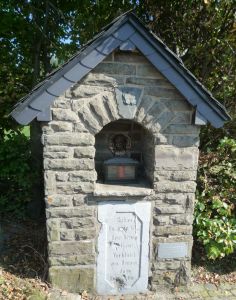
A wayside cross in Vossenack, riddled by bullet holes
When the battle hardened US forces, which were sent in first, had been so reduced that they became combat ineffective, the US command decided not to retreat from the forest. Instead, they sent in inexperienced, green recruits, which led to even more casualties.
The US soldiers were forced to blast tank routes into the rocks which were blocking the small path along the steep slopes. Often enough, tanks lost their tank tracks or slipped down the slope or were even pushed down by soldiers when they became useless. It was quite easy for the highly mobile Germans with Panzerfausts and improvised rocket launchers to spot and attack targets and then to disappear into the woods again, while the Americans had difficulties to spot any targets at all. Due to the high trees, mortar or artillery support was also often unavailable to the US forces because of the danger of tree bursts.
The US 1st Army estimated that they were opposed by roughly 5,000 men, with almost no artillery and no tanks at their disposal, but opposing to the US belief that these Germans were weak and would retreat soon, they successfully stalled the US advance for months. In fact, they faced two full German divisions (275th and 89th), coupled with elements from the 6th Panzer Division when the 28th attacked. In addition, they had no fewer than 15 artillery battalions blanketing the area. Over the course of time, the Germans ended up throwing in 6 divisions into the battle, suffering a total of about 28,000 casualties. Control over towns like Vossenack switched about 28 times between both sides.
…and today

The villages were rebuilt from scratch after the war, there are almost no historical pre-war buildings left. This is the rebuilt church of Vossenack
While the mountainous dense forest may be a very idyllic sight today, and the area is marked as a climatic health resort, the villages in the Huertgen Forest are not very attractive.
Not much was left of Vossenack, Kommerscheidt or Schmidt after the battle, so all villages had to be cleared of mines and rebuilt from scratch. If you see these villages today, you cannot believe that you are visiting 500 years old towns – they almost exclusively consist of faceless new buildings in typical 50’s style. There are no lively village centers, old buildings, or the typical half-timbered Eifel houses (as for example in picturesque Monschau). The small Hürtgenwald villages appear very contemporary and somewhat cheerless. The fact that we entered Kommerscheidt on a Sunday afternoon, when all streets were deserted didn’t help, so we got the impression of entering a ghost town.
The surrounding National Park Eifel is a beautiful recreation area with old timber work villages, seas, old volcanoes, forests, and mountains. The closest historical towns are Monschau and Nideggen. Especially Monschau is well worth seeing and very popular among tourists from Belgium, France, and The Netherlands, so if you visit the Huertgen Forest, you should also visit Monschau, the Rur dams, and the NS Order Castle Vogelsang .
Siegfried Line

Translation: “Siegfried Line – enter at your own risk!”
In the entire region between Aachen and Monschau, you can see the dragon teeth of the Siegfried Line (German: “Westwall”). There is even a 12 km long “Westwall Wanderweg” (“Siegfried Line hiking route”) which leads from Simmerath in the Huertgen Forest to Monschau. Here, you can walk on and along the Siegfried Line, which is a must if you are a battlefield tourist.
The dragon teeth are still intact today, simply because it is too expensive to remove the massive concrete objects. Many are situated in private gardens, front yards or along the road and fields because people simply built around them. You are kindly advised by signs not to enter private backyards and gardens when following the Siegfried Line, but there are enough dragon teeth in the open for everyone to see and touch and climb.
When we came to the Huertgen Forest, our first stop was in Lammersdorf near Simmerath where the “Westwall Wanderweg” begins. There is a small parking lot, just large enough for one car, and a wooden sign showing the direction of the Siegfried Line next to the road. You can’t miss the teeth, though – they are everywhere along the road.

Walking along the Siegfried Line

Dragon Teeth are everywhere along the road

Size comparison
More photos in our photo gallery!

Important! The museum only opens on Sundays from 11am – 5pm!
We then followed the route for a while, walking on the concrete bunker constructions of the Westwall which leads through fields and along a small rivulet. The dragon teeth here are overgrown with moss and plants, but you can freely walk between them, which is quite interesting and feels weird because you begin to realize that building them was such a weird project in the first place. If you think about the endless rows of dragon teeth, hundreds of kilometers long, you cannot help but start wondering what an immense effort it must have been to build them.
Vossenack Hürtgenwald 1944 Museum

Mines are dangerous even today – before you build a house in the Huertgen Forest, you have to call a bomb disposal team to clear the ground
After returning from our walk along the Siegfried Line, we drove to Vossenack to visit the Hürtgenwald Museum. The museum is maintained by honorary volunteers and only open from March-November and only on Sundays (!) between 11 am – 5 pm, so time your visit well!
When we reached the museum, we were surprised about how lively it was, outside and inside. There were many cars in the parking lot, coming from all over Germany, Belgium, the Netherlands, and even Great Britain.
The entrance fee is moderate, 4 Euros for an adult (5 Euros if you take a guided tour, but guided tours are only offered occasionally, so we couldn’t join one). There is also a field hospital bunker which can be visited for an additional fee of 3 Euros, but since the entrance to this bunker is in the cellar of a private home, it is only open from time to time (one hour on Saturdays, I guess). The museum also offers guided military tours for schools, groups, or English tours for army personnel from other countries, but these have to be booked in advance, so it is quite difficult to get any official guide in the Hürtgenwald Museum. We explored the museum on our own.
The museum staff was very helpful, though; there was a bearded army retiree who was in charge that Sunday and he explained to us how the museum works and invited us to the annual Remembrance Walk and BBQ next weekend.
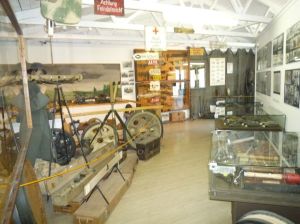
Much to discover in the Vossenack museum
In the museum, you can watch a documentation about the Hürtgenwald in a cinema room. We watched for a few minutes and the documentation “ You enter Germany – Bloody Huertgen and the Siegfried Line ” was very good with lots of original footage, eyewitness reports and detailed information about the backgrounds. Since the documentation was about 90 minutes long, we then decided to buy the DVD (it was sold at the museum entrance, it is in German and English and well worth the money!) and watch it at home. If you can get your hands on a DVD, you should buy it (you can even order it from amazon.de because it is region free).
We then followed the circular route of the Museum which strongly reminded us of the Oorlogsmuseum 1944-45 in Arnhem . The museum displays findings from the area – German and US weapons, ammunition, mines, equipment. You can see uniforms and private possessions of soldiers, documents, and photographs. There are vehicles, tank tracks, parts of shot down aircraft, helmets, wall signs, and all kinds of things from the era.
The history of the battle is depicted on large wall charts with maps, everything is bi-lingual in German and English. There were many visitors from other countries, especially Americans, in the museum and the atmosphere was very open and friendly.

The museum displays findings from the forest and donated equipment from both sides

German hand grenades
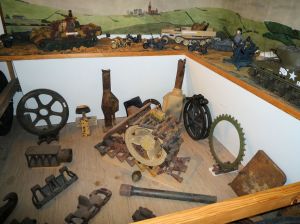
Tank components can be found in the forest even today

Various types of German and US bombs and ammunition

Light mortar
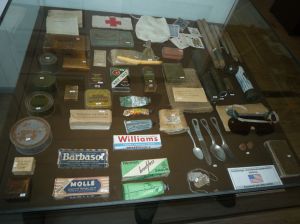
US equipment
Visit our photo gallery for many more museum photos!
We spent about 2 hours in the museum and then we left to visit the actual battlefield.
Vossenack church and cemetery

Inside the church
We left our car at the museum and walked to the Parish Church St. Jozef in Vossenack. The church was completely destroyed during the battle and re-built after the war in a semi-old fashion. It is a Fatima pilgrim church containing a Madonna consecrated in Fatima and she is supposed to work miracles. Accordingly, the walls around the Madonna, who is located in the church entrance, is full with expressions of thanks by people who were helped by her in times of need. The new church bell was sponsored by the Windhunde panzer division and its chiming is meant to be a “reminder of peace”.
The church was the scenery of heavy fightings during the battles for Vossenack. On several occasion, control over the church was split in half between German and US soldiers, one faction shooting from the hall, the other from the sacristy or bell tower.

A cross, made from shrapnel
Inside the church, there is a huge colorful church window which was donated by the Windhunde division, together with a memorial plate remembering the war. On the church door, there is an inscription remembering the 68,000 Americans and Germans who were killed, wounded, fallen ill, captured, or missing in action during the fightings in and around Vossenack.
Behind the church is the church cemetery. This cemetery contains several war memorials, one directly behind the church commemorating the dead of both World Wars.
The most important and most impressive memorial is the crucifixion group in the central part of the cemetery. It is quite expressive and shows Jesus on a large crucifix who extends one arm to the desperate people below (two of them being Mary and John the Baptist). The inscription plate says: ““MEMORIAL FOR PEACE 8.5.1945 – 8.5.1985 – Remember the Dead – they’re asking for peace“. It was created by the Franciscan monk Laurentius Englisch and funded with donations.

The WWI – WWII memorial behind the church

The most famous memorial: The Crucifixion group
Down the Kall trail
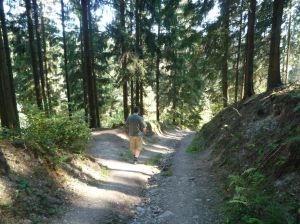
Following the Kall Trail is very illuminating
Following the descriptions in our guide-book, we left the cemetery through a gate at the far end. After crossing some faceless village streets, we left Vossenack and reached a small path winding through fields of corn and cow pastures. Our guidebook hinted us at a small way cross with a base perforated by bullet holes. Watch out for it, it can be easily missed!
Vossenack is located on the back of a woodless hill, surrounded by pastures and fields. From the fields, you could see the dense, dark forest below which fills the steep valleys between Vossenack, Kommerscheidt, and Schmidt. On the opposing hill, separated by a deep valley filled with dense forest, you can see the village of Kommerscheidt (Schmidt isn’t visible from Vossenack). After passing some more cows, a signpost showed us the way to the forest entrance and to the Kall Trail.
The Kall Trail (it was named by the US soldiers) is a small, steep, rocky path leading down to the small river Kall deep below in the valley. Then, after crossing the Kall, the path winds up another hill, equally steep, equally rocky, up to the village Kommerscheidt.
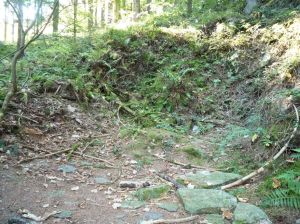
This foxhole was the place of an US aid station, which was left alone by the Germans
Beginning in November 1944, the 112th US Infantry Regiment used this trail to press on towards Schmidt, but they neglected recon and so they missed the fact that the initially broad and comfortable way at the forest entrance soon changed into a small, steep path which was almost impassable for heavy equipment and tanks (it is even difficult to walk down there on foot). The US soldiers were stalled on the path and only with greatest efforts, they managed to move at least some tanks and equipment down into the valley and across the Kall river. For the Germans, these efforts could be easily disturbed with small ambushes and constant hit-and-run attacks.
The path soon became so narrow that engineers had to blast away massive rocks which blocked the way down. The blasted-off blocks of rocks are still visible between the trees below the path today.
In addition, the path was very muddy and it became impossible for the tanks to turn around on their axle, so driving along a curve was highly dangerous. Driving forwards and backwards in order to maneuver around a curve led to the destruction of armor tracks. In the end, many broken tanks were simply pushed down the steep slope to the left of the Kall trail, where they ended as wrecks.
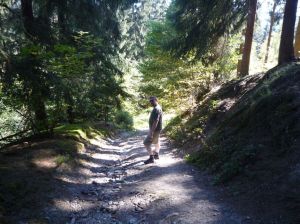
The Kall Trail is very steep and rough
Walking down the path is difficult and exhausting even today, in sunny, dry weather and without enemy fire, and the path is so steep and narrow that we had difficulties to imagine how tanks were moved downwards at all – in the winter, in the mud (and later snow) and with rocks blocking the way. Walking down the original path was very illuminating indeed and is highly recommended because you will get a quite lively impression of the difficulties the Americans faced in 1944. Watch out, though – the rocky path is quite difficult to walk and you need good shoes with a good grip if you plan to follow the Kall Trail.
If you are handicapped, there is also an “easy way” down to the Kall river today, a paved road from Vossenack which leads to a popular tourist attraction next to the river Kall, the Mengener Mühle (Mengener Mill) where you can eat and drink, but fortunately, the original Kall trail is still intact and in original shape as it was in 1944.

Down in the Kall valley
Halfway down the trail, our guide-book brought a point of interest to our attention which could be easily missed: a foxhole, several meters up the steep slope to the right of the trail. We climbed up the slope and discovered the hole which was hidden among trees. A small wooden remembrance cross – the same type of crosses we saw everywhere across Arnhem – was left next to the place. This foxhole was originally hidden under a tarp and heavy logs which protected it from the air bursts. It served as an US field hospital where wounded from both sides were treated. Sometimes, German and US medics worked side by side. This aid station was left alone by the German Army during the battle after they had checked out that the US medics were unarmed.
Following the Kall Trail down, we crossed the new paved road several times where wanderers, mostly families with buggies, were on their way to the Mengener Mühle. From time to time, we met other battlefield tourists from several countries, which could easily be recognized by the Hürtgenwald books or maps they held in their hands.
After a while, we were down at the deepest part of the Kall valley, several hundred meters below our starting point. Next to the river, we could see the Mengener Mühle, which had changed ownership during the war several times. It had served as a German and US HQ, field hospital, and supply station. We didn’t visit the Mühle, but continued to follow the Kall Trail to the famous bridge.
Kall bridge
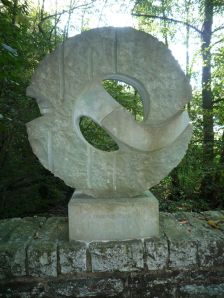
Memorial on the Kall bridge: “A Time for Healing”
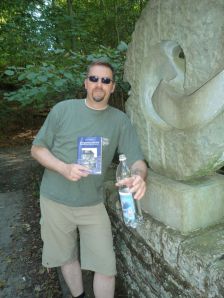
The Huertgen Forest Battlefield Tourist can easily be recognized by his maps and guide books
The Kall stone bridge was built by US forces who needed this bridge to move their tanks over the small river. The original bridge was destroyed during the war and rebuilt after the war.
In November 2004, a memorial was placed on the massive bridge railing: “A Time for Healing”, together with an information board in English and German. The information board describes the historical events which took place on this bridge from November 7 to 12 in 1944. Here, German regimental doctor Captain Dr. Stüttgen managed to negotiate an inofficial ceasefire with the US forces to treat all wounded from both sides at the bridge. During the armistice, German paramedics took care of all German and US wounded soldiers on and around the bridge.
After the war, Dr. Stüttgen was honored by the Governor of Pennsylvania. A painting of the event called “A Time for Healing” can be seen in the Museum of the National Guard. A copy of the painting is in the Vossenack museum.

An information board tells the story of the Kall bridge
Up the Kall trail

Reading background information

US Armor tracks
After crossing the Kall bridge, we followed the Kall trail up the next hill which leads to the village of Kommerscheidt. The way is as steep and rocky as the way down and quite exhausting.
Half way up is another point of interest: US armor tracks, melted into the road. In this place, three trapped US tanks were destroyed by the Germans. The German soldiers were very happy when they discovered that the tanks were full of supplies: field rations, chocolate, cigarettes, cookies, and meat cans. One soldier, a young company runner who became friends with his US counterparts after the war, remembered that they discovered a tin with unknown stuff inside… which tasted quite good. After the war he learned that this were crunched peanuts and when he met the US soldiers on a veteran meeting for the first time, the tank commander brought him a box of peanuts as a present – something he never forgot.
On top of the hill, near the village Kommerscheidt and next to a mountain shelter, is an overlook with a small bank, perfect for taking a break. Here, you have a perfect view over the Kall valley and the dense forests between the treeless hills.
Kommerscheidt
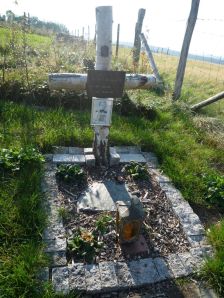
The grave at the village entrance
At the entrance to the village Kommerscheidt is the grave of US Staff Sergeant Lemuel H Herbert. The grave is decorated with a cross and a photo, but it is empty today because Herbert’s body was transferred to the US after the war. Still, the grave is well-kept and serves as a memorial today.
We entered the village of Kommerscheidt and were somewhat underwhelmed. This isn’t Kommerscheidt’s fault, of course, the village is about 600 years old, but it was the site of a heavy tank battle and almost nothing was left from the original village. Today, it is another faceless, 50’s style village without a city center or anything of interest – besides large single-family homes. We came to the conclusion that building a house in the Hürtgenwald must be quite cheap because all houses are somewhat oversized and built in weird villa or mediterranean styles, together with large properties and gardens. Since the area is still mined and you have to check for explosives before building a house, the Hürtgen Forest appears to be a popular living place or satellite suburb for commuters or young families without much income who work in the cities of Aachen, Düren or Nideggen, where property is much more expensive.
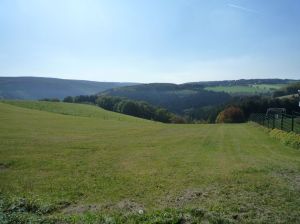
There and back again… a look into the steep, densely wooded Kall valley
Unfortunately, we were under the wrong impression that the tour we had picked from our guide-book was a circular tour – in Kommerscheidt, we discovered that our tour ended with a description of the tank battle. So we realized that we were trapped in Kommerscheidt – our car was still in the parking lot in Vossenack, which was located on the next hill. We had a direct LOS to the village, but – historically accurate – we were separated from our destination by a valley filled with dense forest and a steep Kall trail…
We decided to check for a bus back to Vossenack, but the first problem was that there were no natives anywhere… the streets were deserted, apart from another couple with a Hürtgenwald guide-book, who looked as lost as we did. We walked up the main street and discovered a young girl who stared as us with surprised eyes. When we asked here for the next bus stop, she was quite confused and stammered something about her school bus. We then discovered the bus stop in front of the only (closed) pub in Kommerscheidt and had to learn that there are two busses a day, destination Schmidt, and the last bus left hours ago.
There was only one choice left: We had to walk back the entire Kall Trail to Vossenack, down to the river and up the rocky, steep slope to Vossenack…
Vossenack War Cemetery

The Windhunde Memorial near Vossenack

Dead soldiers are never alone…
It was 5 pm when we reached the parking lot and the museum (which was closed by then). It was too late to visit the Ochsenkopf, another valley filled with dense forest, and to visit the memorials and bunkers which are located there. We decided to visit at least the two war cemeteries before dusk.
The Vossenack War Cemetery is located outside Vossenack on the strategically important “Hill 470”. This hill was the scenery of heavy fightings and changed ownership several times during the war. There is a lookout next to the road where you have a great view over Vossenack and, if weather permits, you can see as far as the area around Cologne.
The cemetery contains the remains of 2347 Germans. 100 of them are members of bomb disposal teams who died after the war when defusing mines and explosives.

This cemetery has a very special history. German Captain Julius Erasmus went to the Huertgen Forest after the war, after he had lost his entire family in the Battle for Aachen, and was shocked by the bodies of dead soldiers lying around everywhere in the woods. It preyed on his mind, so he began to identify and bury them by himself, searching the burning woods and active minefields for bodies and burying them near the forest edge. When he had buried 120 dead soldiers, the village of Vossenack allowed him to use the village cemetery.
In the end, Julius Erasmus (who soon went by the name “Totengräber von Vossenack” = “Grave-Digger of Vossenack”) had buried 1569 dead soldiers on his own. He wrote down the names and dates of the dead, drew maps of their burial places and marked all graves with simple wooden crosses.

In 1949, the war cemetery Vossenack was built on Hill 270 and all dead German soldiers were transferred there. The administration of Vossenack offered Erasmus a house in the town, but he preferred to remain in his small wooden hut in the forest, close to the cemetery. He died in 1971. A memorial at the cemetery entrance commemorates his work.
Many soldiers in this cemetery were never identified, so the inscription on their gravestones is simply “Unknown soldier”.

A curiosity: The grave of Generalfeldmarschall Walter Model who committed suicide in April 1945
In front of the cemetery is a parking lot. From there, we first went to the “Windhunde Memorial” next to the cemetery. The 116th Windhunde Panzer Division installed a monument with the inscription “ Tote Soldaten sind niemals allein, denn immer werden treue Kameraden bei ihnen sein ” (“ Dead soldiers are never alone because their comrades will always be with them “). Information boards next to the memorial tell the story of the 116th Division with photos and text (which is, unfortunately, written in German only).
The graves on the Vossenack war cemetery are marked with simple stone plates on the grounds. Two soldiers share a grave and a stone. The most prominent person buried on this cemetery is Generalfeldmarschall Walter Mode l who committed suicide in April 1945 (still convinced of the superiority of National Socialism).
The atmosphere on the cemetery was quite peaceful but somewhat grim, due to the heavy black basaltic stones which were used for the crosses and for the central memorial.
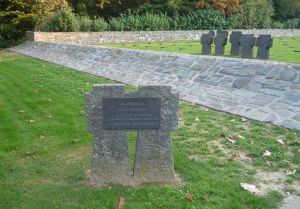
Remembering Julius Erasmus, “the grave-digger of Vossenack”
Hürtgen War Cemetery

The Lt. Lengfeld Memorial

“Kameradenkreuze” or “Comrade-Gravestones”
We then drove to the War Cemetery near the village of Hürtgen. It was built on the largest minefield in the entire Hürtgen region, named “Wilde Sau” (wild sow). The cemetery contains the remains of 3001 dead, among them 2925 German soldiers, 35 civilians, 27 Russians, 13 Polish, and 1 Belgian. 560 dead are still unidentified.
The shell limestone gravestones on this cemetery are quite remarkable: They are built as so-called “comrade-gravestones”, consisting of two adjoined crosses each.
At the entrance is a memorial for German Lt. Friedrich Lengfeld, sponsored by veterans of the US 4th Inf. Division in 1994. On November 12, 1944 Lt. Lengfeld tried to rescue an American soldier who was laying wounded in the Wilde Sau minefield and was crying for help. In his attempt to rescue the American soldier, Lengfeld was also severely wounded and died shortly after.

Huertgen War Cemetery
The cemetery is not as symmetric as other cemeteries, but is built inside an idyllic little forest with curved rows of crosses. When we left the cemetery, it was getting dark already.
There is still much to discover in the Huertgen Forest, for example bunkers, the village Schmidt, and the Ochsenkopf valley where several US and German memorials are placed deep inside the forest. So one day, we will certainly visit the Huertgen Forest again!
Visiting this battlefield was very interesting and the battle is still very present everywhere in the forests and villages. You have to plan your trip carefully, though, if you want to visit the Vossenack museum which is only open on Sundays from Spring to Autumn, and you need a good guide-book and maps if you want to find all hidden places and memorials (or a local guide, which is even better!).
With some preparation, a trip to the Huertgen Forest will be a very impressive and vivid experience!
And don’t forget to visit our photo gallery with many more photos from this great trip!
Share this:
This entry was posted on November 7, 2011 at 11:08 am and is filed under HFC On Tour , Historical Sites , Museums , Visiting Battlefields . Tagged: Eifel , Hürtgenwald , Huertgen Forest , Kall Trail , Kommerscheidt , Monschau , Rur , Schmidt , Schwammelauel , Vossenack . You can follow any responses to this entry through the RSS 2.0 feed. You can leave a response , or trackback from your own site.

54 Responses to “Visiting Battlefields: The Huertgen Forest and the Siegfried Line”
Dennis M.Quinn said
My father was in the 83rd ID, 330th Infantry as a 1st Lt. ( battlefield commissioned). He was transferred from Luxembourg in Dec. ‘44 just before the German attack through the Ardennes. He was already wounded in France in July that year and returned. He never spoke much about the Huertgen campaign other than the bitter cold and the artillery tree bursts. He eventually made it to the Elbe river at the war’s end.
chuck dewire said
I would like to tour the area that the 9th ID was in during the month of September 1944. My grandfather was wounded September 24 near Lammorsdorf. Can anyone provide me names of and contact information of people that conduct tours of that area.
Andreas Ludwig said
Zeitreisen-Eifel are conducting guided tours of the area and there is in fact a tour around Lammersdorf as well so that may be particularly interesting for you.
Check it out here: http://www.zeitreisen-eifel.de/index.php?id=63
Contact via email is: infoATeifel-tipp.de
I don’t know if the guided tours are also available in English, though so you better get in contact with them to be sure.
Doug Mitchell said
The Zeitreisen are good, but hew to a specific route and schedule every time. If you’re interested in an in-depth look at 9th ID and their role in VII Corps’ initial press into the Westwall in September, I’ve supported several family groups and individuals related to 9ID during their adventures here in Europe, as well as military field studies covering their campaign. Took the family of a 9ID (60IR) soldier KIA in the Hürtgen (buried at Henri Chapelle) back to the site of his last firefight in 2017. Feel free to drop me a line at . I’m a former Marine living in a former recon command post directly on the Bulge front lines. For a look at how I roll, you can check out the numerous photo galleries of my field recon and private tours posted to Facebook : https://www.facebook.com/doug.mitchell.399488
Contact : doug dot mitchell at t-online dot de
Mr site stevens said
Visited the area in July, we followed most of what you wrote about,it was very informative. Thank you. Made our trip to the hurtgen very interesting as we reenact the 4th infantry. Very emotional.
Steven Foremaster said
Has the location of the “Wild Sow” (“Wilde Sau”) minefield been established?
Anonymous said
Here’s a doubly useful link, directly answering your question and providing a future resource for answering other site-related battlefield questions :
http://en.tracesofwar.com/article/51094/Westwall—Former-Minefield-Wilde-Sau.htm
This second link provides more specifics :
http://wikimapia.org/33538493/Minefield-Wilde-Sau
Richard Beaumont said
I will be visiting the Hurtgen Forest in Sept. 2016. My uncle, whom I am named after, fought with the 9th Infantry Division, 60th Infantry regiment, Company F. He went in at the start of the battle in Sept. 1944 and his unit was evacuated due to high casualties in late October. He won the Bronze Star for his actions which I now have..he passed away 2 years ago. I made a promise to him that I would visit where he fought. He mentioned the towns of Monschau, Duren, Hofen, Germeter, and Alzen. I would love to hire a guide for Sept. 24, 2016 to navigate this area where my Uncle’s Division fought. Can anybody help me? Thanks Richard Beaumont
Richard… Doug Mitchell here, a professional battlefield guide in the region. Full-time American ex-pat, former USMC, currently renovating the wife’s ancestral family farm into a B&B for folks such as yourselves. We’ve hosted numerous vets & family over the years. Know a great deal about the Allied border campaigns between Sept. ’44 & Mar. ’45 (I live in a former 106th ID during the Bulge). In addition, I’m well connected with local experts in the border regions from the Alsace up to Market Garden. I can get you straight to the real story in the Hürtgenwald — and anywhere else you may have in mind. Drop me a line at doug dot mitchell at t-online dot de for a consult.
Harry D Stumpf said
My name is Harry D. Stumpf. I heard about a Hurtgen Memorial weekend taking place the last weekend in September 2016 from Yuri Beckers, the webmaster for the 9th Infantry Division website, who is currently travelling. I would like to make a train reservation now from Brest, France, to the event but don’t know the exact time or place. My dad was with the 39th Infantry Regt of 9ID. Can you help me find specifics on the Hurtgen Memorial weekend please?
Denny Koch said
Hello Harry, I tried to find out more about the mentioned Huertgen Memorial weekend, but I didn’t find anything. The local websites of Vossenack and the other Huertgenwald communities offer some guided hiking tours at the end of September (for example, following the Kall trail), but there is no information about a Memorial weekend. Do you have any additional information (for example, in which village the event is taking place or who organizes it?).
Best regards, Denny
Just a follow up comment to answer the open question : Harry DID find the memorial event (hey Harry), known informally as the “Sons & Daughters” weekend, and organized by a small group of my German colleagues. The primary organizer is a fellow named Albert Trostorf, recently recognized by the US Ambassador for his many years of service to the history of the Hürtgen campaigns, as well as Stolberg, Aachen and anywhere 1st ID (in particular) fought during WWII. In fact, I’m producing Sunday’s program in 2017, working with my fellow officer in the 106th Infantry Div. Assoc., Belgian Carl Wouters to show this year’s group what happened to the youngest (and most isolated) American division in the Bulge : The Golden Lions. Turns out, Harry’s also related to a high-ranking officer who served with the 106th for a time…
Cheryl Hildebrand said
Hello! My father was in the 5th infantry and was wounded in Dudeldorf on March 4, 1945. My brother, husband and I are traveling to the area to try and trace his path as closely as we can. As both my parents are gone, we are trying to research more about the exact areas my Dad was at – as he was an officer, we actually have his map of the area and we are trying to decifer what the notations mean. I would love to have more information on the possibility of hiring a guide for our two days in the area, November 26 and 27th of this year. Please contact me with any information you can share and availability of guides etc to my email, [email protected] or my brother at [email protected] . Thank you!
Hello Cheryl — didn’t spot your query above until now (Feb. ’17), but I’m dropping you a quick line by e-mail anyway, just in case…
Andrew said
Anyone know anything about the 2nd Ranger battalion, they were with the 8th infinity? My father was wounded twice there but he refused to go home and went back to the front lines to find his men because they were getting wiped out and it is amazing that he lived through that and that is why he is my hero and I am sure that you all have the same kind of story of your fathers. That is why America was great, but it doesn’t have people like them anymore and that is why we are a failing nation and I don’t have any hope in the youth at all….I am dying trying, its all I have left to do the right thing and honor my father and all of your loved ones….United We Stand, God bless America
John Duzac said
That is so right Andrew. My father was there too. He went through the entire Battle of the Bulge and was badly wounded about two weeks before it ended. Dad spent 10 months in a hospital in England. Had when home and raised two sons. Sadly, dad passed away with Pancreatic Cancer on January 29,2015. Two months before he died, he was awarded a 100% disability from the VA.
Andrew, your father sounds pretty amazing and you should be very proud of what he and his Soldiers accomplished. However, I would head caution when making statements about “we don’t have people like that anymore.” This current generation of Soldiers, sailors, Marines and Airmen have been at 15 years of continuous war! Now everyone in the military is a warfighter, but I can assure you that the still are those that fight and sacrifice just as much as any of those from any past war. I can personally attest to this as I carry more names on my wrist-bracelet than I care to think about and have spent my fair share of countless months in the mountains and deserts of our current conflicts. Our great nation is only faltering due to sad-state of affairs of our politicians that call themselves leaders. And while I myself question the competency of this very youngest of generations with the “safe-zones” and cyber-bullying, I would argue that any such problems could be fixed if the OLDER generations helped LEAD the younger ones.
2nd Rangers were the “hired guns” brought in to deal with the heavily fortified hilltop at the eastern end of Bergstein (above the northern end of the lower Kall valley) known to the Amercans as “Hill 400”. There’s a marvelous viewing tower there today, with great views westward back into the southern edge of the Hürtgen campaign area.
Janine Miller said
I wonder if Kall Bridge is what my dad talked about. He was in the Hurtken Forest battle, and said they Germans allowed wounded Americans to leave, and that no one wanted to lead them out, so he got up and started for a bridge. He had to pass a German soldier, who allowed him to pass. Others took courage and followed. By the time he got to the bridge, he wasn’t leading anymore, bc they had mostly overtaken him. One of his wounds was in his leg. So, this must be the bridge, unless there were any others around at the time. I never knew quite how to picture it when he told his war stories to us. He is gone, now, or I would have more questions for him, for sure.
I forgot to mention he was captured, and it had to do with the Germans not wanting to deal with the wounded, so they let them go.
Janine, he was most definitely describing the Kall Bridge. The fighting down in the valley between Vossenack and Kommerscheidt was bloody and difficult, and a ceasefire was organized so both sides could collect the wounded and deceased. A nice summary is actually included in the article atop this page :
“The Kall stone bridge was built by US forces who needed this bridge to move their tanks over the small river. The original bridge was destroyed during the war and rebuilt after the war.
In November 2004, a memorial was placed on the massive bridge railing: “A Time for Healing”, together with an information board in English and German. The information board describes the historical events which took place on this bridge from November 7 to 12 in 1944. Here, German regimental doctor Captain Dr. Stüttgen managed to negotiate an inofficial ceasefire with the US forces to treat all wounded from both sides at the bridge. During the armistice, German paramedics took care of all German and US wounded soldiers on and around the bridge.
After the war, Dr. Stüttgen was honored by the Governor of Pennsylvania. A painting of the event called “A Time for Healing” can be seen in the Museum of the National Guard. A copy of the painting is in the Vossenack museum.”
Roberta Conroy said
My father was a Lt. in the Army 4th Infantry division and never got over losing men and shooting at young German boys. Hurtgen Forest was brutal. 200% mortality for 4th Infantry? In my professional life, I became friends with a German Deutsche Bank exec and we learned that our fathers were in the same battle at Hurtgen.. but I believe his father was a very senior Nazi officer–he didn’t want to talk but one has the same name. My dad landed at Utah.. but the current put them in the wrong place but they figured it out. His most powerful story for me was that he came to the main camp at Dachau (after liberating at least one subcamp) a day after it was evacuated. He said he could smell it and as they arrived the German soldiers fled into the trees but left the German Shepherds charging the fence at the Americans. They had to shoot all the working dogs and this disturbed my dad. . Kid lesson: Not all dogs the same, be careful. Recommend reading If you Survive by George WIlson. A link to this book and others: http://lions44.hubpages.com/hub/BestWWIIMemoirs
4ID were here in my neighborhood both before and after their turn in the Hürtgen — in fact, they liberated my tiny German border village of Großlangenfeld (ß=ss) on 12 Sep. ’44. The second time was at the tail end of the reduction of the Bulge, when 4ID & 90ID pressed the Germans back into Germany in this area. Interesting factoid, since these two specific American infantry divisions were also first ashore at UTAH on D-Day. If you’re ever headed to Europe with an interest in exploring 4th’s campaign, feel free to drop me a line.
Karl Metz said
Denny thank you so much for this interesting journey.I will be visiting this soon and you gave some good information.I am from the Netherlands with German roots and moved to the Eifel a year ago.Although I served the Dutch royal Marine corps for 23 years my family had its history in the Wehrmacht.My Granddad never came back from the Eastern front and I feel proud to say that I made it as first in my family after the great war to be back in military again.I always had the strong need to search and discover about the WW2 history and in particularly the battle of the bulge…I guess my military past will let me watch very carefuly when I walk the trail
Karl, thank you very much for your feedback! You have quite a biography, very interesting!
The Eifel is a great place to live and travel, we travel there a lot, since there are not only interesting WWII locations, but also many ancient Roman sites, like temples, villas, and industrial sites like aquaeducts and quarries (Ancient Rome is our second great passion besides wargaming 🙂 )
I’m glad our Huertgenwald travel report was useful for you! When you go to Vossenack, remember to visit the place on a Sunday because that’s the only day of the week the museum is open to the public. If you can read German, you should also take Rainer Monnartz’ tour guide “Hürtgenwald 1944/45” with you, it’s a good book which offers some suggestions for short and long tours through the area.
Since you are interested in the Battle of the Bulge, we also travelled the Ardennes extensively. Did you discover our two Battle of the Bulge travel reports yet? (Part I about Luxembourg and the Eastern Ardennes, Part II about Bastogne and the Western Ardennes). If you are interested in this battle, we highly recommend visiting Luxembourg (which is also comfortably close to the Eifel!).
Enjoy walking the Kall trail, I’m sure that your military background will reveal more information to you than to the average hiker. There is a lot to discover left and right from the track!
Sorry for the late response back Denny.Had computer problems and work also took a lot fro my time.I bought a house in Spangdahlem which near a US Air Force base.Anyway,I now live in Baustert only 15km from Luxembourg.I lived in belgium for some time during my service and saw a lot there already.But as the battle of the Bulge came forth out of the West wall offensive I guess this is the next part in reseaching ww2.I am going this Saterday for the first time.I made a plan what I want to visit first.Next time another part..for me it is only 80 km drive so not to far.Checklist ready for things I will need.I will look for the book.My german is good so that will not be a problem.Denny if you ever are back in the Eifel then let me know.You are always welcome and maybe we can look for some things..I know spots in Bitburg which leads back to the Roman empire..also Templars has my interest so I bet we would have some fun..
Are you still living here in the region, Karl? Curious, did you visit the Friedhof (with Kriegsgraberstatte) in Bleialf in 2016? My Eifel wife crossed paths with a Dutch fellow much like yourself who was there while trying to reack down a relation in late summer 2016.
Denny would this hike down and back on the Kall Trail be too much for 4 guys in their advanced middle age years in ok shape but w/ back problems? What is total hike time with stops to view artifacts included. We will be in the area in late Sept this year. Thanks for any advise.
Some parts of the Kall trail are quite steep and rocky (especially the first part down from Vossenack to the river), most are moderate or unproblematic (in the river bed and the way up to Kommerscheid).
I would suggest hiking down on dry weather, since the steep parts will be slippery and muddy after the rain. In any case, you should wear hiking boots with a good profile. The worst part can be skipped by using the road along the Kall river, but that would rob you of the authentic experience of following an incredibly rough path and wondering how it was ever possible to traverse it with tanks. In addition, you can find medic foxholes in the woods along the steep parts of the trail, so you should definitely try to follow it.
I cannot judge how back (or knee) problems will impair you on the more difficult parts of the trail, but the worst parts are not too long and if you go slow and take it easy, it’s manageable. It’s not alpine or anything, just a narrow, slippery, steep path through a dense forest.
Using a guide book is also highly recommended, or you could overlook some of the sights hidden in the forest (if you can read German, I highly recommend “Hürtgenwald 1944/1945” by Rainer Monnartz with tour recommendations and good descriptions.
You should also keep in mind that the Hürtgenwald museum in Vossenack is open only on Sundays. Before starting down the Kall trail, visiting this museum is highly recommended, it’s well worth seeing!
All in all, if you go slow, watch out for sights, stop at the info boards, and enjoy the surroundings, the Kall trail will take about 4-5 hours from Vossenack to Kommerscheid (2 if you walk straight and fast, as we did on our way back).
I hope you will have a great time and an enjoyable visit!
George B said
My father Jean B. Beaumont was in the Huertgen Forest with the US 8th Infantry (Pathfinder) Division, Company C. At one point they were pinned down by artillery fire (leveled all the trees), and he passed out from the cold and shelling in a foxhole. He was removed from action for a time and then returned to combat. Eventually made it to the outskirts of Berlin, I think. Most of the small towns were completely blasted. He always remembered his buddies that didn’t make it out of the meat grinder. George B.
Denise said
My father was also in the Huertgen Forest w/the US 8th Infantry Div., Company C, 1st Medical Battalion. He was a medic. His name was Glenn C. Jones, or “Doc”, and was originally from Kansas. Most of what I have learned has been through family members, reading and research, as he would never talk about his experiences in WWII. I believe he was also removed from action once, injured by shrapnel once, and briefly captured once. He landed at Normandy on July 3rd or 4th, 1944. Did you know the 8th liberated the concentration camp at Wobbelin ? Just thought I would share. Denise J. C.
Thank you Denise (and George of course – just saw his comment, WP didn’t send me a notification or I missed it) for reading and commenting on our article. We are always glad if folks find our tour reports interesting enough to comment on 🙂 This is a wonderful way in our opinion that we can all learn and grow, we are all bound together due to the experiences of our fathers and/or grandfathers – even more so because we all were once ‘the enemy’. Luckily these days are over…
Antony said
On the topic of “The reason why this region and the Battle of Huertgen Forst are almost unknown to the average German citizen is…”, I live about 50 miles from Colditz Castle. And none of my German neighbours had heard of it. They were amazed when I told them how well known it was in the UK.
Manfred Gerten said
Yes, correct, in German Schools after 1945 no history about the past, only the future.
Quote: Eric Harmon
“May 3, 2013 at 5:28 am Your sight on the Hurtgen Forest is great but I would recommend a few corrections. The German strength was far more than 5,000 men. US forces believed that was their strength but in reality it was two full division (275th and 89th) coupled with the 6th Panzer Division when the 28th attacked. They had no fewer than 15 artillery battalions blanketing the area. The Germans ended up throwing in 6 divisions suffering a total of about 28,000 casualties.”
Eric, thank you for you reading and for leaving your really helpful comment! I integrated the information into the article – hopefully, I now got the numbers right!
Susan Horton said
My father in law was hurt on October 11, 1944. Could you tell me where I could get more info on the October remembrance activities. Thank you.
Hi Susan, thanks for visiting our website! If you want more information on the annual October remembrance activities, you can visit the website of the “International Huertgenwald Marsch” webite here (available in German and English!): http://www.huertgenwaldmarsch.de/lkdo/index.php/en
I’m living near Düren and would like to show and walk with you in the Hürtgenwald. If you are interested you can reach me via mail [email protected]
best regards =)
JU–I was in the area with the Band of Gamers trip three weeks ago. We stayed in Simonskall, which has the remains of a bunker a short walk from our hotel. Should we return on a future trip, I will try to contact you.
Michael said
I enjoyed reading the article and found it to be one of the most indepth, detailed accounts of the Huertgen Wald today. Are any of these sites, or other Westwall locations easily accessible by train? I’m currently living in Germany (Duesseldorf) on an academic exchange and would love to visit these locations. Unfortunately I don’t have access to a car. Thanks in advance for any help you can offer.
Visiting the Huertgenwald with public transport is very difficult. The closest train station is the city of Düren, from there you have to take a bus to reach Vossenack. It’s very easy to get to Düren from Düsseldorf, but from there, things get complicated.
There is a regular bus line from Düren to Vossenack (286), but the Hürtgenwald Museum in Vossenack (which is a must see if you want to tour the Hürtgenwald) is only open on Sundays (11-5), and unfortunately, the bus rides only twice a day on Sundays… which would result in quite an odyssey.
I would highly recommend spending a night in the area, for example get to Vossenack on Saturday and spend the Sunday visiting the museum and walking the Kall trail. The Kall trail is easily reached from Vossenack, it’s only a short walk from the museum and the village center (and Vossenack is a very small village!).
You can find the bus hours here:
Click to access Busverbindung%20Linie%20286%20%20D%C3%BCren-Vossenack-D%C3%BCrener.pdf
The Hürtgenwald museum is only open from March till the end of November, so you should also consider making your trip in Spring or Summer.
And, to be honest, I have no idea how to visit the Siegfried Line with public transport. The area around Simonskall, between Monschau and the Hürtgenwald is veeeery rural.
McGowan said
Folks 1 thing about the Famous Kall Bridge.Its a very small bridge you cant really call it a bridge,And i still dont understand what was so special about it.My Family and i visit the Hurtgen region almost every 4 weeks,Due to its beauty. My children love to play in the kall by the bridge,and its only a few Centimeters deep,And its not a River as people call it, its just a small stream.soldiers and tanks could of crossed it without using the so called bridge.But the entire region is a beautiful place to be.But also the Hurtgen forest itself is Enormous.you also have some small bridges there at the Weisser wehe and Roter Wehe.(Death Valley by Paul Boesch). Another great place is 1,5 mile NE of Lammersdorf the Buhlert forest you will find over 30 Pillboxes(Bunkers) and alot of foxholes,And if lucky you can find some M1 Garand clips and other Ammo.I have found many war relics in and around the Hurtgen forest,with a Metal detector ofcourse. But be carefull when moving away from the footpaths and into the forest,Even without a metal detector you can find live ammo,And shells. For those that have seen the movie When trumpets fade the movie is good but dont expect much on the Kall trail,You wont find a large bridge and a wide river, but other thing are still visible on the Kall Trail. For me the Hurtgen is the place to be if you are interested in WW2.But now many years later the entire region is breath taking.I also forgot to Mention Hill 400 outside Bergstein Another great hill to visit and 2 bunkers.
PS for those Metal detecting You will have your hands full by clearing Bomb frags the entire forest in scatterd with it,And sometimes it can piss u off! I do respect those that died in the forest,And i always leave things tidy.Back in 2009 i recoverd a German soldier and he was re-buried with full honours at a cemetary near Germeter.And that did me good.
Yes, the area is an interesting one and just impressive nature. The problem with tanks and soldiers crossing the river, even if not really deep, is the fact that it’s difficult terrain and there’s not much room to maneuver so a bridge no matter how small was certainly helpful. And we shouldn’t forget it was not the way we experience the Kall trail now in peace and sunshine, the weather was harsh and the area was heavily shelled by German arty and friendly fire alike. No tree in that area is older than 50 years…
Robert Kall said
Do you know why the trail, the bridge most every thing has the name ” KALL ” ?
yes, “Kall” is the name of the river within the deep valley in the Huertgen forest. The valley is also called “Kalltal” (Kall valley), and so the bridge crossing the river is named the Kall bridge – Bridge over the river Kall.
The river Kall originates in Belgium, close to the city of Monschau, and is a sidearm of the river Rur (Dutch: Roer).
Do you have any ideas where your name comes from?
Jim Pappas said
Thanks for posting this, it’s great. I made a whirlwind tour throught the Huertgen back in the early 90’s. I wanted to see some of the areas my Dad went through during the war. He was part of the 298th Engineer Combat Bn, and he spent way too much time in the Huertgen. At least he survived, and is still with us today.
If I ever make it back there I definitely want to see the museum. You’re right about the dragons teeth, pillboxes, and bunkers. You still see them everywhere. It’s kind of weird to see an old bunker being used for farm equipment storage.
Jim, My name is Bob Kipke. My father served with the 298th Engineer Combat Bn and I’ve built a website based on the units own publication, “The 298th Engineer Combat Battalion in Europe”. Over a number of years I’ve added queries and comments from other folks with connections to the unit. I just recently added the Official Journals of the unit. I try and add anything that has a distinctive connection to the unit.
Main http://freepages.genealogy.rootsweb.ancestry.com/~kipke/298army/298th1.htm
Query http://freepages.genealogy.rootsweb.ancestry.com/~kipke/298army/298connect.html
Journals http://freepages.genealogy.rootsweb.ancestry.com/~kipke/298army/298journal/298th_journal.html
I’m always interested adding anything related to the 298th if your interested in adding anything (e.g., bio, photos, queries, etc.)
I’ve been looking through your web site, it’s great! I will show it to my Dad, and I’ll get some info to send to you.
Please respond to my personal e-mail address posted on my website. Thanks
Please review the use of the terms, “Siegfried Line” and “West Wall.” The former never existed during WW2, and the latter was mostly dismantled by the time of the Rhineland battles.
@CF, for a “dismantled” installation, the Westwall is quite present all over Western Germany today. You can clearly follow the bunkers, dragon teeth, and walls from the Dutch border, up in the North (Niederrhein Region near Kleve) down along Aachen, Monschau into the far South to the France border. In some regions, the installations are overgrown and quite integrated into the landscape, in gardens and fields, so you have to know where to look.
In other places, you can clearly see and visit large areas where the Westwall is still very present and in perfect shape. Some parts in the Rhineland may have been dismantled, but the major part of the Westwall still exists and will exist in the future, simply because it is too expensive to remove the Höcker and bunkers. Locals learned to live with it and to integrate it into the landscape.
If you want to get an idea, I can give you the directions to the most interesting and impressing locations, so you can undertake a Westwall sightseeing tour.
Regarding the use of the term “Siegfried Line”, I simply used it as a colloquial synonyme for the Westwall which is widely in use and known among wargamers, so I’m sure our readers know what I was talking about.
Thanks for reading, Denny
Below is a direct quote from “THE HISTORY OF THE 298TH ENGINEER COMBAT BATTALION IN EUROPE JUNE 9, 1944 – MAY 8, 1945” “The mission of both companies was to occupy pillboxes in the Siegfried line to prevent the Germans from entering them.”
Leave a comment Cancel reply
- Already have a WordPress.com account? Log in now.
- Subscribe Subscribed
- Copy shortlink
- Report this content
- View post in Reader
- Manage subscriptions
- Collapse this bar
Skip to Main Content of WWII
Xix corps breaks through the siegfried line.
In a lesser-known operation that presaged the horrors of the deadly Battle of Hürtgen Forest, the XIX Corps broke through the Siegfried Line north of Aachen, Germany, in October 1944.
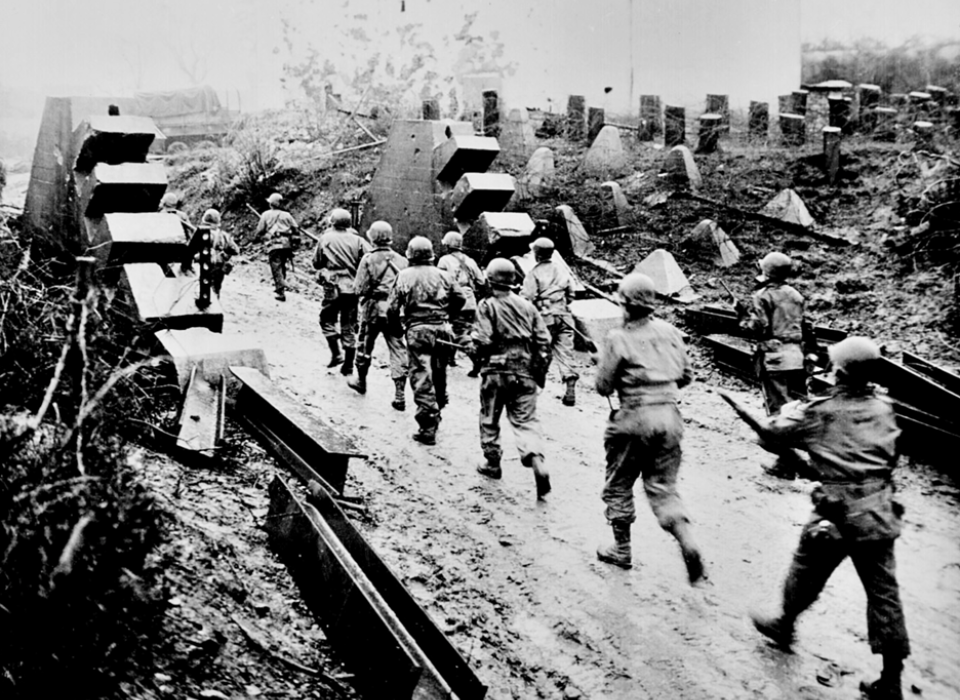
Top Photo: US troops marching through the remains of the Siegfried Line. Wikimedia Commons
After the Allied breakout during Operation Cobra in late July 1944, the previously static situation in Normandy exploded into a rapid pursuit of the routed German troops. With Paris liberated and Brittany secured, the Allies looked to the east, beyond the Roer and Rhine Rivers to the German frontier. Optimistic that the war could end before the new year, General Dwight Eisenhower ordered offensive operations all along the front line, which stretched from the English Channel to the Mediterranean Sea.
The Allies soon found that the logistic infrastructure could not sustain the speed of their advance. Planners expected before D-Day that the beachhead would expand gradually to the east as the troops fought their way off the beaches and through France. The complex hedgerow terrain frustrated these plans, however, limiting the Allied advance to yards per day. When the breakout finally took place at Saint-Lô on July 25, the front moved so rapidly that logisticians could not repair rail lines, roads, or pipelines quickly enough to keep pace. The lack of a functioning port along the Atlantic coast only made the situation worse.
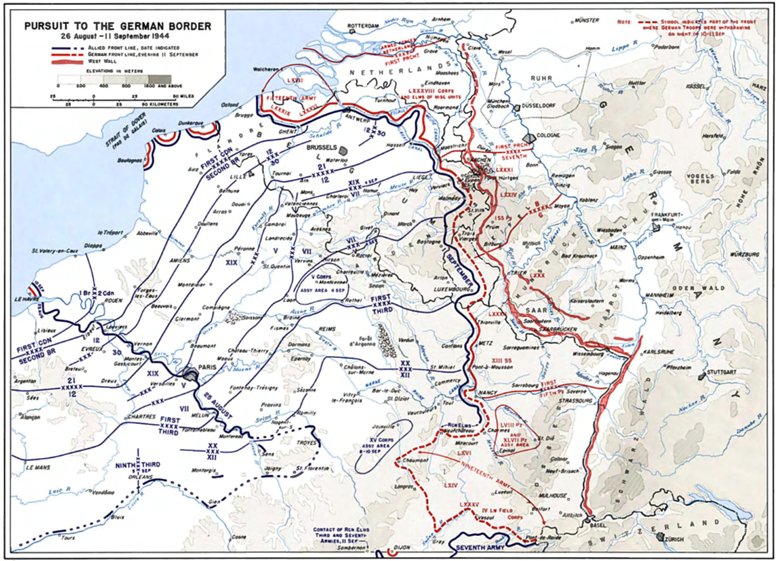
Pursuit to the German border. US Army Center of Military History.
Still, in September 1944 the situation favored the Allies, who advanced steadily, if slowly, in the face of hasty counterattacks conducted by badly understrength Wehrmacht units. By late September, however, the logistic situation grew critical, dispersal of forces made Allied attacks ineffectual, and the enemy began to recover. As the pace of the Allied advance slowed, the Wehrmacht prepared a powerful defense along the Siegfried Line, known to the Germans as the “West Wall.” This was the last line of defense standing between the Allies and the German frontier.
With fresh troops bolstering the defense of Aachen and a VII Corps attack south of the city stalled by a tenacious defense, Lieutenant General Courtney Hodges, commander of the First US Army, ordered a pause on September 22, halting offensive operations through the end of the month. The pause would give him time to reorganize his troops and develop a plan to resume the offensive in early October. To help in this effort, Lieutenant General Omar Bradley, commander of the 12th Army Group, ordered Lieutenant General William H. Simpson’s Ninth US Army to move from Brittany , France, into the line, taking up a position between the Third US Army to the south and First Army to the north. This shortened the First Army front, enabling Hodges to concentrate forces for a renewed offensive into the Aachen Gap, a stretch of armor-friendly terrain just north of Aachen, Germany.
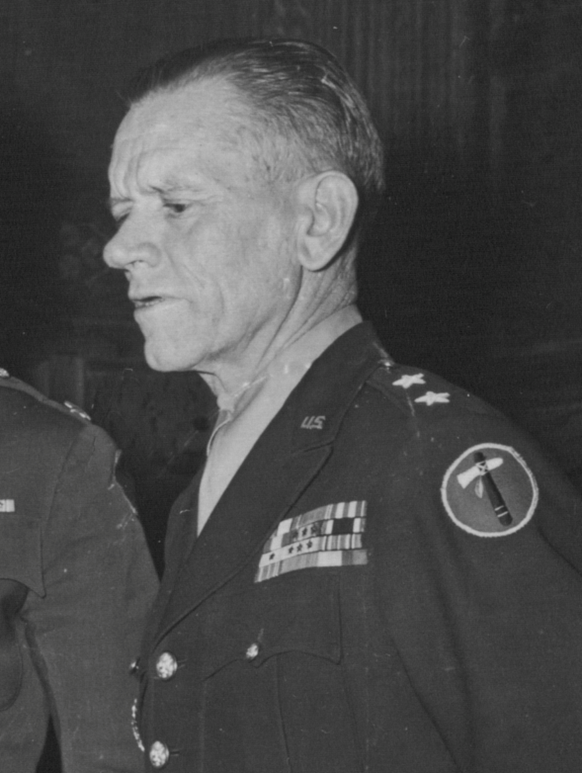
Major General Charles H. "Cowboy Pete" Corlett, XIX Corps Commander. Wikimedia Commons
Hodges ordered Major General Charles H. "Cowboy Pete" Corlett, commander of XIX Corps, to prepare for the offensive. The 30th Infantry Division, commanded by Major General Leland Hobbs, would spearhead the attack along a 14-mile front stretching from Geilenkirchen in the north to Aachen in the south. Hobbs’s troops would drive east to the Roer River and then south to Aachen, reducing the Siegfried Line, clearing the area of German troops, and linking up with the 1st Infantry Division on the northern edge of Aachen. The 117th and 119th Infantry Regiments would lead the attack, fighting abreast, with the 120th in reserve. The 29th Infantry Division, recently returned to XIX Corps command after the liberation of Brest , would secure the corps’ left flank during the offensive.
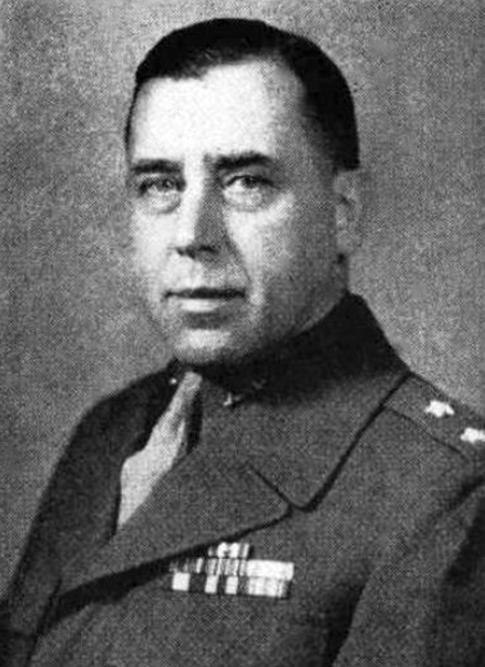
Major General Leland S. Hobbs, commander of the 30th Infantry Division. Photo: Wikimedia Commons
The Siegfried Line was a formidable series of obstacles intended to bolster the defense along the German border. Defending forces, protected by steel-reinforced concrete pillboxes, trenches, and other fortifications, overwatched these obstacles. Never intended to stop an attacker on their own, the Siegfried Line increased the defender’s survivability while slowing down attacking troops, increasing their exposure to machine gun, artillery, and antitank gun fire. Once they assessed that the attacker was weakened sufficiently, the Germans would inevitably counterattack.
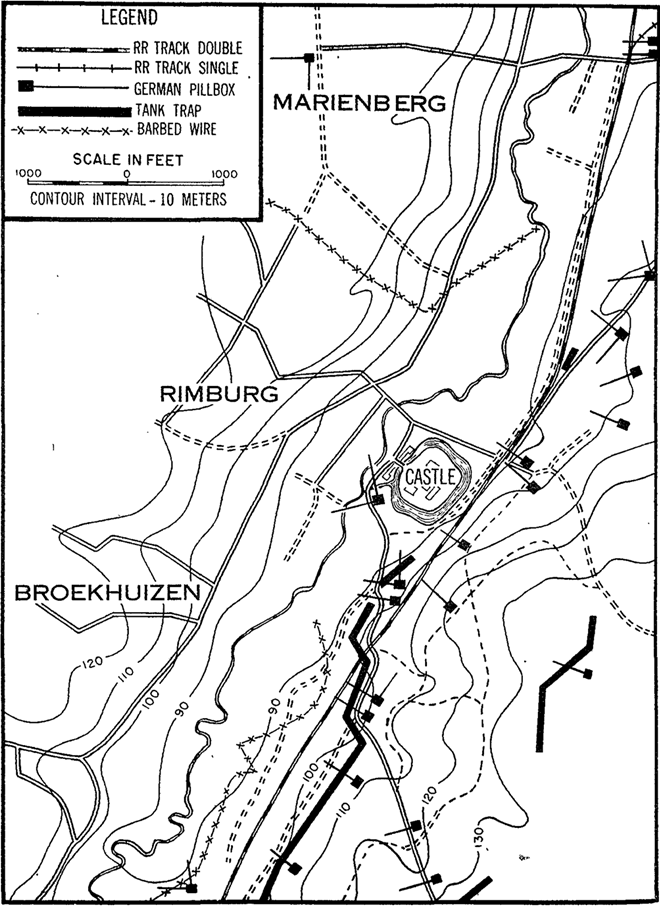
30th Infantry Division zone of attack. Leland Hobbs, “Breaching the Siegfried Line,” Military Review, Vol. 26, No. 3, June 1946
The Siegfried Line supplemented the natural defensive characteristics of the terrain. In the 30th Infantry Division sector, which consisted of relatively open terrain, the Wurm River presented the first natural obstacle. The Wurm was 30 feet across, with steep, muddy banks on either side, making it impassible to armor without combat engineer bridging support. Only a small portion of the line just north of Aachen lacked this water obstacle, so here the defensive belt included the only dragon’s teeth in the XIX Corps sector. Just to the east, a parallel railroad line ran through the Wurm River valley, further complicating the terrain. Finally, the center of the 30th Division sector featured a castle with a moat, situated in dense forest on hilly terrain. The Siegfried Line, three kilometers thick and dense with pillboxes, backed up these natural defenses.
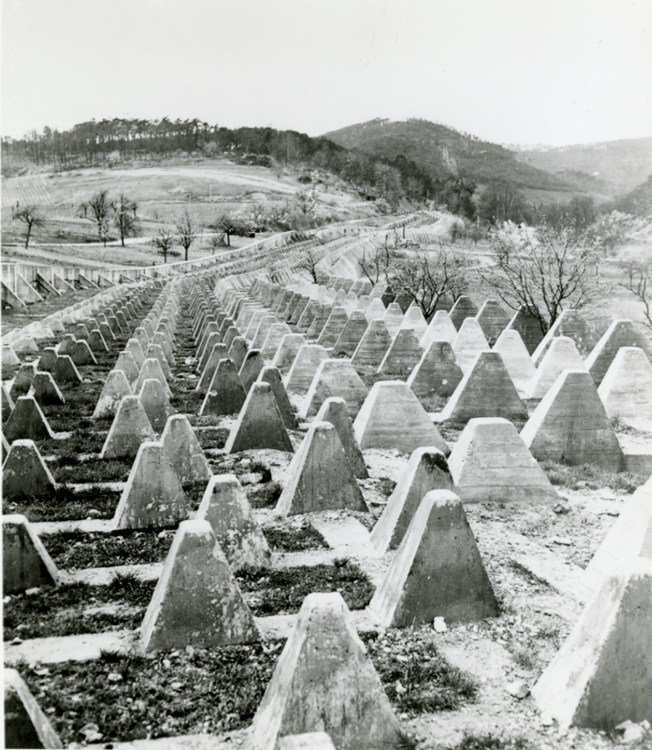
Dragon’s teeth, one of the most recognizable obstacles used in the Siegfried Line, near Wissembourg, France. Courtesy The National WWII Museum
The Germans built the Siegfried Line from 1939–40, so they designed the pillboxes around the most prevalent weapons of that time: the machine gun and the underpowered 37 mm antitank gun. This meant the pillboxes were too small to house more modern weapons like the feared 88 mm antitank gun. Still, they presented a serious challenge to the enemy, supplementing the trenches, foxholes, minefields, and antitank obstacles making up the defense.
To prepare, Hobbs rotated his troops out of the line in the period preceding the attack so that they could conduct training. Planners built a large terrain model—a detailed representation of the terrain and the obstacle belt—with each pillbox in its confirmed location. Soldiers prepared diligently, learning how to spot concealed or disguised pillboxes, and practicing detailed procedures for reducing them. This training was essential, enabling the GIs to react instinctively to the demands of the mission.
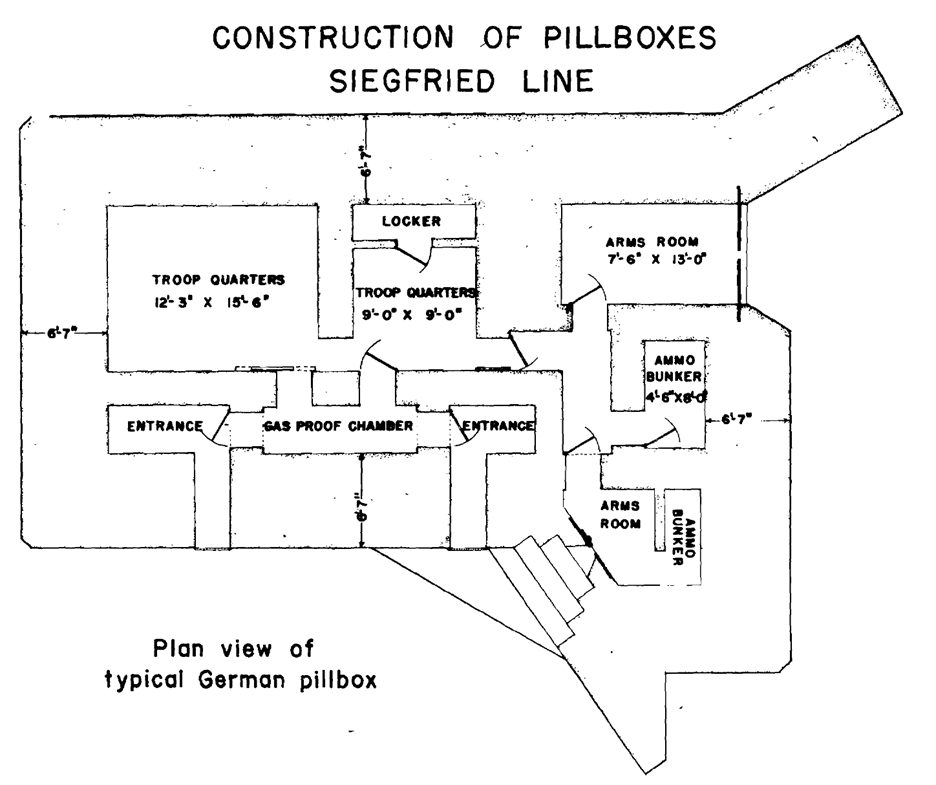
Plan view of a typical Siegfried Line pillbox. XIX Corps, US Army, “Breaching the Siegfried Line,” 12 January 1945, Combined Arms Research Library, Call Number N-7623.
Both field artillery preparatory fires and an aerial bombardment preceded the attack. Beginning on September 26, the 258th Field Artillery Battalion’s M12 155 mm self-propelled guns pummeled the German fortifications daily. Unfortunately, post-battle damage assessment revealed that only the 155 mm or 8-inch howitzer could penetrate the reinforced concrete pillboxes, and they could do so only after scoring three to five direct hits. Artillery proved effective mostly in forcing German defenders to remain in their pillboxes, or in causing the surrender of the demoralized occupants of a pillbox who experienced a direct hit. Therefore, after nearly a week of artillery bombardment, most of the fortifications remained intact.
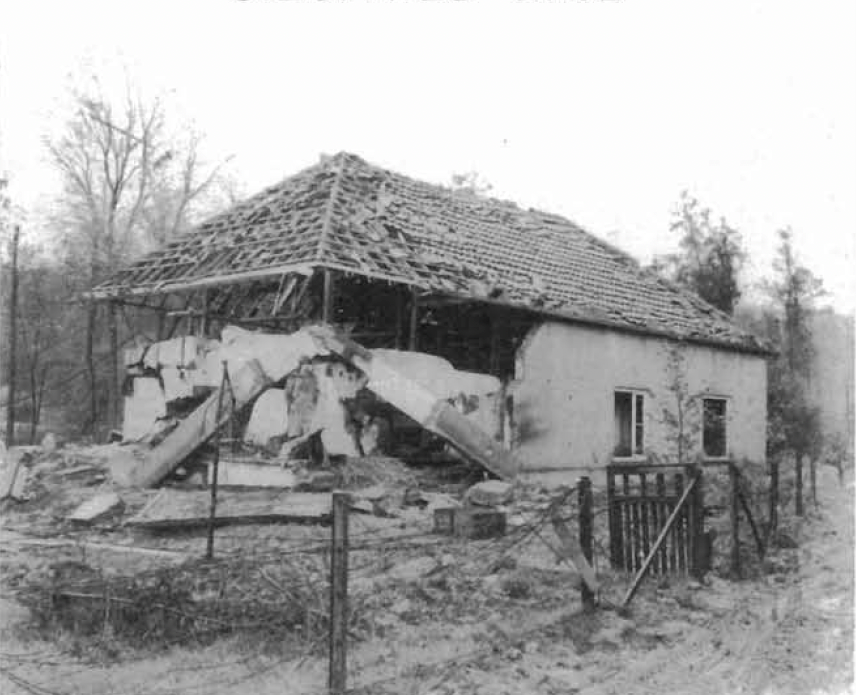
Camouflaged German pillbox. XIX Corps, US Army, “Breaching the Siegfried Line,” 12 January 1945, Combined Arms Research Library, Call Number N-7623.
On the morning of the attack, October 2, the focus of the artillery shifted to counter-antiaircraft (AA) fire in support of the aerial bombardment. The guns of both the XIX and VII Corps artillery targeted AA positions, their precise locations confirmed by aerial reconnaissance. These fire missions were highly effective at suppressing or destroying the AA batteries, resulting in zero losses of Allied planes. The results of the aerial bombardment were less impressive, however. Most of the medium bombers approached the target area from the west, rather than from the southwest, as intended. This created confusion among the bombardiers, most of whom did not release their loads. The fighter bombers dropped napalm on the pillboxes, aided by the placement of red smoke near their targets, but this, too, had limited effect. It would be up to the infantry and their supporting arms to reduce the fortifications in close combat.
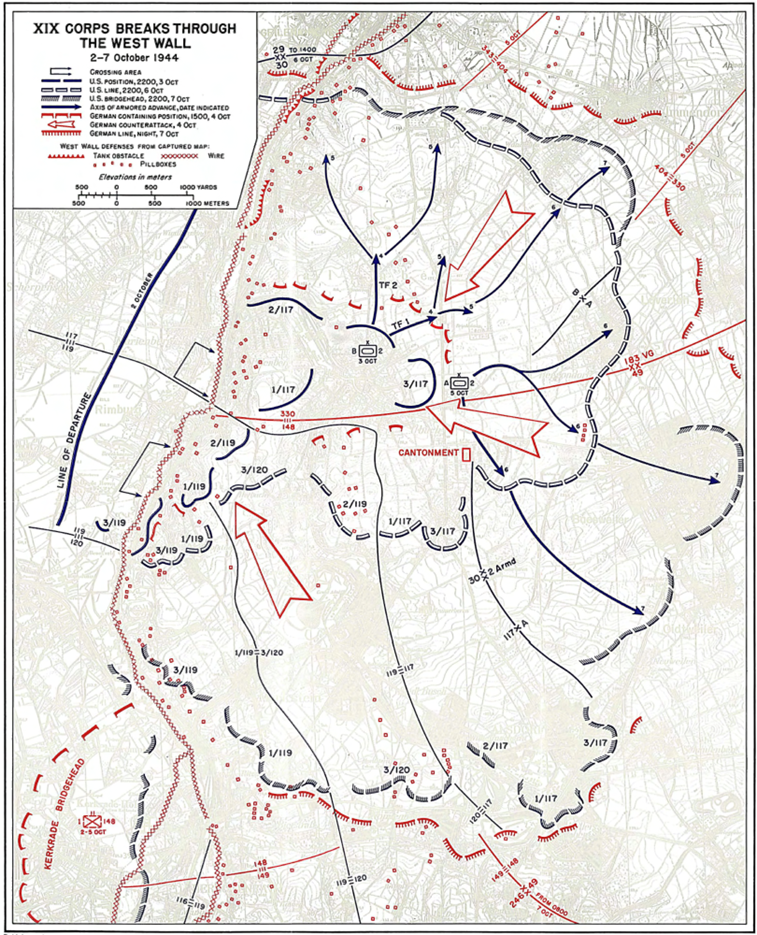
XIX Corps Breaks Through the West Wall, 2–7 October 1944. US Army Center of Military History.
The infantry assault began at 1100, with the 117th Infantry in the north and the 119th in the south. The GIs of the 117th rushed down the hill to the Wurm River under a hail of German small arms, mortar, and artillery fire. Engineers threw specially constructed footbridges across the river in minutes, allowing the infantry to sustain its momentum, minimizing the troops’ exposure to fire. Supported by self-propelled 155 mm artillery, the infantry began the work of reducing pillboxes. By the end of the day, the 117th reached Palenberg, its objective for the day, having reduced 11 pillboxes, without armor support, at the cost of 227 casualties.
The 30th Infantry Division intelligence officer reported after the battle that the pillboxes were:
"in clusters, all inter-supporting and sited to cover each other by fire. But due to the limited traverse of their fields of fire, there seemed to always be one at least in a group, which, if reduced, permitted our men to start a circuit of the remaining pillboxes, using approaches to each succeeding one that could not be covered by fire of the remaining ones. The problem of course, was to discover the key pillbox to each cluster. [1] "
For the 117th, attacking fortifications in the open, this was a relatively easy task. The 119th faced a tougher challenge, attacking up a steep slope into dense forest that was too damp to ignite with napalm. The trees made detection of pillboxes and enemy movement challenging, while making American artillery fire ineffective against the pillboxes. This forced the infantry to attempt a frontal assault into the forest, but German artillery intensified, with aerial bursts exploding in the treetops, creating deadly wooden splinters and making it impossible to install a bridge over the Wurm. The Rimburg Castle, surrounded by minefields and a moat and supported by observation posts on the high ground, further complicated the situation
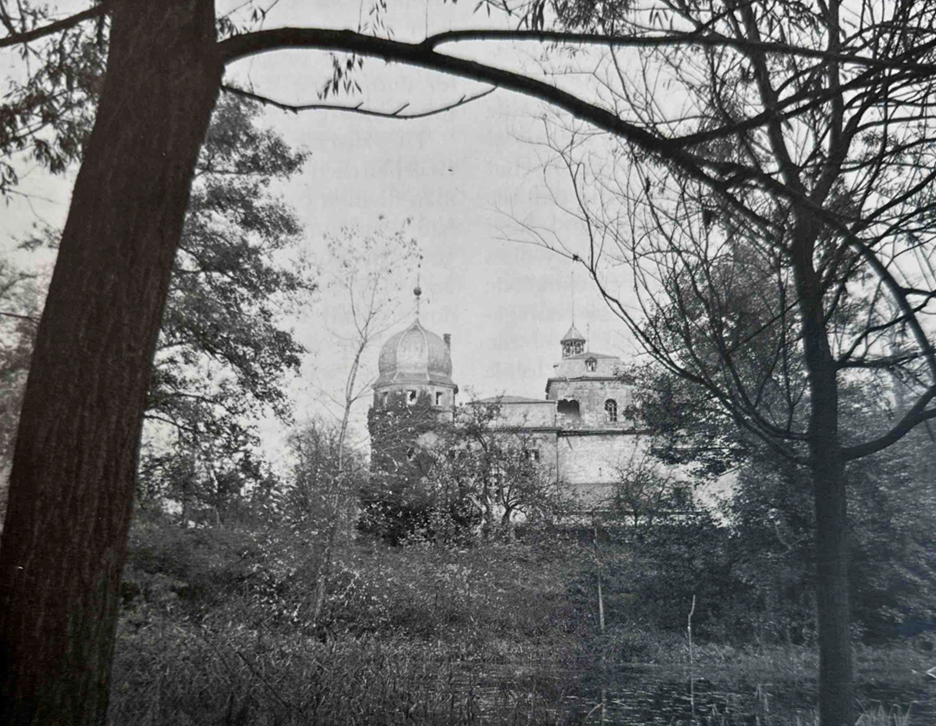
Rimburg Castle, moat visible in the foreground. XIX Corps, US Army, “Breaching the Siegfried Line,” 12 January 1945, Combined Arms Research Library, Call Number N-7623.
As the XIX Corps reported in its after-action report, “The mission of the 119th in breaching the Siegfried Line soon boiled down to the job of effecting a penetration of the woods, and then cleaning out the enemy . . . after close-in fighting with opposing lines rarely getting further apart than twenty-five to fifty yards.” [2] This delayed the 119th Infantry’s advance while greatly limiting the effectiveness of their artillery and armor support.
The 2nd Armored Division crossed the Wurm and joined the fight in the northern part of the corps sector on the morning of October 3. Predictably, the relatively open terrain enabled rapid movement of the tanks, which proved mostly impervious even to the most intense artillery fire. By the end of the day, armored elements pushed through and cleared the town of Ubach. German counterattacks began the next day, but despite experiencing the most intense artillery bombardments of the war up to that point, the infantry with their supporting armor beat back these attacks. Meanwhile, the 119th Infantry cleared the Rimburg Castle by the evening of October 3, pushing south of the castle to the railroad on the 4th.
With the 117th Infantry’s zone mostly cleared, on October 5 the focus of the attack shifted to the southeast. The 119th Infantry, reinforced by the 3rd Battalion, 120th Infantry, gradually pushed south through the woods. At 1330, Combat Command A of the 2nd Armored Division crossed the Wurm and passed through the 117th, rapidly extending the American lines to the east. The Germans launched their most powerful counterattacks on the morning of October 6, recapturing four pillboxes and forcing the 2nd Battalion, 119th Infantry, to retreat 800 yards with significant casualties. By nightfall, however, the infantry regained their initial positions as German resistance crumbled, although fighting continued until October 16, when the 30th Infantry Division made contact with the 1st Infantry Division just northeast of Aachen.
As noted in its after-action report, by October 16 the XIX Corps had destroyed the enemy positions of the Siegfried Line in their 14-mile-wide zone of attack, penetrating to a depth of six miles. Success was costly, however, especially in the south, where the 119th and 120th Infantry suffered about twice as many casualties as the 117th. Post-battle analysis revealed the difficulty of clearing the densely wooded terrain in the southern part of the corps sector. This should have informed planning for future operations, but it did not stop the Americans from attacking into the strongest portions of the Siegfried Line in the coming weeks.
Historians have argued that the Allies should have remained in the defense south of Aachen and mounted an offensive through the Aachen Gap. This would have sidestepped the Hürtgen Forest—with terrain much like that faced by the 119th and 120th Infantry—avoiding one of America’s longest and most costly battles of the war. The logic of Eisenhower’s broad front strategy, however, required Allied attacks to continue all along the line. Though intended to destroy the German army west of the Rhine River, this attritional strategy also increased Allied casualties and possibly delayed victory in the European theater for months.
References:
[1] XIX Corps, US Army, “Breaching the Siegfried Line,” 12 January 1945, Combined Arms Research Library, Call Number N-7623, 23.
[2] XIX Corps, US Army, “Breaching the Siegfried Line,” 12 January 1945, Combined Arms Research Library, Call Number N-7623, 17.
Additional Reading:
Robert W. Baumer, Old Hickory: The 30th Division, the Top-Rated American Infantry Division in Europe in World War II , Lanham, MD: Stackpole, 2017.
XIX Corps, US Army, “Breaching the Siegfried Line,” 12 January 1945, Combined Arms Research Library, Call Number N-7623
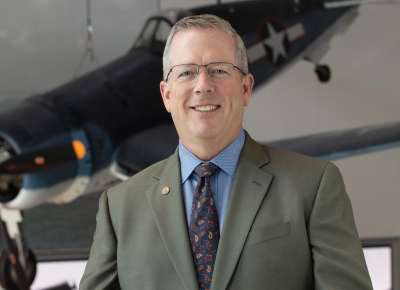
Dr. Mark T. Calhoun
Dr. Mark T. Calhoun is the Military Historian at the Jenny Craig Institute for the Study of War and Democracy.
All the Way: the 614th Tank Destroyer Battalion Cracks Germany's Siegfried Line, 1945
The African American 614th Tank Destroyer Battalion's aggressive assault across Germany's Siegfried Line in 1945 earned the respect and camaraderie of white GIs in the front lines.
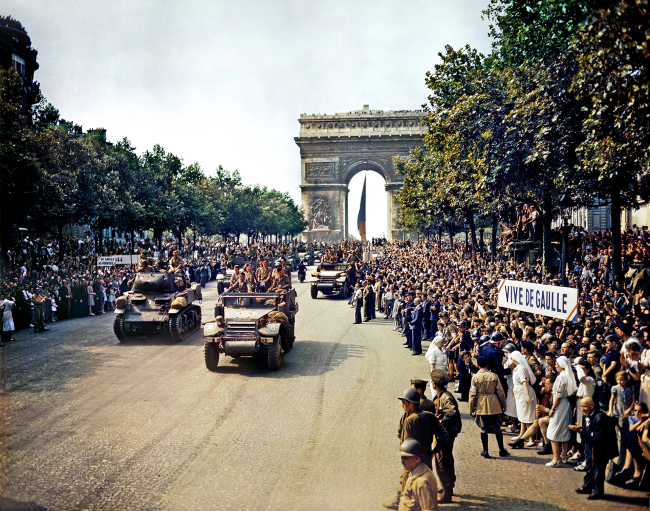
The Liberation of Paris
Despite the impending defeat of the Wehrmacht in France, the victory over Germany would not be complete until the capital of France was liberated, and the Vichy government replaced.
Explore Further
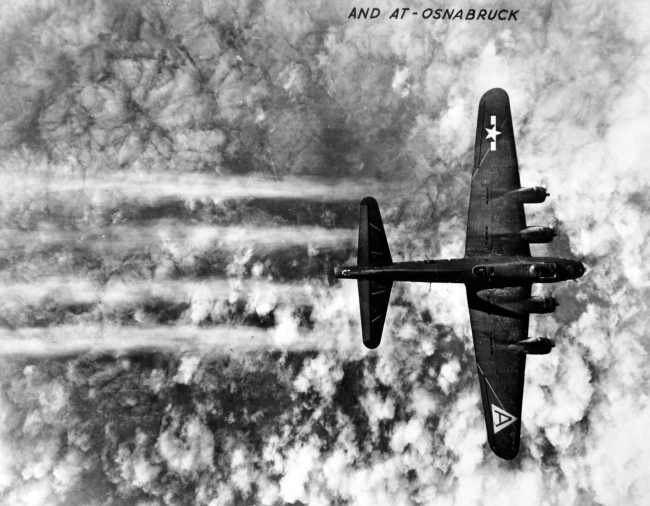
The Combined Bomber Offensive
When World War II began, both the US Army Air Forces and the Royal Air Force Bomber Command developed strategic bombing fleets aimed at destroying Axis morale and its ability to prosecute war.
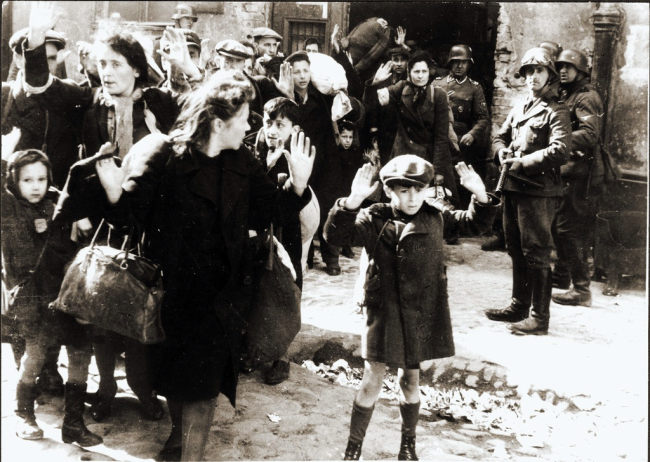
The Warsaw Ghetto Uprising
When the Nazis came to clear out the Warsaw Ghetto, they were met with fierce resistance.
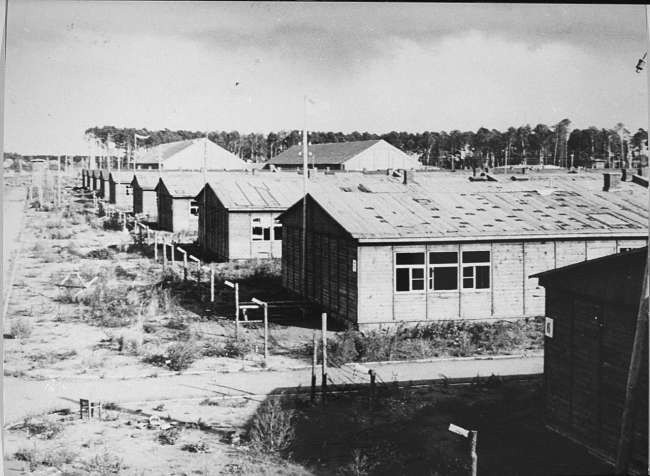
Stutthof Concentration Camp and the Death Marches
Stutthof concentration camp was among the sites of horror caught up in this gruesome crescendo to Adolf Hitler’s war for racial supremacy.
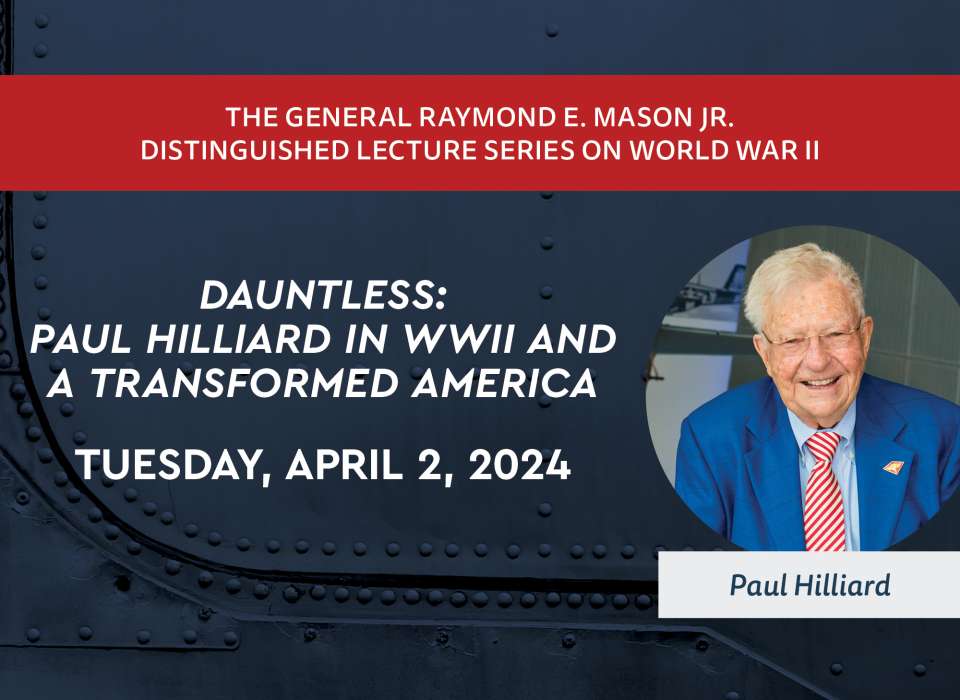
Dauntless: A Conversation with WWII Veteran Paul Hilliard
Visitors at the National WWII Museum had the special opportunity to hear from WWII veteran and Museum Trustee Paul Hilliard as he discussed his life story documented in the new biography, Dauntless .
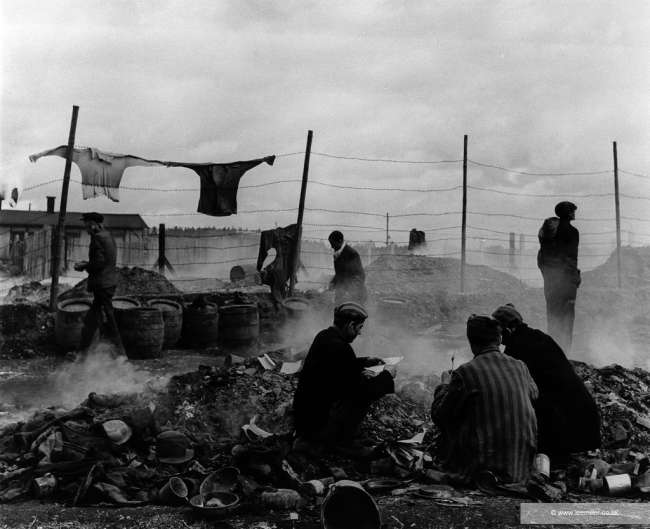
Lee Miller: Witness to the Concentration Camps and the Fall of the Third Reich
One of America’s only women war correspondents reports on the liberation of the concentration camps, Soviet and American troops meeting at Torgau, and Hitler’s burning villa in Berchtesgaden
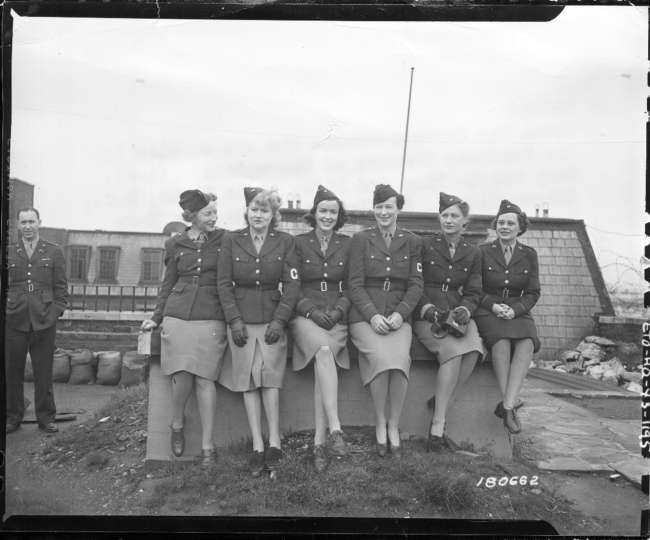
Lee Miller in Combat
One of America’s only female war correspondents reported on the aftermath of D-Day, the Battle of Saint-Malo, and the liberation of Paris.
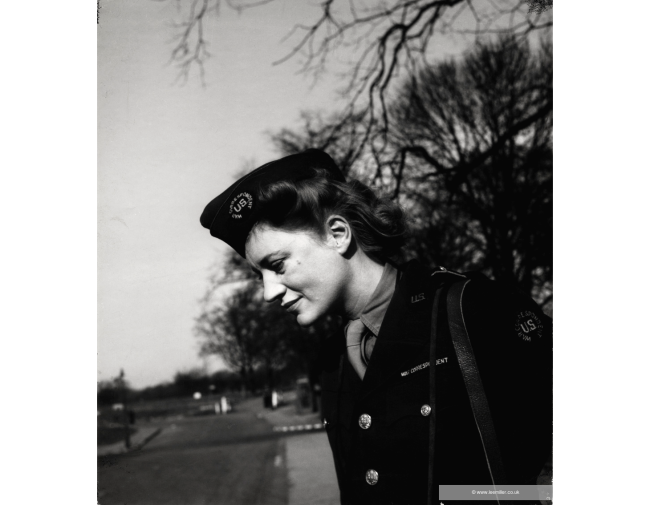
Lee Miller: Women at War
One of America’s only female war correspondents captured the war through women’s service.
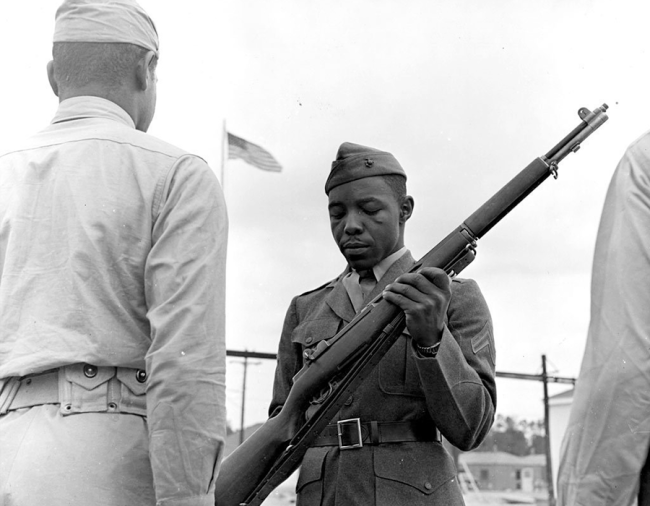
A Contested Legacy: The Men of Montford Point and the Good War
Despite their commendable service during World War II, the Marines of Montford Point would regularly contend with societal forces that vehemently resisted all measures taken toward racial integration.
White Cross Battlefield Tours
World War Guided Battlefield Tours – My guided tours cover the historical locations, associated with World War 2, in Belgium, Czech republic, France, Germany, Holland, Luxembourg and Poland

About Me WORLD WAR 2 BATTLEFIELD TOURS THE ULTIMATE WW2 BATTLEFIELD TOUR EXPERIENCE ! Hi ! – My name is David Martin. I am 57 years old and I was born in England. I live in Southern Germany. I
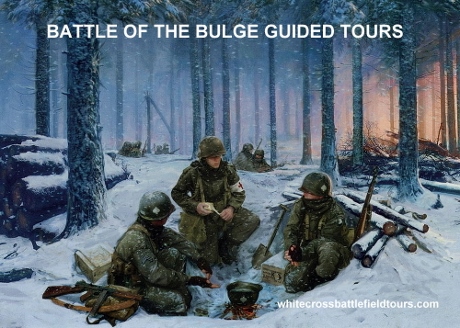
The Battle of the Bulge Tour
The Battle of the Bulge Tour On the 16th of December 1944, Adolf Hitler launched his last (major) Western offensive, to try and win the war in the West – codenamed “Wacht am Rhein” (Watch on the Rhine). This later
A Guided Tour with a Meaning...
My friends and I are also Battlefield researchers and we are always looking for new stories. I can show you many photographs and artefacts that we have actually found in the Ardennes forests of Belgium. Our intentions are to have memorials erected on the site of their deaths and to inform family members, who have no idea where their loved ones were killed in action. We have already achieved this and it is a very rewarding experience.
Book a Customised WW2 Battlefield Tour Today!
Imagine walking through a peaceful pine forest, in beautiful Bavaria, Southern Germany, surrounded by panoramic, stunning mountain and meadow views and replicating Hitler’s daily walk to have his lunch, with his infamous Nazi henchmen, secretaries and faithful German Shepherd “Blondi” at his side. Following in Hitler’s exact footsteps as we stop for lunch in the same location and admire the view, imagining what happened here all those years ago, as they chillingly discussed the invasion of Europe and the extermination of the Jews. A relatively unknown location !
Trans-Siberian Railway Prices
- Trans-Siberian Railway Tickets
- Trans-Siberian Railway Ticket Booking
- Trans-Siberian Railway Car Classes
- Travel Procedure
- Trans-Siberian Railway Route
- Guides & Gadgets

Home » Prices and Trans-Siberian Tickets » Trans-Siberian Railway Prices
Ticket prices for the Trans-Siberian Railway also depend on the current ruble exchange rate.
Is the Trans-Siberian Railway expensive?
Before starting on your Trans-Siberian Railway adventure you naturally want to know what the entire trip will cost. Although this sounds like a simple question, it is pretty difficult to answer. The Trans-Siberian Railway price of travel depends on the following factors:
- Which travel class do I want to use? The price for a first class ticket is about three times the price of a 3rd class ticket
- Am I willing to buy the tickets myself and assume responsibility for the organisation of the trip?
- How many stopovers do I want to make? The more breaks, the higher the total price.
- What sort of accommodation do I want? Will it be a luxury hotel or will a hostel dormitory be sufficient?
- What tours and excursions would I like to go on?
- What is the current exchange rate for rubles?
Basically, everything from a luxury to a budget holiday is available. If you buy yourself a 3rd Class nonstop ticket at the counter, a few hundred Euros will cover the price. All you will experience is a week on the Trans-Siberian train and will see nothing of the cities on the way. There is, however, any amount of room for upward expansion. Everyone makes different choices about which aspects they are willing to spend money on. I personally prefer to save money on accommodation and railcar class, visit as many cities and do as many trips as possible. To enable better classification of your travel expenses I have contrasted two typical traveler types. In the third column you can calculate the total cost of your own journey on the Trans-Siberian Railway. Please keep in mind that these are only rough estimations and not exact prices.
The all-in costs seem fairly high at first. However, they cover everything and it is quite a long journey taking four weeks. Many people forget to consider that when looking at the list. We should also deduct the running costs for food and leisure at home. I think most visitors to this page will classify themselves somewhere between the two categories, that is around the € 2,000 – € 2,500 range. When comparing these prices with other travel packages, you get the impression that it is hardly worthwhile travelling individually on the Trans-Siberian Railway. Please keep in mind that most packages last no more than 14 days and you are herded like cattle through the most beautiful locations.
If you spend less time on the Trans-Siberian Railway you will, of course, pay less. I chose this particular travel length because I prefer not to do things by halves. If you fulfill your dream of travelling on the Trans-Siberian Railway, enjoy it and don’t rush things. But it’s up to you, of course. Try playing around with the form a bit to find the appropriate price for your trip.
- Trans-Siberian Railway Tickets »

- TripAdvisor
- Testimonials
- Travel Tips
The Assumption Belfry and Ivan the Great Bell Tower
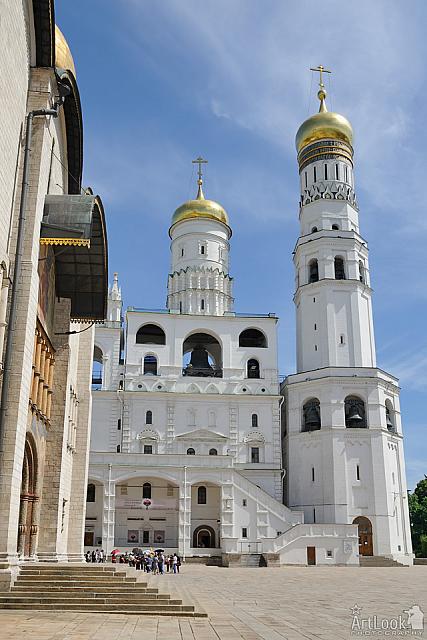
View from a corner of Assumption Cathedral on the architectural ensemble of the Assumption Belfry (at the left) and Ivan the Great Bell Tower (at the right) built in the Moscow Kremlin in 16th century. The tower’s name implies that it had once housed St. John’s Church, and that it used to be the tallest building in Moscow (height with cross is about 80 m). For many decades the bell tower was also the main watchtower in the Kremlin, and later also a fire tower. Petrok Maliy, the Italian architect who built the Kitai-Gorod wall in Moscow, started the construction of the church of the Resurrection, later renamed Church of the Nativity, next to the Ivan the Great Tower in 1532. Decades later was converted to a four-tier belfry for large bells, known today as the Assumption Belfry after its main 64-ton bell placed in the middle of the fourth tier. The Assumption bell tolled only on great holidays and to announce events of exceptional significance.
Photo #043 taken on June 29, 2016 during a tour of Moscow Kremlin with my dear client from Lebanon, Jacques Saade.
About Me in Short

My name's Arthur Lookyanov, I'm a private tour guide, personal driver and photographer in Moscow, Russia. I work in my business and run my website Moscow-Driver.com from 2002. Read more about me and my services , check out testimonials of my former business and travel clients from all over the World, hit me up on Twitter or other social websites. I hope that you will like my photos as well.
See you in Moscow!
- View full size
- Owner: Moscow Guide & Driver
- Date: June 29, 2016 05:14:00 am EDT
- File name: ALP-2016-0629-043-Assumption-Belfry-and-Ivan-the-Great-Bell-Tower-Moscow-Kremlin.jpg
- Tags: Russia , Moscow Kremlin , Kremlin Towers , Ivan the Great Bell Tower , Belfry , Assumption Belfry , Assunmption Bell , Moscow
GPS Location of the Photo
Google maps.
- GPS Map of this album
- GPS Map of Moscow Guide & Driver's pictures
Random image

Spectacular Fireworks Over Zaryadye Park
Moscow Day was celebrated with a spectacular fireworks display on Saturday, September 08, 2018, as part of the Russian Capital’s City Day. Festive fireworks were launched from numerous sites and were visible right across the capital. The view from Raushskaya Embankment on fireworks in the historical center of Moscow city launched from St.
Featured Tags
- 273 photos are tagged with architecture
- 199 photos are tagged with cathedrals
- 305 photos are tagged with churches
- 294 photos are tagged with Dear Clients
- 260 photos are tagged with lights
- 1875 photos are tagged with Moscow
- 306 photos are tagged with Moscow by Night
- 194 photos are tagged with Moscow cityscapes
- 264 photos are tagged with Moscow Kremlin
- 326 photos are tagged with night moscow
- 426 photos are tagged with Orthodox Churches
- 226 photos are tagged with Red Square
- 2538 photos are tagged with Russia
- 209 photos are tagged with twilights
- 350 photos are tagged with Winter
Take one of these exciting tours:
- Moscow Highlights
- Discovering the Golden Ring of Russia
- Arts & Culture Tours
- Moscow by Night tour

- Regent Seven Seas Cruises
Best of Moscow by high speed train
By shuguley , February 15, 2014 in Regent Seven Seas Cruises
Recommended Posts

Sure would appreciate someone who has taken "Best of Moscow by high speed train" from St. Petersburg could please share their impressions of this shore excursion. From the description this sounds like a very long day.
Wondering how the 4 hour train trip was in terms of accommodations, etc. Also what time did you leave the ship and what time at night did you return? Were both legs of the trip on the high speed rail (I read that slower trains also travel the same tracks)?
My wife and I are considering this excursion. We thought that if we are making all the effort to go to Russia then how could we pass up going to Moscow, walking in Red Square, seeing St. Basil, etc.
Link to comment
Share on other sites.
If you are considering this on the 2015 June Baltic cruise on Voyager; my suggestion is don't. There is so much to do in St. Petersburg and although a train is one of my favorite ways to travel the time would be far better spent in St. P.
Thanks for the advice. Yes, this would be on the Voyager during the 2015 season but not yet sure exactly which cruise.

We did the Moscow excursion "on a different luxury line", but from your brief description it sounds very much like the same trip, so I will operate on that assumption. It is a VERY long day! We left the ship at 5:30 AM and returned at 12:30 AM. The highspeed train trip is comfortable, and while they call it "Business Class" it does not compare well to the equivalent class on say Rail Europe. When we did it in 2011, we did have highspeed both ways, and the trip back seemed much longer as the adrenaline and excitement had worn off!:D
Moscow itself is not that terribly different from any other big city in the world, but this Cold War kid never thought he would ever stand in Red Square, never mind walk the grounds of The Kremlin, or tour The Kremlin Palace, or see (but not visit) Lenin's Tomb, or visit The Armoury. But he did, and he loved every minute of it! Yes, it is a long day, and you barely scratch a scratch on the surface, but it is worth it. There is a tremendous amount to see in St. Petersburg, but every Baltic cruise goes to St. Petersburg, so you can go back if you choose to. Not every cruiseline offers you the chance to see Moscow.

I have not personally done this tour, but our last time in St Petersburg, the private guide that we hired for a day was leading the regent tour to Moscow on the high speed train the next day. He said it was way better than the previous alternative, which was flying to Moscow and back. He said that you actually got to Moscow faster because you didn't have to deal with airline checkin etc. it did seem like a very long day to me, and there is so much to see and do in st. Petersburg that I didn't consider doing it.
countflorida
We toured to Moscow from St. Petersburg via the hi-speed SAPSAN train last September, from a Baltic cruise on the Oceania Marina. You need to have a two-night, three day port call in St. Petersburg to take this tour because the tour typically leaves the ship around 5:00 - 5:30 AM and doesn't return until after midnight the next day. We didn't take the ship's tour; we made private arrangements with TravelAllRussia for three days of touring, the first and third days in St. Petersburg and the second day the tour to Moscow by train. Our cost for the private tour for three days was about the same as what the ship charged for the excursion to Moscow alone. There are a number of private tour agencies that operate in St. Petersburg and offer the Moscow train tours; we would strongly recommend them over the ship's tours.
All three days had private guides with car and driver. The second day, the driver picked us up at the ship and took us to the train, but we were alone on the train, and met in Moscow by the guide on the station platform. After our tour and dinner, we were brought back to the train and after the return train trip met by the driver and taken back to the ship. Because you are alone on the train you must have your own Russian visas.
If this is your first visit to St. Petersburg, I would agree there is much more to see there. We found Moscow somewhat a disappointment, particularly Red Square. The Kremlin and the cathedral in Red Square were also worth seeing. But the best thing we saw was the Moscow subway! I worked for the Washington Metro system back in the 1980s as it grew from 40 to 80 miles and although I was in the computer area, I learned a lot about the challenges of running a subway system. We used the Moscow system to get across the city from where we had dinner to the train station, and I was amazed at the cleanliness', speed of operation, the short headways maintained, and the courtesy of everyone involved. A very impressive experience!
We had been to St. Petersburg before, and so had the time to take a day and go to Moscow. Also, I really like trains, and the SAPSAN is a German train set running on Russian rails. Seats are like first class domestic air, spacious but not too plush or comfortable, but with enough room. Not too much recline, and almost 8 hours on the train in two shots is a lot for an old man. They come through and sell drinks, candy, etc. but the sellers don't speak English and no one around us helped, so we had just poor coffee once coming, and brought stuff with us for the trip back. Not too much to see from the train either, particularly on the return when it is night the whole way.
If you decide to go, take a private tour and avoid the overly expensive ship's tour. I'm glad we did it, but wouldn't bother to repeat the tour; we've seen Moscow.
Thanks so much to all of you for the thorough and thought insight. Yhe information you have provided is most helpful.
countflorida: Your detailed post is very helpful. We are not quite ready for a Baltic cruise but should do so within a year. Time enough to do our pre travel research, bookings and visa gathering.:) Thank you!

Emperor Norton
Sure would appreciate someone who has taken "Best of Moscow by high speed train" from St. Petersburg could please share their impressions of this shore excursion. From the description this sounds like a very long day. Wondering how the 4 hour train trip was in terms of accommodations, etc. Also what time did you leave the ship and what time at night did you return? Were both legs of the trip on the high speed rail (I read that slower trains also travel the same tracks)? My wife and I are considering this excursion. We thought that if we are making all the effort to go to Russia then how could we pass up going to Moscow, walking in Red Square, seeing St. Basil, etc.
I did this on Seabourn. IMO DONT. Take Aeroflop (er Aeroflot). The train has non folding seats where you are literally knee to knee with your fellow passenger (facing each other). Further they don't believe in air conditioning. It's also the worlds slowed bullet train. I think I would have found more enjoyment wandering around the St. Petersburg and Moscow airports.
Countflorida,
This is a little off topic,, however we had planned a river cruise in Russia but decided we would rather stay on land and have booked about two weeks with Travel-All-Russia using the private guide and driver. I'm curious as to how you found them as a tour company.
The guides they provided were fine. We had a different guide each of the days in St. Petersburg, but both were flexible, pleasant, knowledgeable and spoke English very well, as did the guide in Moscow, incidentally. She was a bit aloof, distant, not too friendly, but otherwise fine. In fact, she was the one who suggested taking the Metro, which unexpectedly became one of the highlights of the Moscow excursion. If I have a complaint with AllTravelRussia, it is with their plan and its execution (more later).
I had requested emphasis on World War II (in Russia, the Great Patriotic War) sites and info. In scheduling us, they weren't careful about dates and a couple of the sites we wanted to see were scheduled on the third day, after we'd been to Moscow. But both sites were closed that day of the week, and that info was readily available, right on web sites describing them. Also, the included meals (lunches in St. Pete, dinner in Moscow) were not what we asked for: light meals with some choices, so we could avoid things we didn't like and choose things we did like. My request was ignored; we were given full Russian meals with a fixed menu, no choice. On the first day, a fish dish was the entre, but I am allergic to fish. Fortunately, I had the e-mail I'd sent with me and showed it to the guide, and she was able to change my entre to chicken, which was very good actually. But we didn't want a 3-4 course lunches or dinner (in Moscow). We had the guide drop the lunch the third day, although we never got any credit or refund. But, particularly in contrast to the ship's tours, the prices were so reasonable we didn't worry too much about it.
The people who were on the ship's tour to Moscow saw us boarding the same train for which they were forced to queue up and wait on the way back, and asked us what we had done. I was candid and open so they were not happy when I explained what we had arranged and particularly what it had cost. Also, when we returned to the ship, we found they had laid on a late supper for those who had gone to Moscow, so up we went and had something. Well, it turns out the late supper was supposed to be just for those on the ship's tour, but we and others on 'independent' tours, there were a dozen or more of us, crashed the party, actually got there first, and they didn't realize it until the larger group arrived and there weren't enough tables/places set. By that time, the 'independents' had all gotten served and were eating; what could they do?
A couple from the larger group sat down with us and asked us about our tour, and they were the ones I told about our arrangement and its cost. They turned to others who’d been with them and announced the details, loudly enough so the whole room heard, which started a lot of bitching and complaining. I gathered they weren't very happy with the ship's tour to begin with, and this was the straw that broke the camel's back. We finished up and beat it out of there, but overheard later that one of the excursion staff came to check on something and ran into a real mess. I caught a cold on the trip, which forced me to bed the second day following in Tallinn, so by the time we reappeared we heard about the contretemps' but apparently no one recalled who started it, thankfully.
Because of what happened to us, I would probably not use AllTravelRussia if I were to go again, or if I did, I would be sure to get confirmation of every detail of the tour. They do have good reviews generally, and we were certainly helped by their visa department and liked the guides and drivers. Their weakness, I say now with full 20:20 hindsight, is that once the sales person who plans the tour, sells it to you and collects your money, he (or she) transfers the plan to their Russia office for implementation; there is no follow-up to make sure it gets done right. And that is where our problems arose; we paid for a custom tour but got a standard package with a few destinations switched, and no one checked them out, even to see when they were open the day we were scheduled to go. If you check every detail that’s important to you, it should be OK, but that’s a hell of a way to have to do business, in my opinion.
Thank you for the 20/20 hindsight observation on your Russian tour operator, and better priced than the ship's excursion cost.
Thanks very much for the feedback.
We had the same experience as you so far as price. We originally booked a Viking Cruise but, hearing some things about the river cruises that made us unhappy, looked into other options. T-A-R cost the same or less than a cruise and had us in hotels for 11 days. We opted for the private tour. They have three tour levels, based on hotels. We originally opted for the four star as it did not cost much more than the three star hotels. Finally we decided to throw it all in and upgraded to five star. In Moscow we will be at the newly opened Kempinsky which is two blocks from Red Square. In St. Petersburg it is the Grand Hotel Europe, one of the most vaunted luxury hotels in Russia. Location is important for us as the tours use up only part of the day so being in the center of everything for our independent touring is important. As with many other cities, the less you pay, the farther out of the center of town you are.
We have been working with our salesman in D.C. and he seems to get back to us with the changes we want. He recently returned from Russia so is up on everything. When I asked they said they paid the full TA commission if I wanted so I got my usual TA on board so he is watching our back and giving us that extra level of comfort. He also set up our air, which I know pays him little or nothing, and got us business class for much less than T-A-R wanted for economy, though it took working for a while with a consolidator. He's happy to get his 10 percent on this trip without having booked it. He also took care of the trip insurance. We've been doing a lot of research on the CC sister site Trip Advisor and will write a report there. We will, I guess, become a source of info for CC members after having spent 5 days in Moscow and 6 in SP.
- 4 months later...

scubacruiserx2
Anybody considering a day trip to Moscow from St. Petersburg on the Sapsan may want to look at our travelogue filled with pictures.
http://boards.cruisecritic.com/showthread.php?t=1927687

Very informative. Thanks dor sharing. Jeff
Please sign in to comment
You will be able to leave a comment after signing in
- Welcome to Cruise Critic
- New Cruisers
- Cruise Lines “A – O”
- Cruise Lines “P – Z”
- River Cruising
- Cruise Critic News & Features
- Digital Photography & Cruise Technology
- Special Interest Cruising
- Cruise Discussion Topics
- UK Cruising
- Australia & New Zealand Cruisers
- Canadian Cruisers
- North American Homeports
- Ports of Call
- Cruise Conversations
Announcements
- New to Cruise Critic? Join our Community!
Write Your Own Amazing Review !

Click this gorgeous photo by member SUPERstar777 to share your review!
Features & News

LauraS · Started Friday at 01:11 PM
LauraS · Started Wednesday at 08:11 PM
LauraS · Started April 30
LauraS · Started April 26
.jpg.00c527646bf20dd6c0ff5cba146c8700.jpg)
- Existing user? Sign in OR Create an Account
- Find Your Roll Call
- Meet & Mingle
- Community Help Center
- All Activity
- Member Photo Albums
- Meet & Mingle Photos
- Favorite Cruise Memories
- Cruise Food Photos
- Cruise Ship Photos
- Ports of Call Photos
- Towel Animal Photos
- Amazing, Funny & Totally Awesome Cruise Photos
- Write a Review
- Live Cruise Reports
- Member Cruise Reviews
- Create New...

IMAGES
COMMENTS
RHEINLAND PFALZ GUIDED BATTLEFIELD TOUR - THE WISSEMBOURG GAP & THE FAMOUS WEINSTRASSE (Wine Route) My Westwall "Rheinland Pfalz" 1 or 2 day Westwall Tour, is set in a stunning location and starts 2 kms from the German/French border, at Wissembourg and is opposite the French Maginot Line. This is the famous "WeinStrasse" - A ...
The Siegfried Line near Wallendorf is probably the best spot to dive into the Battle of the Bulge in Luxembourg. The defensive structures around the village are part of a 630km defensive line full of pillboxes, tank traps and other stuff. I travelled to Wallendorf to see some of these defenses.
The Siegfried Line Museum at Pirmasens (German: Westwallmuseum Pirmasens) is a museum in the German state of Rhineland-Palatinate that is housed in a former subterranean fortification on the edge of the village of Niedersimten in southwest Palatinate (region).Its theme is war, but it also views itself as a memorial to peace.It was founded by the Gerstfeldhöhe Society (Verein HGS ...
Welcome to the Municipal WWII Siegfried Line Museum at Bad Bergzabern. Address for your GPS: Kurfürstenstraße 21. 76887 Bad Bergzabern. Phone: Inside Germany: 015 20 - 965 906 3. From outside Germany: +49 15 2 - 596 590 63. Email: [email protected].
The Siegfried Line, known in German as the Westwall (= western bulwark), was a German defensive line built during the late 1930s. Started in 1936, opposite the French Maginot Line, it stretched more than 630 km (390 mi) from Kleve on the border with the Netherlands, along the western border of Nazi Germany, to the town of Weil am Rhein on the border with Switzerland.
I was fortunate in that my mother knew a caretaker of the museum who allowed us inside for a private tour. History of this German Nazi Bunker. This is a World War II German Nazi bunker that was part of Germany's Siegfried Line. Otherwise known as the Westwall, the Siegfried Line was a defensive line built during the 1930s opposite the French ...
The Battle of the Bulge Tour. On the 16th of December 1944, Adolf Hitler launched his last (major) Western offensive, to try and win the war in the West - codenamed "Wacht am Rhein" (Watch on the Rhine). This later became widely known as "The Battle of the Bulge". Therefore -yet another German lightning strike, through the rugged and ...
The Siegfried Line Museum Bad Bergzabern is located in the last remaining artillery bunkers of Siegfried Line in the Southern Palatinate. In the listed buildings and on the museum grounds, visitors not only get to learn about the political and military background to these fortifications and their use for Nazi propaganda, they also gain a detailed insight into the life of the bunker crews.
Siegfried Line. The Germans had launched their counter-offensive in the Ardennes from a section of the 'Westwall', better known to the Allies as the Siegfried Line - a 400-mile chain of fortifications, bunkers, barbed wire and tank traps that Hitler ordered to be built in the 1930s. It ran along Germany's western border from Holland in ...
I have been a professional, World War 2 Private Tour Guide and dedicated European battlefield tours researcher, since 2010I am a historian and a specialist on the German WESTWALL (Siegfried Line), on the German border. WHITECROSS EUROPEAN BATTLEFIELD TOURS specialises in conducting, very moving, detailed, informative and thrilling European Battlefield Tours, for the family members of veterans ...
The Siegfried Line was a World War II German defensive system stretching some 390 miles along the western border of the old German Empire. Referred to as the Westwall by the Germans, it ran from ...
By Allyn Vannoy. As the battalion officers surveyed the terrain before them, they must have been worried about the men who would have to cross it—the 300 yards of open ground to the banks of the Saar River lined with barbed-wire, concrete pillboxes, anti-vehicle "dragon's teeth," and reinforced with minefields in depth known as the Westwall or, more commonly, the "Siegfried Line."
Remnants of the Siegfried Line Dragon's Teeth. These are visible from B265, there is a first line of small dragon's teeth (~18" high) with about 100 yards to this larger set (3-4' high). Eifelweg runs right through the two sets. Stopping at the second set there is a small shrine with a sign in German that tells of a 12th century chapel that was ...
Vossenack Hürtgenwald 1944 Museum. Mines are dangerous even today - before you build a house in the Huertgen Forest, you have to call a bomb disposal team to clear the ground. After returning from our walk along the Siegfried Line, we drove to Vossenack to visit the Hürtgenwald Museum.
Siegfried Line, system of pillboxes and strongpoints built along the German western frontier in the 1930s and greatly expanded in 1944.In 1944, during World War II, German troops retreating from France found it an effective barrier for a respite against the pursuing Americans. This respite helped the Germans mount their counteroffensive in the Ardennes forest, and the Allies did not break ...
XIX Corps Breaks through the Siegfried Line. In a lesser-known operation that presaged the horrors of the deadly Battle of Hürtgen Forest, the XIX Corps broke through the Siegfried Line north of Aachen, Germany, in October 1944. October 16, 2023. Top Photo: US troops marching through the remains of the Siegfried Line. Wikimedia Commons.
THE SIEGFRIED LINE. CAMPAIGN. To many an Allied soldier and officer and to countless armchair strategists, World War II in Europe appeared near an end when in late summer of 1944 Allied armies raced across northern France, Belgium, and Luxembourg to the very gates of Germany. That this was not, in fact, the case was a painful lesson that the ...
According to several accounts, the estimated number of casualties is running from 33,000 up to 55,000 men without achieving a breach in the Siegfried Line. Tour information This tour focusses on the offensive early November by the "Bloody Buckets" 28th Infantry Division during the so-called "All Souls-Battle" in the sector of the villages ...
Westwall / Siegfried Line Tours; The Battle of the Bulge Tour; Tuttlingen Tours & Beyond; Bookings. WW2 Guided Tour Availability; Testimonials; Links; Contact; About Me. About Me WORLD WAR 2 BATTLEFIELD TOURS THE ULTIMATE WW2 BATTLEFIELD TOUR EXPERIENCE ! Hi ! - My name is David Martin. I am 57 years old and I was born in England.
What tours and excursions would I like to go on? What is the current exchange rate for rubles? Basically, everything from a luxury to a budget holiday is available. If you buy yourself a 3rd Class nonstop ticket at the counter, a few hundred Euros will cover the price. All you will experience is a week on the Trans-Siberian train and will see ...
View from a corner of Assumption Cathedral on the architectural ensemble of the Assumption Belfry (at the left) and Ivan the Great Bell Tower (at the right) built in the Moscow Kremlin in 16th century. The tower's name implies that it had once housed St. John's Church, and that it used to be the tallest building in Moscow (height with cross ...
Sure would appreciate someone who has taken Best of Moscow by high speed train from St. Petersburg could please share their impressions of this shore excursion. From the description this sounds like a very long day. Wondering how the 4 hour train trip was in terms of accommodations, etc. Also wha...
Opera singer, tenor